NORTH SAILS BLOG
Tutto
Events
Guides
News
People
Podcast
Sustainability
Tech & Innovation
Travel & Adventure
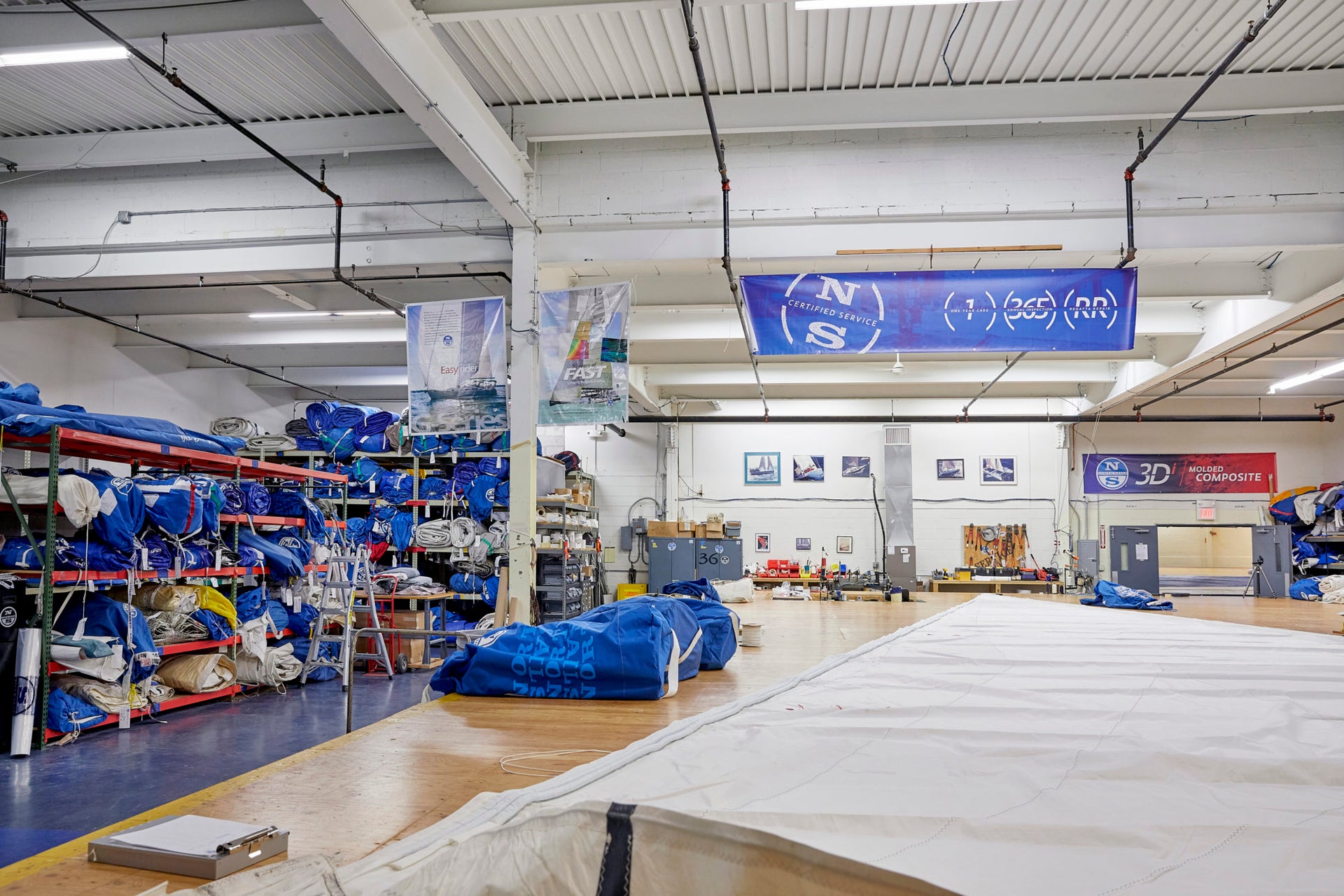
VINTEROPBEVARING OG SEJLPLEJE ER NØGLEN TIL AT FORLÆNGE DINE SEJLS LEVETID
NÅR DET ER TID TIL AT LÆGGE SEJLENE VÆK FOR VINTEREN
Vinteropbevaring og sejlpleje er nøglen til at forlænge dine sejls levetid
Hos North Sails får du selvfølgelig gode råd om opbevaring af sejl. Vi deler vores bedste tip nedenfor for at sikre at dine sejl forbliver i topform til næste sæson.
Med vinterens komme er det at sætte båden på land og pakke udstyret sammen efter endt sæson en del af at have båd her i Danmark. Og at gøre tingene rigtigt er meget afgørende for en god og ubesværet start på den nye sæson til foråret, når det varmere vejr vender tilbage.
Her et par tips baseret på vores egne erfaringer, som du skal huske på, når du forbereder dig på at opbevare dine sejl over vinteren.
Tørre
Først og fremmest skal dine sejl være helt tørre, før du lægger dem væk. Det gælder også for kortvarig opbevaring og er meget vigtigt, når du opbevarer sejlene i længere tid.
Fugt vil tilskynde vækst af skimmelsvamp og mug og forårsage at dine sejl bliver jordslåede.
Soltørring fungerer rigtigt godt, men for meget sol kan give UV-skader.
Læg ikke sejlene væk mens de er fugtige eller fulde af salt. Saltet tiltrækker og bevarer fugt.
Ingen af disse ærgerlige forhold er dækket af producentens garantier for sejl eller sejldug. Efterfølgende rengøring fjerner sjældent alle pletterne fra skimmelsvamp, ligesom rengøring heller ikke kan fjerne afsmitning af farverne i en spiler.
Skimmelsvamp (jordslag) og farveafsmitning er grimt, men det reducerer ikke sejlets performance. Langvarig eksponering af fugt vil dog skade dine sejl mere end blot på udseendet, såsom beskadigelse af limen, imprægneringer og coatingen på og i sejldugen. Fugt kan "hydrolysere" komponenterne i sejldug og kan over tid få sejlet til at gå fra hinanden.
Rene
Som alt andet holder sejl også længere, hvis man holder dem rene. Snavs beskadiger uden tvivl sejldugen - somme tider gennem kemisk interaktion og somme tider ved mekanisk slidtage. F.eks. fungerer tørre saltkrystaller indlejret i sejldugen som små file, der slider på fibre og film. Rene sejl holder længere og performer bedre, især når sejlet bliver ældre.
Så hvordan rengøres sejlene korrekt og effektivt? Til den grundlæggende rengøring, kan de fleste sejl materialer klare en kombination af vand med lidt mild sæbe eller Rodalon, meget blid skrubning med hånden eller en blød børste og rigeligt ferskvand til at skylle med. Og som nævnt ovenfor er grundig tørring efter vask afgørende.
Men er sejlet meget beskidt og jordslået, er mere aggressive foranstaltninger nødvendige for at fjerne pletter. Nogle typer fiber/film/resin er meget robuste og modstår eksponering for kemi og mere hårdhændet håndtering. Andre materialer er mere skrøbelige overfor specifikke eksponeringer. Og så bliver det kompliceret! At fjerne en fedtplet på et vævet dacron sejl er meget forskellig fra at fjerne en rustplet på et laminat sejldug eller skimmelsvamp i et materiale med høj tæthed. Vi anbefaler, at du får en professionel til at rense det du ikke selv kan klare med sæbevand. Hos North Sails samarbejder vi med forskellige firmaer som er specialister i at fjerne snavs og skimmelsvamp. Så lad os se på sejlet, hvis vand og sæbe ikke er nok...
Et par hovedregler, der er vigtige at huske (men langt fra alt hvad du behøver at vide, før du fortsætter):
Vær meget forsigtig med blegemiddel (klorin eller lignende). Nogle plastmaterialer har en høj tolerance overfor blegemiddel (polyester, aka dacron), mens andre straks går i opløsning ved kontakt med små mængder (blegemiddel er meget skadeligt overfor blandt andet Kevlar/Aramid fibre og nylon).
Vær forsigtig med at bruge andre rengøringsmidler end et mildt rengøringsmiddel som opvaskemiddel. Nogle gange kan rustfjernere og lignende gøre det tilsigtede job pænt. Men når den type produkter ikke er egnede til det rensede materiale, kan katastrofen ramme hurtigt (og det kan blive dyrt!).
Sejl til kapsejlads kan rengøres med en simpel skylning med vand og derefter tørre.
Skyl aldrig en nylon spiler i en klorfyldt swimmingpool (ja, det sker desværre ofte).
📸 Michael Egan / Egan Images
Reparation
Et rent sejl er utvivlsomt rart at have - men det er ikke til meget glæde, hvis sejlet kræver reparation for at være fuldt funktionelt. At få foretaget nødvendige reparationer inden vinteropbevaring, er det rigtige at gøre. Det er lidt som "husk at bruge tandtråd hver dag" eller "undgå for meget sukker": det er lettere sagt end gjort. Men det vil betale sig (ligesom at bruge tandtråd og at begrænse indtaget af sukker, selvfølgelig). Sejlvask er en glimrende mulighed for at inspicere og identificere nødvendige reparationer, uanset om du selv foretager rengøringen eller får en sejlmager til det.
Opbevaring
Vi ser desværre mange eksempler på skader påført af mus, når sejl opbevares på loftet eller i udhuset. Så det er vigtigt at vurdere om stedet er sikkert og der ikke kan komme uventet besøg af mus eller andre gnavere, men en god måde at holde mus ude af dine sejlposer starter med rene og tørre sejl. Sørg for at der ikke er salt på dine sejl eller sejlposer (dette er også et godt tidspunkt at fjerne salt og snavs fra lynlåsene). Hvis du ruller og pakker dine sejl på din græsplæne, skal du sørge for, at der ikke er blade eller græs i de foldede sejl. Opbevar dine sejl et sted, hvor små dyr ikke kan nå dem. En spiler er særligt attraktivt for gnavere, da det både fungerer som et måltid og godt redemateriale. Hvis muligt kan man hænge sine (rene og tørre) spilere fra liner fastgjort til loftsbjælkerne i sin kælder eller garage i stedet for at lade dem ligge på en hylde eller på gulvet.
Kontakt os, hvis du har spørgsmål om opbevaring af sejl!
📸 Urban Haglin
READ MORE
READ MORE
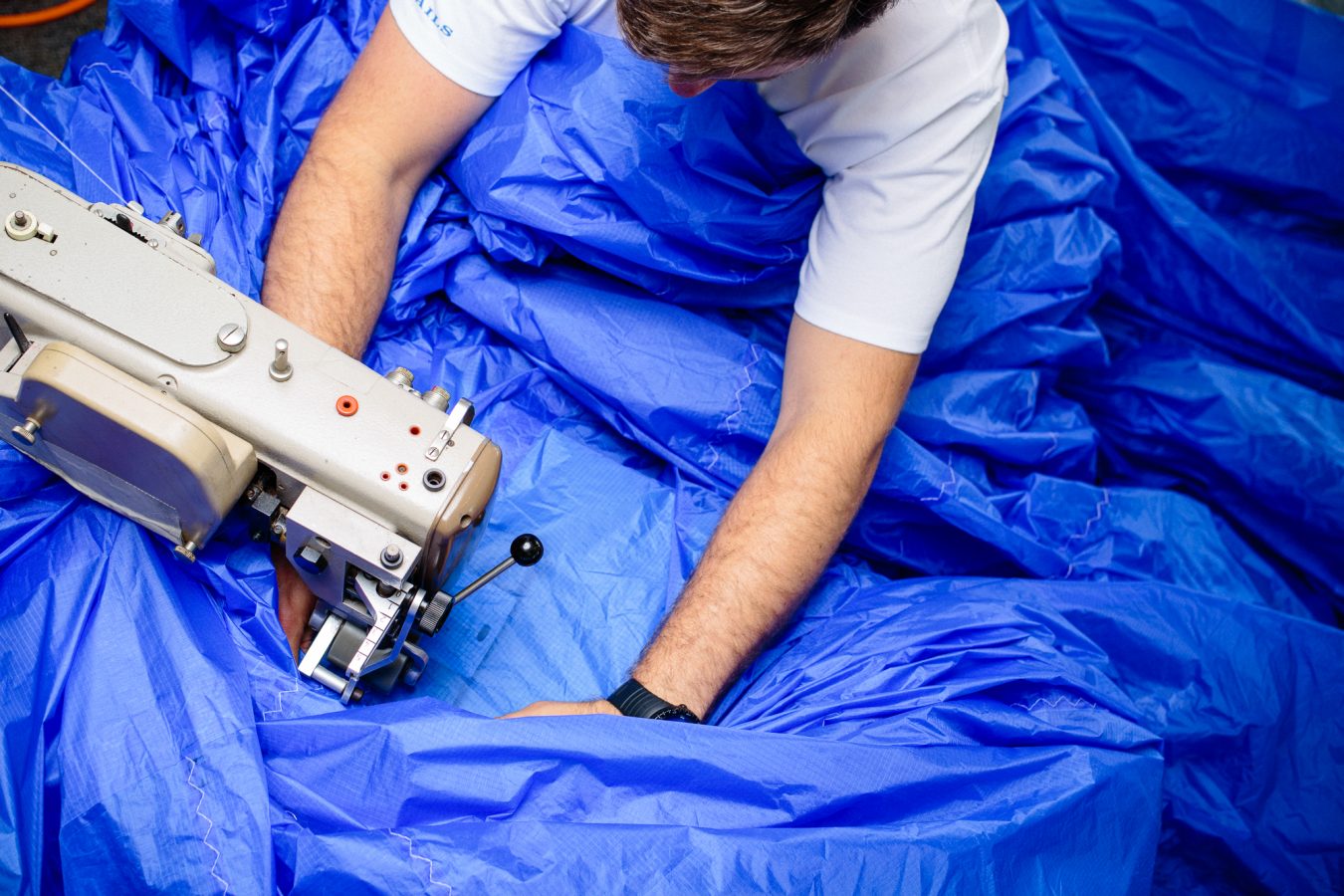
VINTEROPBEVARING AF SEJL I TRE LETTE TRIN
VINTEROPBEVARING AF DINE SEJL
Opbevaring af sejl i tre lette trin
Følg disse 3 enkle trin for at sikre dine sejl for vinteren:
Tør sejlene
Fold sejlene
Opbevar sikkert
Tør sejlene
Vær omhyggelig med at dine sejl er helt tørre, inden du pakker dem væk for vinteren.
Dette forhindrer vækst af skimmelsvamp og mug samt forhindrer dem i at lugte muggent om foråret. Skulle uheldet være ude og dine sejl er blevet jordslåede, kan du bringe dem ind til vask. En professionel vask dræber skimmelsvamp og mug og fjerner alt, der ikke allerede er indlejret i sejlet, og stopper dermed fremtidig vækst af skimmelsvamp.
Fold sejlene
Fold forsigtigt dine sejl, inden du opbevarer dem og forsøg at undgå at folde sejlet i de “gamle” folder, for at forhindre at disse folder sidder hele vinteren. Hvis du har mulighed for det, anbefaler vi at du ruller dine sejl.
Opbevar sikkert
Hvor du opbevarer dine sejl, er lige så vigtigt som hvad du gør, inden du lægger dem væk. Overvej følgende, når du vælger din placering:
Skadedyr: Små dyr elsker at bo i et sejl om vinteren. De vil heller ikke tøve med at tygge sig igennem dine sejl, for at gøre sig det endnu mere mageligt. Sørg for at opbevare dine sejl et sted, der ikke er tilgængeligt for gnavere og andre skadedyr.
Fugtighed og temperatur: Opbevar sejlene på et tørt sted, så de ikke akkumulerer fugt hele vinteren. Et temperaturreguleret område er også en god idé. Efterlader du sejlene på din båd, anbefaler vi at du har en affugter kørende hele tiden.
Sørg for at sejlene ikke ligger oven på hinanden da de kan få pressefolder som kan være svære at komme af med igen.
READ MORE
READ MORE
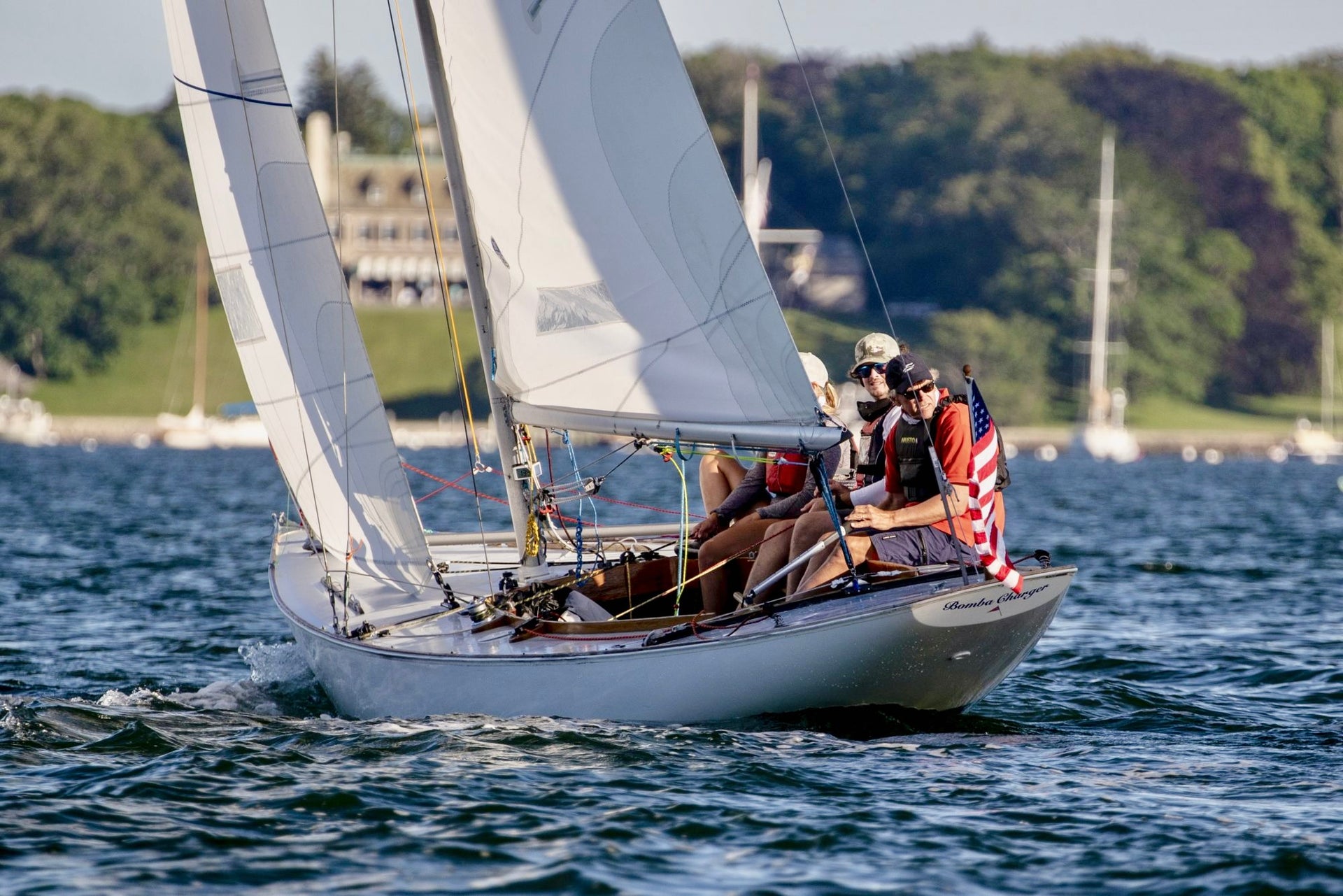
HE SAILS SHIELDS BY THE SEASHORE
HE SAILS SHIELDS BY THE SEASHORE
Longtime North Sails Expert Mike Toppa Doing What He Loves
What’s better than racing an immaculately prepared yacht in Sardinia? According to Mike Toppa, it might just be racing his 50 year old Shields on Wednesday night in his home town of Newport—especially this year, when the Nationals are on his home waters.
“It’s the best racing!” he says. “We’ve got Narragansett Bay to ourselves; great sunsets, fantastic conditions… and really good competition, because the best sailors in Newport are out there. And the bonus for me is that I get to go out with my family and friends, which is a lot of fun.”
The Nationals are a much different challenge than a few hours of midweek racing inside Narragansett Bay, he admits. “We’re racing outside in Rhode Island Sound, in more wind. The waves are bigger, and it’s three consecutive days. So both the gear and the people get tested.” Toppa signed on his regular Wednesday night crew for the regatta: daughters Holly and Alie, son-in-law Jeremy Wilmot, and Suzy Leech.
Though he’s only had his current boat, Bomba Charger, for four years, he first sailed a Shields as a young teenager. He was a sophomore in college the only other time he sailed the Nationals however and that second place finish still hurts. “Jerry Kirby and I had a boat together. It was really windy, and we were sailing outside.”
On the final day, they were winning the regatta on the last run down to the finish. “The boat was full of water, so we started bailing with two buckets. But luck was not on our side, first we lost one bucket over the side, and then quickly lost the second as well. At which point the boat behind us surfed right by and won the race. That win gave them the point then needed to beat us and win the whole event! Not gonna make that mistake again” Mike says laughing
Leading up to the 2022 Nationals, Toppa has spent several days going over all of the boat’s equipment. “I wanted to make sure everything was rock solid, ready for 20 knots and big waves. We checked everything; running rigging, equipment, attachments—and I also made sure we’d be able to keep the water out. That last Nationals is an old memory—but still stings”
North Sails is well-represented throughout the fleet, including Will Welles, Mike Marshall, Tim Dawson, Will Bomar, and Jeff Hayden. “Jeff won the Nationals last year, with Robin Monk,” Toppa says. “Seems like every boat he gets on goes faster.” And Mike Marshall has done a lot of work on the sail designs for the class, he adds. “We actually have a new test spinnaker that we built over the summer and will be looking at next week, which we’ll make available to the class for 2023. ”
One reason the class is still around and thriving, Toppa insists, is that the national association does a really good job keeping down costs with the class rules. “You can only buy one sail a year, and every sail has to have at least 10 races on it prior to the Nationals. Most replace either a main or jib every year so spinnakers get tired. Hopefully this new design is a good one.”
Asked to name a favorite to win this year’s Nationals, Toppa would only express hope that the winner will be from Fleet 9. “We honestly haven’t been sailing super consistently this summer. And there are lots of other previous National champions in our fleet.”
As for that immaculately prepared yacht in Sardinia…Mike’s travels to the Rolex Swan Cup 2022 conflict with the final day of the Shields Nationals, so daughter Alie will take over as skipper. “She has a second and a fourth driving Wednesday nights so far this summer,” he says proudly. “So at some point, I’m sure I’m going to be holding a clipboard for her. I just love to race sailboats! Even though I am lucky enough to have done so many regattas in so many different types of boats— there is something super special about doing it in your own backyard with your family. It is hard to beat”
📸 Stephen Cloutier
READ MORE
READ MORE
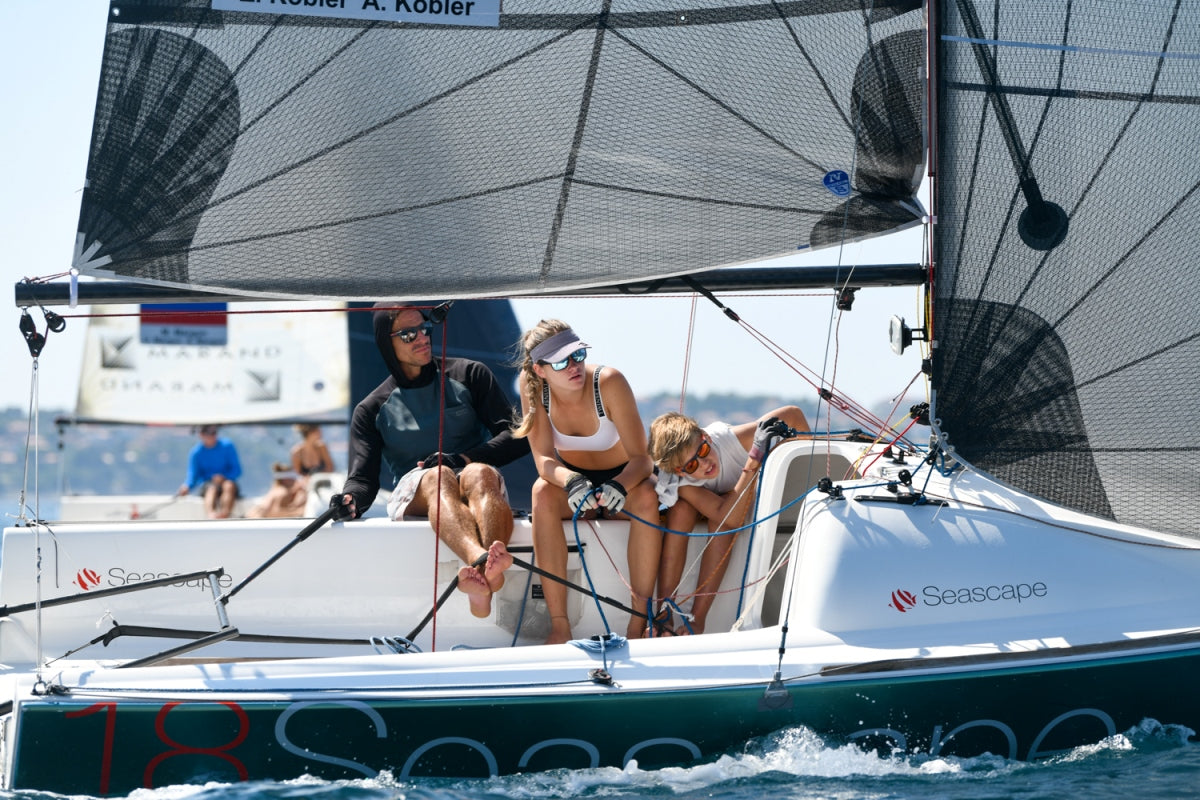
EUROSAF FIRST 18 SE EUROPSKO PRVENSTVO
EUROSAF First 18 SE Europsko prvenstvo
📸 Ana Šutej - Seascape
JK Piran iz Portoroža u suradnji s brodogradilištem Seascape organizirao je ovogodišnje Europsko prvenstvo za klase First 18 SE i Seascape 18. Bio je to povratak u akvatorij u kojem su zajedrile prve jedrilice iz ovog škvera, a ovo veliko natjecanje na Europskoj razini obilježilo je ukupno 28 posada.
Prvenstvo je organizirano između 23. i 27. kolovoza, a posebnu draž dala je obiteljska grupa u kojoj su sudjelovale posade u kombinacijama otac i sin, otac i kćer, bračni partneri... a na kraju prvog dana i tri održana plova prve dvije pozicije držali su obiteljski timovi!
Jedrenje u Piranskom zaljevu proteklo je po vrlo lijepom i sunčanom vremenu i umjerenim vjetrovima.
📸 Ana Šutej - Seascape
Prva dva dana puhala je bura koja je osigurala da se svakodnevno odjedre po tri plova. Trećeg dana regate odjedrila su se još četiri plova po laganijem, ali znatno stabilnijem vjetru, dok su na kraju posljednjeg dana dodana još dva plova u finalni skor.
Ono što posebno veseli dobri su rezultati North Sails klijenata koji su i ovog puta pokazali da je suradnja s North Sailsom izvrstan recept za maksimalan užitak na regatnom polju.
📸 Ana Šutej - Seascape
Kompletne rezultate regate u Sloveniji možete pronaći na ovom linku.
READ MORE
READ MORE
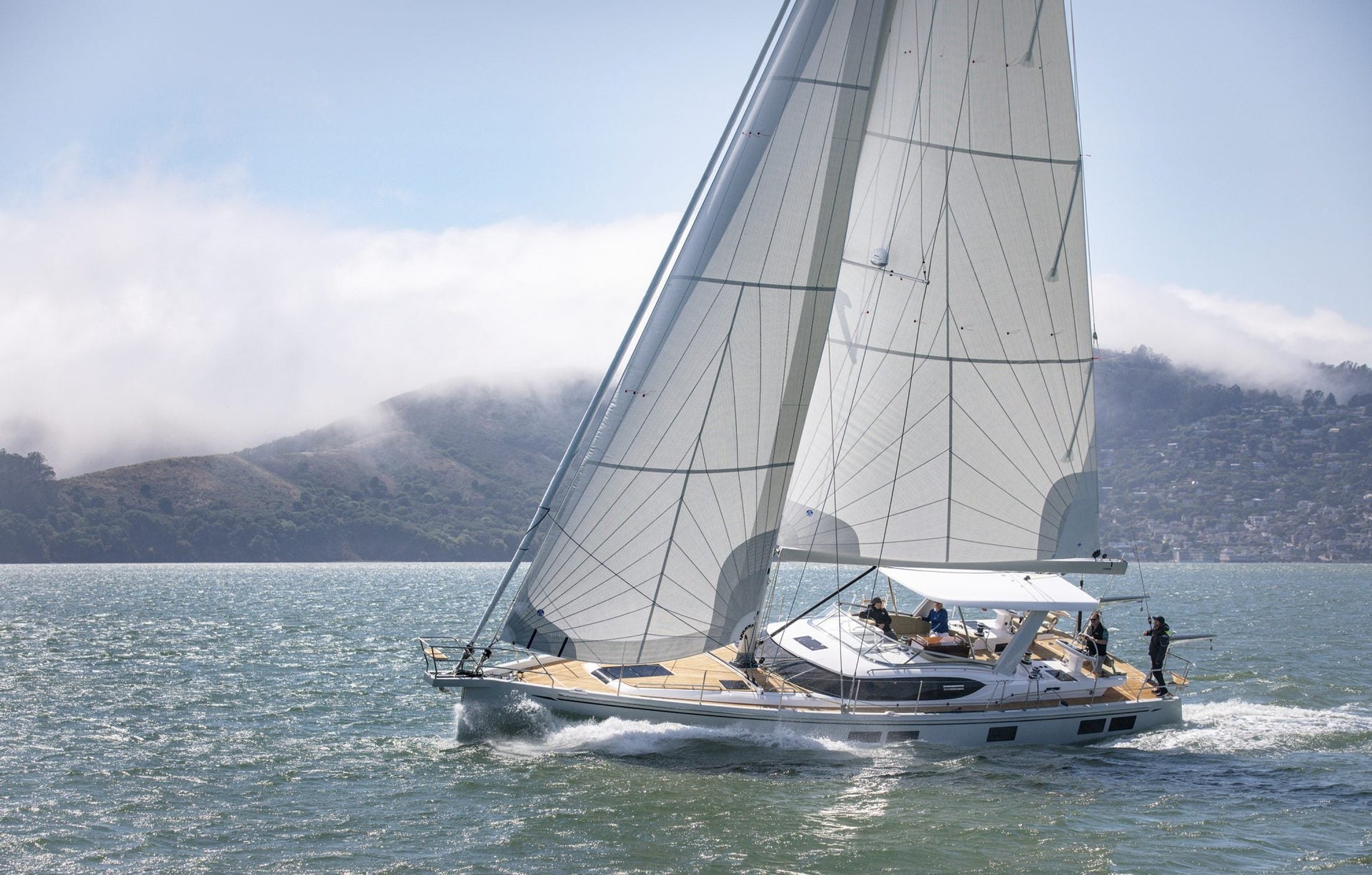
BETTER TOGETHER: NORTH SAILS & HYLAS YACHTS
BETTER TOGETHER: NORTH SAILS & HYLAS YACHTS
Pushing The Boundaries For Cruisers
© Hylas Yachts
Building a strong partnership in 2021, North Sails and Hylas Yachts are focused on delivering the best cruising experience for sailors both on and off the water. Through continued innovation, teamwork, and cutting edge technology, sailors can expect nothing but the best from both. Bob Meagher, North Sails expert out of the Ft. Lauderdale loft of North Sails, checks-in with Peggy Huang of Hylas Yachts on the latest happenings.
The design philosophy and commercial success of Hylas Yachts has been transformed in the last few years. Can you tell us a little bit about this philosophy that’s governing the design of the boats in your business practice in general?
Although the latest Hylas H57 design certainly appears to revolutionize what we do, that's not really the case. Our primary goal continues to be the same - to build luxurious, safe, performance cruisers capable of transoceanic voyages. It's really an industry-wide technological evolution that is allowing us to enhance every aspect of what we do. From the hull construction to some lifestyle game changers, the key is to be willing to make changes that are appropriate to meet the needs of our increasingly sophisticated and knowledgeable clients. In the same way, North has developed the 3Di range, sail construction with as many advantages for our cruising clients with furling systems as it does the America’s Cup. Why would we not want to share this development?
It seems to be paying off! Most recently the Hylas 57 won Sail Magazine's "Yacht of the Year," on the heels of the Red Dot Award as Best Product Design 2022, “Best in Show“ Newport International Boat Show 2021, “Best Boat of the Year” Cruising World Magazine 2022, ”Best Systems” SAIL Magazine 2022. Did we miss any of them?
Hylas has never been a stranger to winning industry awards and we would be remiss if we didn’t mention folks like Frers, Dixon and more recently Salthouse as designers. Another important part of the mix is our partners which include yourselves at North. We particularly benefit with the consultative style approach you guys take that has been developed over the years. Industry awards have to be objective and focus on comparisons. This certainly isn’t a bad thing and it helps us tremendously from a marketing point of view. What is far more important to us is client satisfaction. We don’t have huge production capability so word of mouth is where we really see the benefit.
Can you tell us a little about why you chose North Sails to partner with?
We look for partners that are not only aligned with our own core values of quality, consistency and service but also embrace cutting-edge technology as a way of ensuring continuous improvement. I don't believe there is a Hylas owner out there that doesn't know who Peter Grimm is, and if they don’t they should make an effort to get to know him. Peter and the team at North are a very important part of why we continue to be successful. I mentioned the importance of a "consultative approach" when dealing with our clients. We genuinely enjoy introducing prospective clients to our sail team as you will always stay focused on their best interests and not the need to "up sell." I think a lot of credit should go to someone at North that allows the largest sail manufacturer in the world to provide such a highly personalized service. To learn more about North Sails sail inventory options for Hylas Yachts or similar boats, connect with Peter Grimm Jr. or Bob Meagher of North Sails Ft. Lauderdale.
© Hylas Yachts
READ MORE
READ MORE
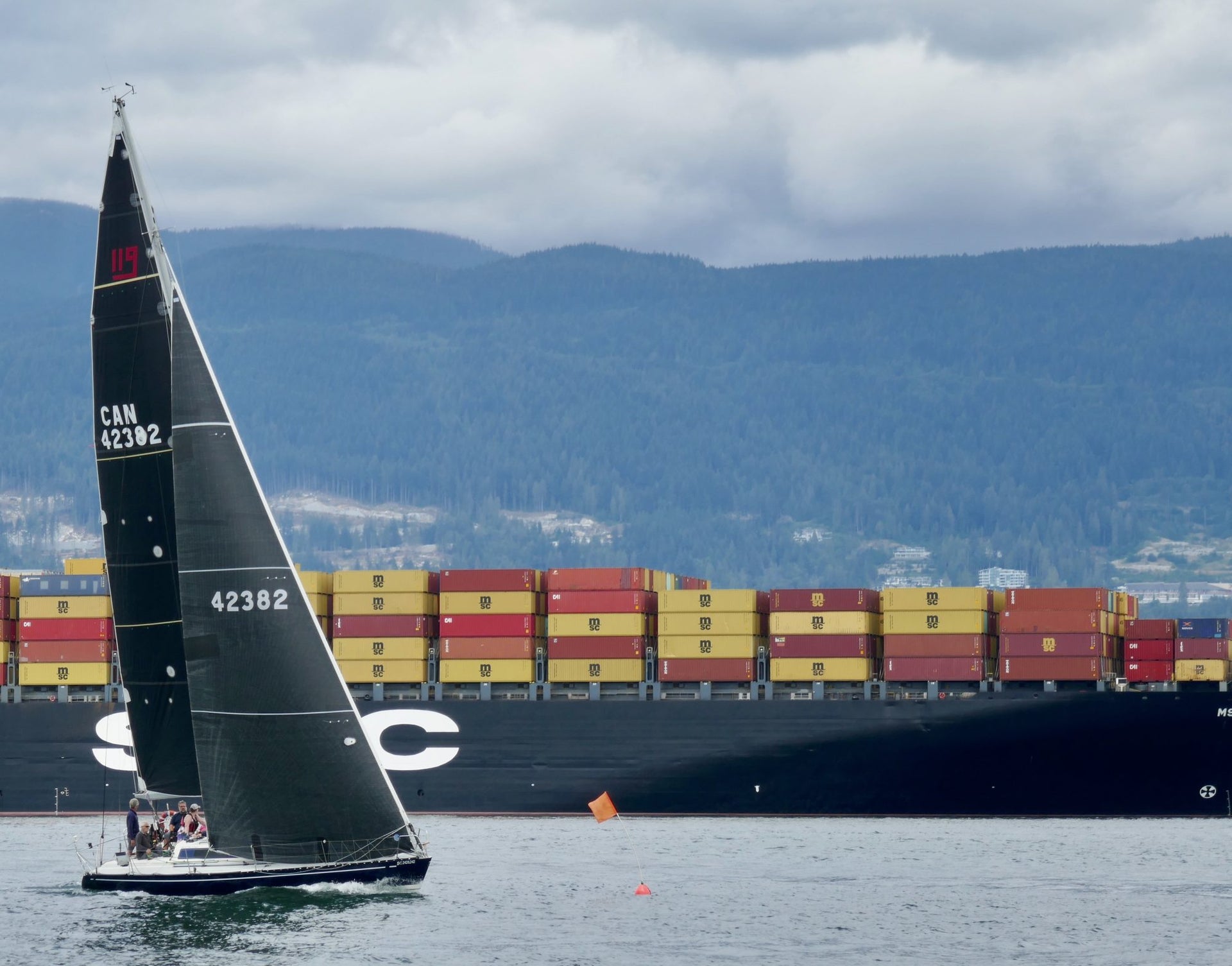
EVENT SPOTLIGHT: ENGLISH BAY SCRAMBLE
EVENT SPOTLIGHT: ENGLISH BAY SCRAMBLE
Strong Current And Unpredictable Breeze
The English Bay Scramble out of Tiddly Cove Yacht Club is an annual tradition where "tacticians have free-reign in how the marks are rounded, even which way to cross the start line." The race this year saw intense current with the river west of the Lion’s Gate bridge running hard and 7-8 knots of wind offshore at the start, slowly easing throughout the day and with some notable holes. Krikkit, an Abbott 36, shares their experience of the strategy based race. For us, the holes came early at the Kits Barge Buoy, which we did first, and then late at the back of Passage Island, which we did last. We spent a long time there, but got free entertainment from a live reggae band playing on someone’s deck for their 50th birthday. Going inside first then outside seemed to be the paying move, Diva won overall with the same course as us, although it sure didn’t look that way at first. Halfway through the race it looked liked we'd really pooched it, because the boats that had gone outside first had been able to keep moving much better than us, and were returning past the Bell Buoy before we’d even got out that far. That said, as the afternoon wore on the flood current built and the wind was easing starting from the east. So while we were able to come in from Passage with favourable current and still-reasonable breeze; the boats that had gone outside first were trying to buck back to the start/finish against about 2 knots of current in rapidly-diminishing breeze. As Krikkit approached the S/F about 300 yards out, we saw Jasmina coming the other way under spinnaker, and about the same distance from the S/F. While we got pushed over the line doing 4.5 kts SOG (2.5 kts boatspeed + 2 kts current), Jasmina was essentially running in place and started going backward as the wind fell off further. They didn’t actually get to finish until an hour after us, when an 8 kt breeze kicked back on for a bit. The steadily-diminishing breeze also meant that the faster boats had a definite overall advantage. Still, the weather was generally pretty splendid, and a good time was had by everyone. A big thank you to the North Sails team at the Vancouver loft for their support of our annual race.
READ MORE
READ MORE
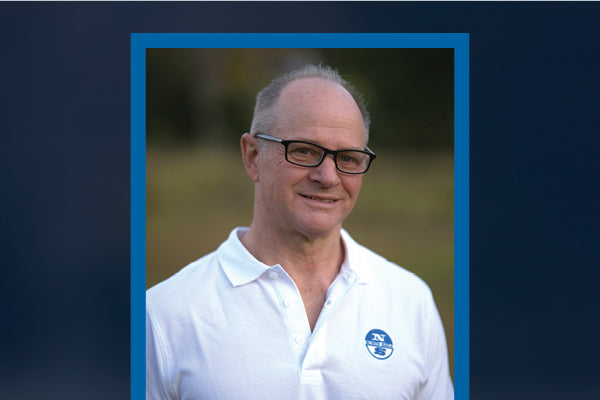
DESIGNER ROBERT "HOOKY" HOOK JOINS NORTH SAILS
NORTH SAILS ADDS ROBERT HOOK TO THEIR DESIGN TEAM ROSTER
Hooky Brings Decades Worth of Grand Prix Experience
North Sails is excited to announce the addition of Robert “Hooky” Hook to our sail design team. Hooky, who started his career with North Sails and the America’s Cup in the 80s, brings a wealth of sail design experience and team-building leadership. Working closely with the North Sails design team worldwide, Hooky’s work is focused on Grand-Prix Inshore and Offshore sailing and supporting a handful of high-profile projects.
A self-described hands-on designer, Hooky has a strong track record of helping programs get to the top of the podium. From his early days as a sail designer with Australian America’s Cup syndicate Kookaburra III, Hooky committed himself to win the Auld Mug and achieved this goal in 2010 as part of the BMW Oracle Racing team. Additionally, Hooky has also been involved in three ‘Round the World’ races. His resume boasts back-to-back victories with Paul Cayard’s EF Language campaign, followed by John Kostecki’s Illbruck program.
“The America’s Cup and similar event-style campaigns are unique training grounds because an entire team, from sail designers to accountants, and all players in between, are committed to building the fastest thing on the water,” explains Hooky. “It’s a high-pressure, fast-moving team environment that pushes everyone to work to the best of their ability. Beyond the competition, these events are also a master class in teamwork and managing people while keeping everyone focused on the end goal. And this is something I look forward to continuing as part of the North design team.”
“Adding Hooky to the team ensures North Sails can deliver the highest quality performance and best possible aerodynamic solutions,” explains JB Braun, North Sails Head of Design and Engineering. “The demand for talented and progressive sail designers continues to grow as boats get larger, foils become more common, and yacht designers get more aggressive in pushing the limits of what’s possible. Hooky will be instrumental in accelerating the development of our next generation of North sail designers. He knows what it takes to be a part of a successful team, and we’re excited he’s back in the game with North Sails.”
“Whether we’re working with an RC44 program or a 100’ ocean racing machine, every client has different goals, and they each require a unique approach,” comments Paul Westlake, North Sails Executive Vice President, and Grand Prix Sales Leader. “As an organization, North Sails is designed to provide the resources and products for end-users to achieve their goals. Our design team sits at ground zero of that pipeline, both in the office and on the water.”
Hooky is based in Queensland, Australia. In the coming months, he’ll assist big-name projects like Hamilton Island Wild Oats XI, and Blackjack as they gear up for the Rolex Sydney Hobart Race 2022. He’ll then turn his attention to the RC44 circuit, a class where he already has a strong connection. He will support both the design office and on the water during the 2023 season.
Hooky’s support of the RC44 class and the overall addition of such talent to the already strong design arsenal of North Sails cannot be overstated. Join us in welcoming Hooky to the North Sails team.
READ MORE
READ MORE
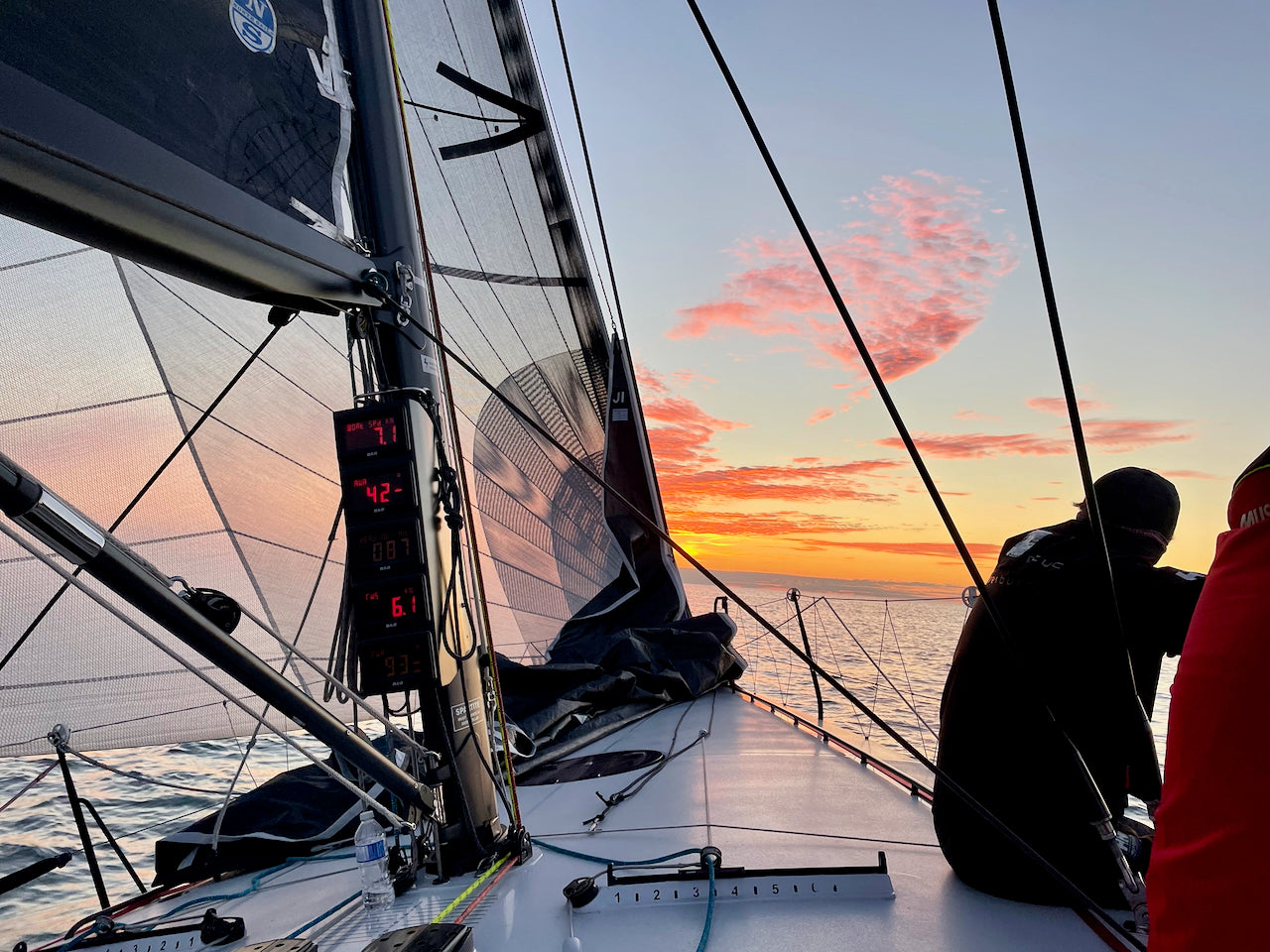
EVENT SPOTLIGHT: RACE TO KINGSTON
EVENT SPOTLIGHT: RACE TO KINGSTON
A New Tradition
In its inaugural debut, Race to Kingston challenged racers’ determination and patience skills thanks to less than stellar winds, lots of sun and pockets of no breeze. That said, racers had fun, which was the main goal for this new race. Afterburn took line honours, finishing on Sunday evening just before 5pm, followed by Sea Yea and Sabotage. KYC members eagerly greeted boats and welcomed them to sunny Kingston after their 145 NM journey. The next group of boats started arriving late Sunday night and into Monday morning, with Ovation wrapping things up around 8am. With such light conditions, code zero’s were a favourite choice among many boats. The Sabotage crew, consisting of North Sails designer Phil Williamson and North Sails experts Doug Folsetter and Daniel Sheedy, say their two key sails were their Helix Code Zero and A1. Phil Williamson shares, “We sailed to the optimal angle of our sails. Keeping the boat moving as fast as possible was our primary goal even if it meant sailing away from our target course by 15 degrees. We had two workhorse sails. The first being our Helix Code Zero and the second being our A1. We used these sails for 95% of the race.” Let’s not forget, the crew saw 1 knot of wind as they crossed the finish line and could not be happier to see land; especially after numerous sail changes. Owner and North Sails expert Doug Folsetter details, “While the course seemed straight forward, there were plenty of challenges, not the least of which were the light air and navigating shoals and various obstructions in the harbour. Keeping the boat moving down the course was key. We made 17 sail changes in an effort to do so. If you missed out on attending, put the race on your calendar for next year. I hear they’re promising more wind and plenty of good times once you arrive!” North Sails expert Hugh Beaton onboard Afterburn shares, “Creating and maintaining apparent wind was critical to obtaining any significant boatspeed. Our Helix Code 75 would allow us to sail at 8 knots in 6-7 knots of wind with the apparent wind angle at 45-50. No other sail combination came close to offering the same sustained speeds and ease of staying at full speed. Of course we stopped a few times and waited until the SW breeze filled in around 3:00 am. Great effort by the two host clubs and we are looking forward to doing it again next year” Sea Ya took first overall for the entire race and first in their division on corrected time. Isley, a Saffier 37, double handed the race taking third in FS DH with North Sails expert Mike Wolfs alongside Stuart Bruce. Finishing just before them in second was the father and son duo aboard Rum Kist, well done Max! With his new 3Di raw sails, Peter Rowe of Restless, had another tremendous showing, taking first in his division of NFS CD. It was wonderful to see so many racers out supporting a new distance race and having fun in downtown Kingston. A special thanks to Mimico Cruising Club and Kingston Yacht Club for hosting the inaugural race; as well as all the volunteers who helped. We hope to see everyone out on the line again next year!
READ MORE
READ MORE

BRIAN JANNEY: A MONTH IN THE LIFE OF A NORTH SAILS EXPERT
BRIAN JANNEY: A MONTH IN THE LIFE OF A NORTH SAILS EXPERT
Here, There and Everywhere
Most offshore sailors consider it a successful summer if they fit in one major distance race—especially if they make it onto the podium. In July, Brian Janney, North Sails San Diego, managed to cram three major victories into one month—and all without losing his sense of humor. First, the sought-after trimmer and North Sails expert helped Pyewacket 70 win line honors in the Pacific Cup. Only a few days later, he was onboard Bill McKinley’s Denali3 when they won their class in the Bayview-Mackinac Race. Less than a week after that, Janney helped Denali3 win her class in the Chicago-Mackinac Race.
“It all started with a week of training in San Francisco before the Pacific Cup,” Janney explains, shortly after returning home from his 30-day offshore trifecta. “I've been working with Pyewacket for a long time, and we did Transpac in five and a half days last year.” They also set a 24 hour record. “And Pac Cup is a shorter race than Transpac, mileage-wise...”
Pacific Cup Line Honors
Predicting their finish time in the Pac Cup became crucial when Bill McKinley asked Janney if he could make it to the Great Lakes in time for the two races to Mackinac. “I knew it was going to be tight, with only a two or three day window for travel. But I said yes. I was hoping I could maybe get 24-48 hours in Hawaii—maybe even get my feet wet. Turns out that was wishful thinking.” Instead, thanks to a “weird weather system in the Pacific,” Pyewacket’s line honors victory took a full six days shutting the door on any R&R in Hawaii. “The Denali3 team said they were watching the tracker like crazy.” he laughs.
Only a few hours after the finish in Hawaii, Janney jumped a redeye back to San Diego. “I guess I was really tired, because I fell asleep before takeoff and didn’t wake up until we were actually landing. ” But he gathered his bags and headed home, where he had just enough time to repack. “I had to take all the Pyewacket gear out, put the Denali3 gear in, go back to the airport, fly all day to Detroit.” After an hour’s drive to Port Huron, he fell into a hotel bed at 2am. “And then we started the Port Huron to Mac race at 1pm that same day. My body didn't know what timezone it was in!”
Bayview-Mac: Class Victory
The Denali3 crew was obviously happy—and a little surprised— that he made it in time, Janney continues, adding that he felt a little bad about his lack of preparation. “I was one of the watch captains and helped with tactics, but I didn't have time to wrap my head around the weather and make a solid plan. Fortunately it was a light air race, so nothing too crazy. We never actually saw the wind speed drop to zero, but we sure did get close a couple times.”
The 280 mile race took the Ker 46+ 48 hours to complete. “We were definitely the small boat, in the same class with all the TP52s and Great Lakes 70s. When we won, the owner was pretty happy.” But they had barely tied up to the Mackinac dock before it was time to head offshore once again.
“I said I’d help deliver the boat down to Chicago” in time for the next weekend’s race, Janney explains, because there wasn’t enough time to fly back to San Diego. “And as soon as we got to the island, the boat captain says, ‘Hey, there's weather coming in. If we don't leave right now, we're gonna get our teeth kicked in’. So we didn’t even get a shower or a proper meal, just took off. By that point, I was pretty much eight days straight on a boat. And it's another two days down to Chicago.”
Chicago Mac: Storm watch
Janney did finally get two nights sleep in a Chicago hotel room, before starting the Chicago-Mackinac Race. “The boat captain for Denali3 does a really nice job, and the boat was totally sorted out,” so he focused on weather homework. “It was a pretty bad forecast,”he admits, “and it actually came true. Chris Bedford predicted hours of thunderstorms overnight, and he was very honest with us; the models had a hard time resolving how much wind there was going to be, or from what direction.” Based on what they knew, the team decided to head north as fast as they could after the start—even though the heading to Mackinac was northeast. “We basically went up the west coast of Lake Michigan.”
Despite this plan, they couldn’t escape the bad weather that night. “The storm ended up being about 200 miles north to south, and Lake Michigan is 300 miles long, so it pretty much covered the entire race area. We got hit pretty hard. I saw the wind speed hit 38, and it may have been higher; there was so much rain and the drops hurt, making it hard to look at the instruments.”
For more than two hours of constant thunderstorm cells, Denali’s navigator watched the radar and counted down to each one for the team. “There really wasn't an opportunity to dodge them,” Janney says. ”We had talked prerace about taking all our sails down - covered every scenario, just in case - because we knew it could be anything.” But they were able to keep up a reefed main and J4, while focusing on safety and trying to minimize the chance of damage.
Less than a week after their previous win to Mackinac, they again saved their time on the bigger boats in their class and also finished second in their division. This time, Janney was able to stay a few days and enjoy the island and several nice crew dinners, before flying home for a well-deserved rest.
Inventory Refinements
Though he’s still trying to recover from jetlag and numerous freeze-dried meals, Janney’s really excited about the refinements they made to each boat’s race-winning sail inventory. Pyewacket has a triple-headsail setup, and on last year’s Transpac they’d discovered that the Helix A3 increased VMG by about seven percent compared to the A2, because it was flatter and more forgiving to steer to in ocean waves. This year, they rigged an aft outrigger near the steering wheel and used that to pole out a big masthead genoa they call the MH0, short for Mast Head Zero. An even flatter sail than the A3, it turned out to be another six percent faster. “There’s a negative hit on the rating for the outrigger, but we got credit for being non-spinnaker. I think if we were to do another Transpac, we would keep this setup.”
Pyewacket only had one other new sail for the race, an offshore spinnaker staysail. “Putting that sail up allowed us to use our genoa staysail as the third sail,” Janney says, adding, “On these bigger boats, sails last a long time.”
Denali3 has a new Helix J1 this year that was perfect for the light-air Bayview-Mac. “Bill keeps his inventory quite fresh,” Janney says, with many new Helix sails. “Using a Helix upwind sail helps it cover a higher wind range. We left the J2 on the dock.”
For the heavier air Chicago-Mac, before and after the big storm, Denali3 carried what Janney calls an A2 plus. “We've learned that for offshore sprit boats, an A4 is too big and round and it gets hard to drive. The A2 plus is flatter in the head with a straighter luff curve, which makes the sail more twisty. When you're planing in bigger breeze, you can steer the boat and the kite doesn't want to collapse. It’s definitely a more forgiving sail, and we make it out of heavier cloth so it will carry up the wind range.”
No trouble
Back home again, Janney is settling back into “normal” life and already looking forward to some local racing—and this year’s Big Boat Series. He’s also been enjoying the compliments he’s received from both clients and fellow offshore experts. “I got a text message from Ken Read saying ‘nice work!’,” he says, before adding with a laugh, “So I don’t think I’m in too much trouble, even though I was away so long.”
READ MORE
READ MORE
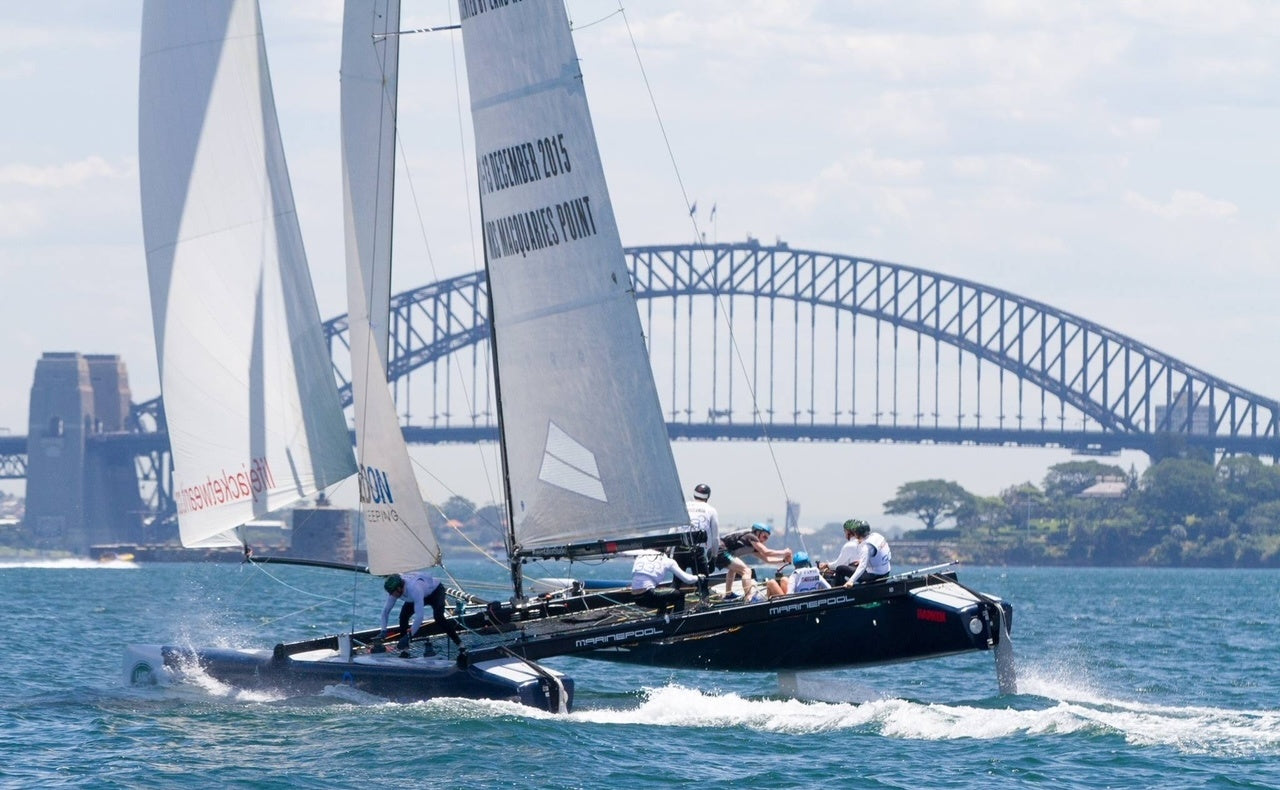
WHO WE ARE: KATIE SPITHILL
WHO WE ARE: KATIE SPITHILL
Get to Know North Sails Sydney’s New Office Manager Katie
📸 James Whelen
How long have you been sailing and what classes do you compete in?
I was born into a sailing family, living in Elvina Bay on Pittwater in NSW, so with boat access only I was sailing from about 5 years old. I started out in the traditional centreboard classes of Manly Junior, Flying 11, 420 and then onto the 29er. I then joined the Royal Prince Alfred Yacht Club Youth Development Program and went on to have a strong Match Racing career as part of the Australian Women’s Match Racing Team. I was then introduced to offshore yacht racing, One Design racing and later multihulls alongside my now husband. The fastest boat I have raced on so far has to be the Orma 60 Trimaran 'Team Australia'.
What boats/classes do you sail?
Currently I race an F16 Viper with my husband, as well as MC38's and onboard the superyacht SW98, Ammonite. In my spare time I love to get out Wing Foiling, or squeezing back into the Manly Junior with my kids.
What got you into the marine industry?
I was destined to work in, around or near boats! When I finished school I started a traineeship with Australian Sailing (the national sailing body for Australia), before moving on to work for Harken, then Royal Prince Alfred Yacht and now, North Sails Australia.
What’s your favourite thing about sailing?
My favourite thing about sailing would have to be the diversity of age and gender across the sport, and the inclusive community that comes with it. While traveling the world for events, I have met lifelong friends in many countries. I also love the fact that I can race on the weekends with both my children and my parents.
What are you most looking forward to with joining North Sails?
I am excited for the opportunity to learn more about the science and design of sails. As well as meeting more fantastic people in the sailing community.
What would you say is your career highlight?
My career highlight is a tough one, but there are a few that are at the top of my favourites list.
1) Winning Match Cup Sweden which was a Women's Grade 1 Event
2) Reaching World #2 Ranking on the Women's Match Racing Circuit
3) Steering an Extreme 40 as part of the Extreme Sailing Series
4) Placing 2nd overall in the 2019 Rolex Sydney to Hobart Yacht Race onboard Wild Oats X as part of the all female Ocean Respect Racing Team.
Anything else about you?
I have two kids who are currently four and nine years old, and we spend most waking moments when not at kindy, school or work, either on, around, or in the water and enjoying the beautiful waterways we are lucky enough to live near!
READ MORE
READ MORE
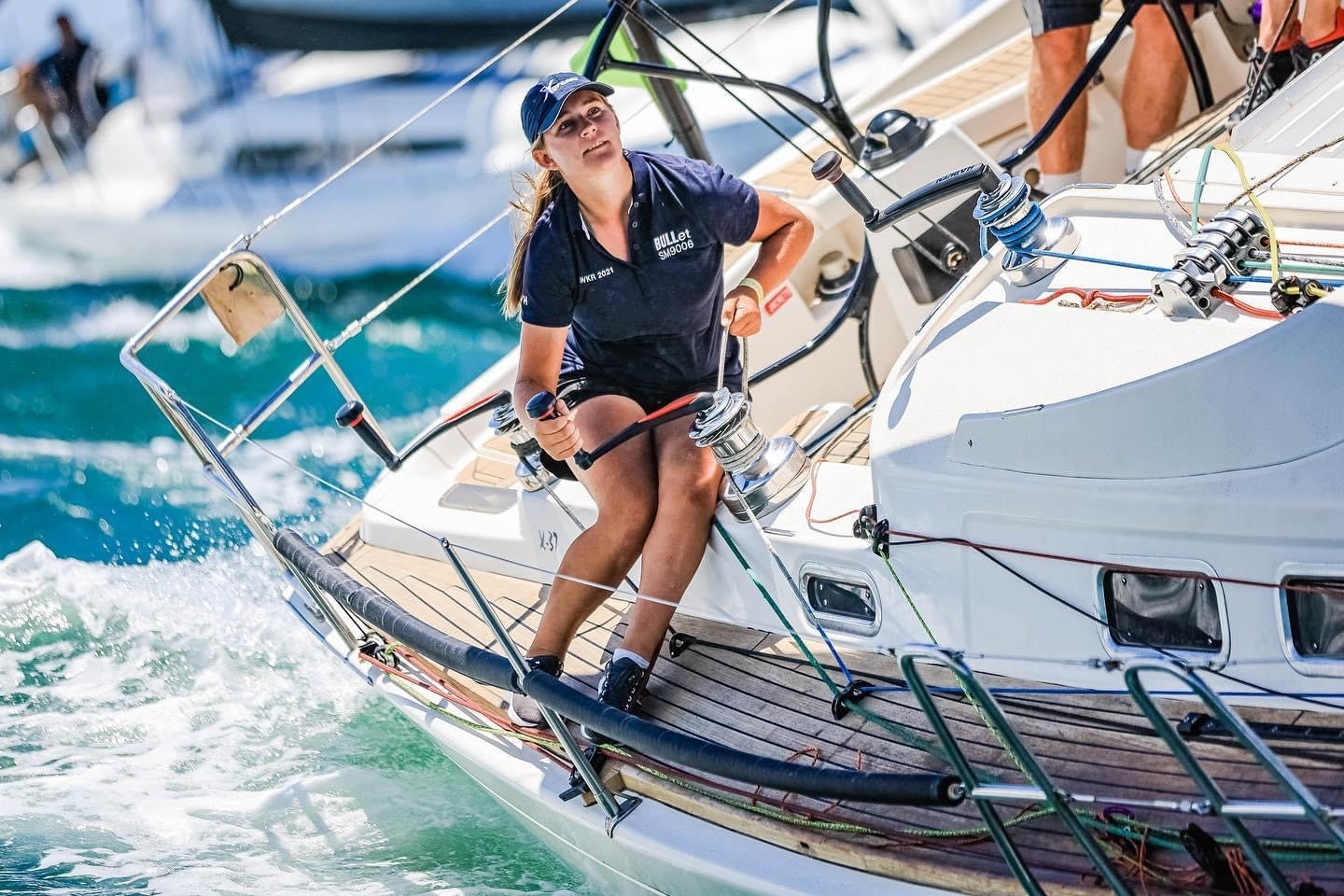
WHO WE ARE: RAIN FORBES
My passion for sailing grew and I was hungry for knowledge, so a friend suggested I look into being a sail maker.
READ MORE
READ MORE
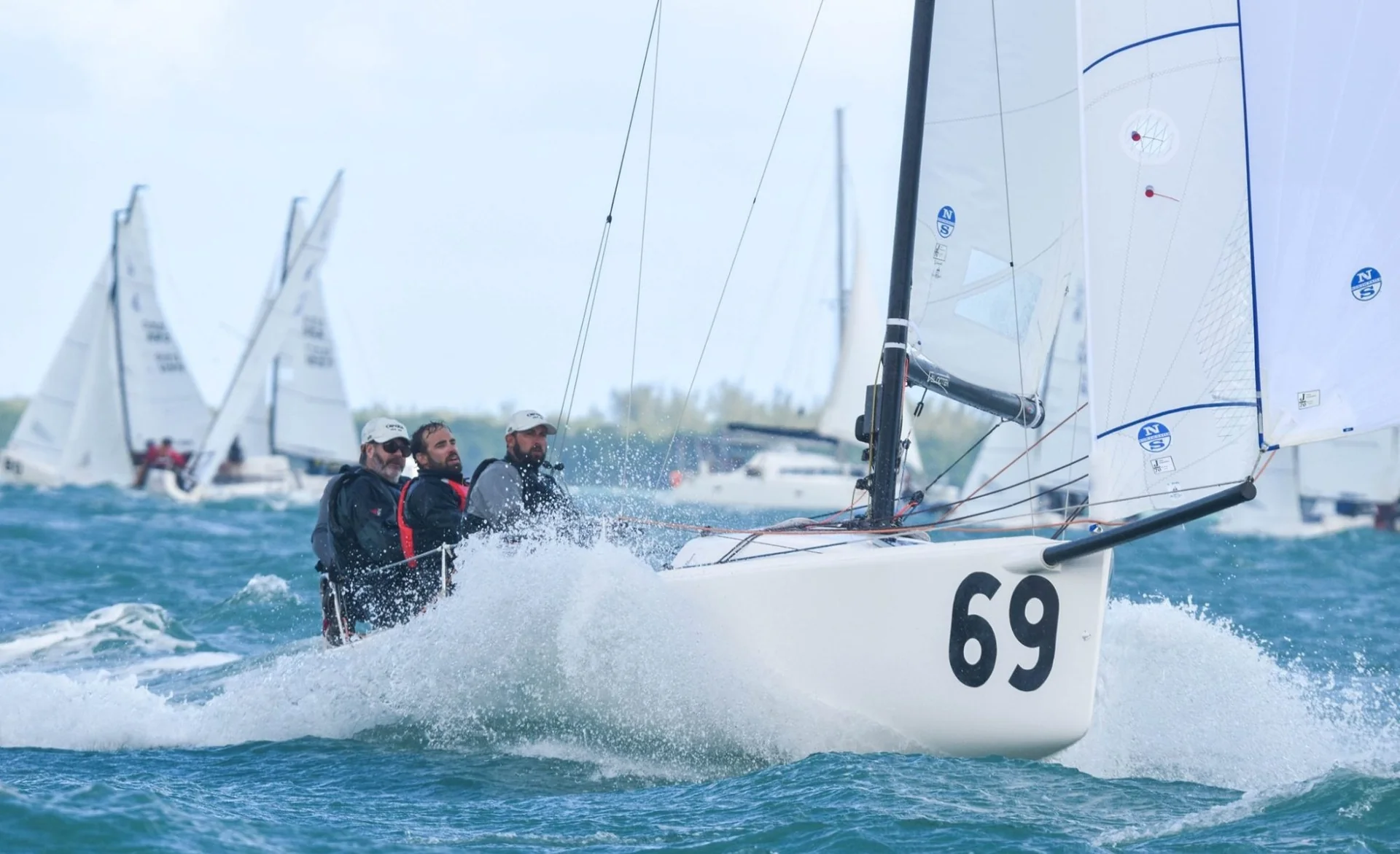
ZEKE HOROWITZ'S J70 TIPS TO THE PODIUM
ZEKE’S J70 TIPS TO THE PODIUM
Lessons Learned at the Helly Hansen Sailing World Regatta – Marblehead
📸 Chris Howell
As usual, the town of Marblehead pulled out all the stops for competitors to descend upon the quaint New England town for a weekend of racing in multiple one design classes. The J70 class showed up in full force with most of the top American teams including several class World Champions. At stake were two 2 qualification spots for the 2023 Worlds in St. Petersburg (1 open, 1 Corinthian) so the racing was as tight and competitive as ever. As crew for John Heaton on Empeiria, along with teammates Zach Mason and Will Felder, we were fortunate enough to come away with the Championship and a berth in next year’s Worlds. In addition, our North Sails teammates on Smokeshow, skippered by North Sails North American One Design Manager Allan Terhune with Paul Sevigni, North Sails Expert Chris Larson and Dave Hughes finished second, rounding out a weekend to celebrate for North Sails.
Our team was successful at the Helly Hansen Sailing World Regatta Series Marblehead by relying on lessons we’ve learned over the past couple of years. Admittedly part of our success is due to having sailed together for over 2 years and there is really no substitute for being comfortable with and confident in one another – trust that comes with time. However, aside from our team experience, there were past lessons we drew from during this event that helped us stay fast in the wide range of conditions presented. The J70, due to its rig and hull dimensions, is a boat that has a very fine line between being underpowered and overpowered. The conditions in Marblehead exaggerated this characteristic as the wind range was constantly hovering on either side of this fine line. So it was imperative to adjust your sail and body trim to accommodate for either the lack of power or abundance of power since it was rare to have the rig tuned perfectly. Following are some of our tips that should help keep you fast through the transitions in your next race.
Outhaul
The outhaul is one of the controls that’s easiest to ‘set and forget!’ But it’s actually an incredibly important adjustment for your power package. Due to the high aspect ratio (tall and skinny) of the J70 mainsail, the outhaul affects a larger area than it does on a sail with a lower aspect ratio. So a quick ease of the outhaul will put a boost of power into your sail plan to give you something to hike against. Our team has learned to be very diligent with this adjustment when we are transitioning from hiking to bodies in. Zach is our jib trimmer and we try to leave him in the boat the longest so he has a view of the jib as long as possible. If he is in the boat, we leave the outhaul quite loose to power up the main and try to get him hiking. We’re desperate to get him hiking as more righting moment = more speed! At this setting there is probably 6-8 inches between the boom and the foot of the main. As soon as he’s able to get on the rail and start hiking, we pull the outhaul back on to flatten the main and reduce drag. Any time Zach moves in or out of the boat, we make the appropriate outhaul adjustment.
Jib Foot/ Inhaul
How much to inhaul the jib can feel like quite the moving target… and it is. Its important to set the weather sheet in the cleat in a place where the jib trimmer can play it by “banjoing” it on when we need more power and then easing it back when we want to flatten the bottom of the jib and open the leech. When set correctly, this can be done without adjusting the weather sheet in the cleat. Think about your jib lead and inhaul setting similar to how we set the outhaul as described above. In light air or chop, you want more power in the bottom of the jib which means you want more depth in the foot compared to when it’s windy or flat water. A good rule of thumb is to try to get the foot of the jib to contact the cabin house as much as possible to prevent air from jumping through the gap under the foot. If it’s windy, you’ll need to pull the lead back a bit to depower the sail in order to inhaul enough to bring the foot to the cabin house. If it’s light air, you’ll need to push the lead forward a bit in order to provide enough depth in the foot (power) when the foot is along the cabin house. A good range on the jib lead is between 6 – 7.5 holes showing between the front of the car and the forward most factory bolt in the jib track.
Cunningham
The cunningham tends to be neglected just like the outhaul. Most of the time it’s not the most critical adjustment to make but there is a time when it becomes your very best friend. We saw this condition on the second day of racing in Marblehead when the breeze ranged from about 8 knots in the lulls to upwards of 16-18 knots in the puffs. We all know it’s best to set your rig tension for the lulls and do your best to survive the puffs and that’s where the cunningham comes in. For most, if you’re caught with your rig too loose, your first move is to whale on the backstay to depower and keep the headstay tight. But the problem is that without adequate rig tension, the tight backstay will quickly invert or wash out the main sail leaving you with huge overbend wrinkles and that ‘inside out’ look. But your headstay is still unstable making the boat hard to sail. This is when you want to really whale on the cunningham. To be clear, I don’t mean to just take those luff wrinkles out, I mean WHALE on it! Loads of cunningham tension pulls the draft of the main forward, putting some shape back into the sail (un-inverting it). This then allows you to pull even more backstay on to control the headstay. Your leeward shrouds will be doing basketball sized loops – blowing in the wind, but your headstay will be controlled and you’ll still have shape in your mainsail – albeit a flat shape. Will sits all the way forward going upwind and he keeps the cunningham in his hand. If we hit a light spot, he eases the cunningham as I ease the backstay to power up the rig and then as the next puff hits, he trims it on as I trim on the backstay. Keep your eye on the inversion wrinkle that comes out of the clew and goes up to the inboard end of the bottom batten. When overpowered, you want to see this wrinkle only and use the cunningham to eliminate the wrinkles below/forward of it. More cunningham = ability to pull more backstay = more controlled headstay = FAST!
Weight Placement
The J70 likes to have the crew weight forward going upwind. In fact, in light air it’s difficult to get forward enough. Some teams have experimented with sending their forward-most crew just in front of the shrouds and it seems to be pretty quick when the breeze is very soft. It’s also important to know that fore/aft weight placement can help the boat with moding. All other things equal, pushing weight forward tells the boat to point while moving weight aft helps with a bow down mode. In light air, it’s also important to think about body drag through the air. Try to hide the bodies from the wind as much as possible by tucking up to the cabin house or to your teammate in front of you. Also think about how you can position your body to be as aerodynamic and small as possible. Instead of facing forward with your shoulders square to the breeze, scoot forward and rotate your shoulders so they’re more in line with the wind direction. Sounds insignificant but reducing drag is the name of the game,
It seems like no matter how much we learn in the J70, we’ve never learned enough. It’s important to always be thinking critically and creatively about how to get faster. Keep the learning curve steep and watch your results improve! For more in depth information or for any specific questions, don’t hesitate to reach out to your J70 class North experts.
Contact your North Sails J70 North American Experts here:
ZEKE HOROWITZ ALLAN TERHUNE ALEX CURTISS
READ MORE
READ MORE
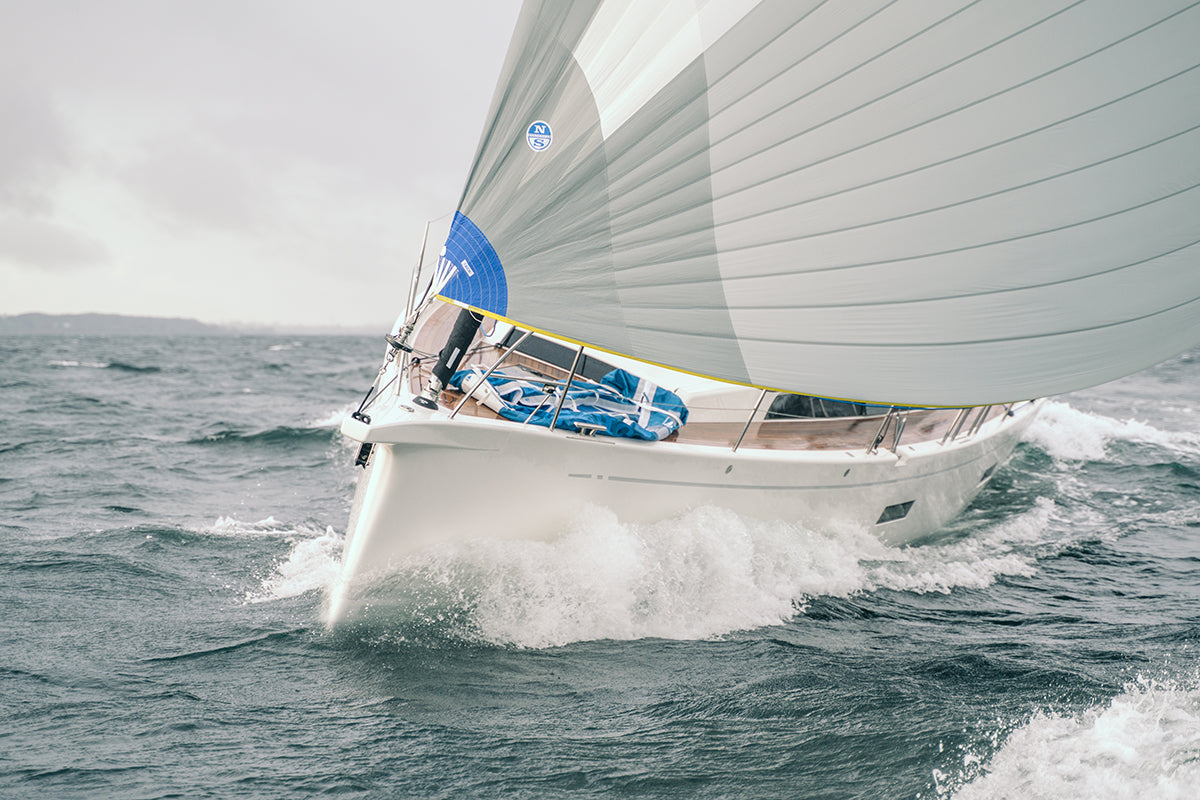
TRIMGUIDE TIL CRUISINGSEJLADS
For cruisingsejlere handler trimning om at få en komfortabel sejlads med en glad båd i god balance.
📸 X-Yachts
Download vores Trimguide til Cruisingsejlads her
READ MORE
READ MORE
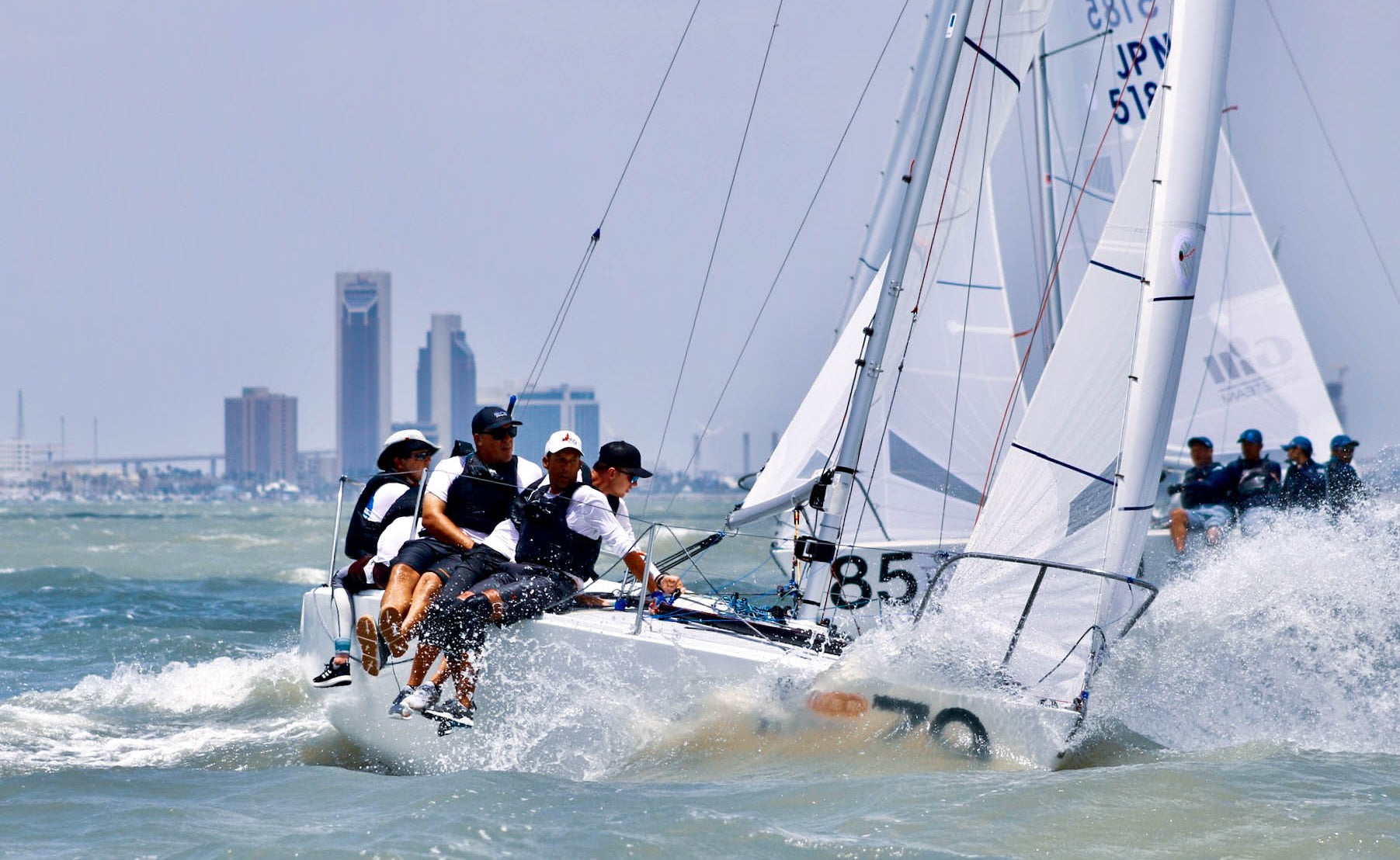
MIKEY AND THE GARAGE ROCKET
MIKEY AND THE GARAGE ROCKET
North Sails Experts Claim 2022 J24 World Championship
📸 Emily Stokes
There are plenty of clichés in sailboat racing, and perhaps one of the best is, “you’re only as good as your last race.” And what exactly does this mean? We’ll get to the answer eventually, but let’s begin our story with Mike Marshall and his teammates on American Garage—trimmer David Hughes, tactician Allan Terhune, pit Jeff Hayden and bowman Rod Favela—as they are pacing near the signal boat at the J/24 World Championships in Corpus Christi, Texas, having been dinged with a black flag on the fourth and critical penultimate day of racing.
“It was self-inflicted,” Terhune says. “We didn’t manage our time and distance appropriately, plain and simple. We had a bit of pep in our step, we were still fourth and the discussion was we had to make something happen. Then we did the opposite of making it happen.”
The mistake was nerves, the energy of the day, Marshall says. They set up too close and too early near the pin end of the starting line. “We didn’t need the risk,” he says, “and we would have been happy without it.”
Lesser teams would have caved and thrown in the towel, but the opposite happened onboard American Garage. “Sailing back and forth for an hour and half waiting for every boat to finish, you might start thinking, ‘That’s it,’ but we said we can either pack it up now or just keep fighting. Part of that fight was that we knew we had to step on the gas, and that’s where our second in the next race came from.”
Later that night, Marshall and his teammates rallied around the scoresheet, and the path forward was clear. “It was obvious that our results were improving in the back half of the regatta,” he says. “The numbers were saying that—mathematically—our results were getting better while others were not. We all agreed going into the last day that this was ours to give away.”
They were confident—not cocky—Terhune says, because they knew they were hitting their stride. They had the right team and the right boat to get ‘er done. Which brings us to the boat, No. 3379, and its part in this incredible story. The boat has always been called American Garage as far as Marshall knows. It’s a 1982 vintage J/24 once co-campaigned by Soling Olympic Silver medalist Kevin Mahaney and Hall of Famer Dave Curtis. At some point, American Garage was put out to pasture on Cape Cod until it was discovered by North Sails’ Will Welles, himself a J/24 world champion.
📸 Emily Stokes
Welles knew Marshall had been looking for a boat capable of winning the J/24 worlds, so he paid the owner a visit. “We went out and looked at it and it was a total disaster,” Marshall says. “It had been sitting under a tarp that was less of a tarp and more of a rain catcher.”
The boat sat in Marshall’s yard, continuing to rot from the inside out while he contemplated what to do with it and whether he was willing to undergo and underwrite such an extensive refit. What soon followed was not a project born of boredom, but of motivation and calculation.
The dilapidated vessel was towed to Chris and Monica Morgan’s speed shop in Florida with the goal of a six-month turnaround, which, of course, became a year and six months. “The only reason it happened was because of Chris and Monica,” Marshall says. “They did an amazing job on the boat and they worked hard to get it done.”
The Morgans, masters of the longboard, replaced 70 percent of the deck and gutted the interior. “The only thing we didn’t do was change the keel,” Marshall says. “The hull, keel and rudder were media blasted, faired, and repainted. We put on new hardware, got a newer mast and all new lines. What was essentially left of the original American Garage was the hull, so it seemed fitting to keep the name.”
Why go through such effort when a professional sail designer of his stature could have a much newer boat at his disposal? “I don’t know,” he says. “There are fast boats and there are some boats that are just never there. But at the end of the day, a boat that can win the J/24 Worlds is a no-excuses boat.”
Marshall knew American Garage was fast back in its day, and clearly it still is today.
“We sailed the whole event at the top of the genoa, and didn’t break anything,” he says. “Even when we were on the wrong side of the racecourse the boat was doing the work and still going fast. It comes down to all the little things adding up to one-tenth of a gain here and there. If it gives you a half boatlength at the first windward mark, that’s a huge deal.”
When it comes to J/24s, having the right keel shape is important, he adds, as is a good mast and the right sails, but “having a boat that you didn’t lose anything because it didn’t break is 80 percent of it and having a boat that has all the boxes checked—it’s stiff, it’s fair, the keel is right, the rudder is right and everything is correct.”
But we all know it’s not that simple. Fixing an old boat is half the battle. They still have to get the most from it in all conditions. Enter Dave Hughes, the three-time Olympic 470 sailor who brings to the program a level of detail bordering on obsessive-compulsive. “He was a big pusher of writing things down, which we all do, but he does it to the extreme,” Marshall says.
As they became students of the boat in the months and miles leading up to the 2022 worlds, Hughes applied the meticulous processes required of an Olympic campaign.
📸 Emily Stokes
“It wasn’t until Midwinters this year, in very light air, where we saw we were lacking a bit of power and started to mess around and write our settings down in anger,” Marshall says. “At that event, we began putting our mast-butt settings together. The tuning guide for the newer masts is basic rig tuning, so we had those settings from day one, so it was really about locking in the mast-butt locations for the boat and what the boat wanted in each condition. That’s been ongoing and it continued a lot during Worlds.”
Terhune, who’s sailed with a lot of top programs in his decades as a professional sailor, was awestruck by Hughes’ obsession with measurements. “I’ve never seen two people work so hard to set up a boat so perfectly as Mike and Dave did,” Terhune says. “We made it a goal to be faster every day and we were. At Worlds, we had a good early part of the regatta, but I guarantee that the Day 5 American Garage team would have kicked the crap out of Day 1 team and that’s because Mike and Dave never stopped with the rig-tune development. I’ve never seen anyone write more things on a boat than Dave. It was a no-stone-unturned mentality and the level of detail they had was staggering.”
At the end of each sailing day, Marshall and Hughes would transfer all the scribblings to a Google Sheet for the team to review, keeping track of fast and slow settings. “We equally kept track of the things that were good and bad,” Terhune says. “That was part of the process that Dave was insistent upon, making sure we didn’t just talk about the rainbows.”
Even for Marshall, hyper-analytical himself, Hughes’ approach was next-level. “It was about getting rid of just changing the mast butt because it feels right, to having the data, having the measurement for the wind condition; getting rid of going by fingers on the headstay and actually having millimeter measurements. It was about documenting the good and the bad, but also how to move forward constructively from the bad stuff and then having it written and not guessing anymore. For example, before a race we’d say, “we want to go to 112 on the mast butt, we want to go plus-one, plus-two on the shrouds, and because we’re moving from 116 to 112 we need to add another half turn on the lowers. By looking at the wind conditions we know what it was—every time.”
That’s the unlocking speed of right there, and as Terhune noted earlier, they were getting more out of American Garage every day, and the faster they got, the more confident they grew.
On the opening day of the championship, Paul Foerster—Olympian, Hall of Famer, and one of the all-time greats of American sailing—and his team came out swinging on the same waters on which he won his J/22 World Championship title a year earlier, winning both races—by a Texan mile. The pecking order was established immediately. “We were all taken aback by how badly Paul crushed everyone.” Terhune says. “It was a thorough butt kicking, and everyone was scrambling after the first day.”
It was also a wakeup call for Marshall and Co. on American Garage. In any other championship an 8-2 in a stacked 38-boat fleet would be a good start, but with Foerster on fire, good wasn’t going to be good enough.
📸 Emily Stokes
“That was the moment where we said we have to search for more speed,” Marshall says. “We were not fast enough to get ourselves out of bad places. We were not quick enough and kept getting swallowed up in the fray. We needed to clean things up and be faster downwind.”
The following day, the Corpus Christi wind machine turned on big time. Out came the blades, and these were not your normal blade conditions. It was, as Marshall says, easing-the-blade sailing: “Usually, when you step down from the genoa, you put the blade on and trim the thing in because it’s right at the crossover of the genoa. But this was blade-eased 6 to 12 inches kind of thing. It was at times so windy that we were just sailing off the leeches of both sails, where you step away from trying to sail fast with sails trimmed hard to trying to keep the boat flat and moving fast through the waves.”
Foerster continued his streak, starting the second day with another race win, but American Garage finally posted one of their own. On the scoreboard they were fourth, but they were finding their groove. “We had good pace, but knew we had more to go,” Marshall says. “It was a big one for us when we won that race and Paul did not.”
The following day, again with the blades, they won the first race and sailed home with a fifth. Everything was going in the right direction: “Another good set of scores kind of showed that Paul was beatable at that point,” Marshall says. “He was not going to run away with it and our job was to continue to chip away at the points and let the regatta come to us.”
The improvements and speed gains were happening live, both upwind and downwind. They were changing for the conditions, adapting on the fly. In the steep waves kicked up by consecutive days of 20- to 30-knot winds, starboard tack was straight into the milky blue walls. Port tack presented its own challenges. Marshall explains in detail with some good lessons for J/24 sailors: “Starboard tack was all about putting the bow down and keeping the boat moving. This is where I think people would give up a lot of height. I was doing it early in the regatta, trying to put the bow down to get the boat to accelerate, but I didn’t really need to because I was already at the right angle. I needed to let the boat do more of the work.
“Port was actually the harder one because as the wave rolled under us from the side it would roll the boat over and push it super heeled, but then as it went out from under the other side it would roll us back flat. Our initial thought there was that we didn’t need the power to get through the waves so we moved the jib car back a hole and didn’t think that was the right direction.
📸 Emily Stokes
“On the third day, we moved the car forward to keep the upper leech of the jib engaged a bit more. As the wave rolls under the boat, the apparent wind on the jib changes massively because the boat is going sideways, and as it’s going down the other side of the wave, it’s going less sideways. So, keeping the cars forward to keep the upper leech a bit more engaged meant we weren’t giving away as much height on the backside of the waves. And I was super aggressive with the steering as the wave hit the bow to not let the wave push the bow downwind.”
By Day 3, their downwind sailing was improving too, says Terhune, thanks to Hughes’ dynamic trimming, and the sharp sail handling by the bow team of Hayden and Favela. “If there was one story of our regatta, it would be about the early part of the week we were very weak downwind—subpar even—and by the last day of the regatta we were probably one of the best boats downwind. That’s a function of Dave talking about what he felt on the sheets and the four of us talking about how to move around the boat. It took us a couple of days to get it right, and part of it was that we all changed our mentality of it being a J/24 where you just pull the pole back and go dead downwind.”
In a smaller fleet and on a smaller course you can kind of get way with sailing low and slow, Marshall says, but on a big course that’s not the case: “On a big course, where the leverage on each side is pretty unforgiving, you end up out on the edges and you have to be very quick on your side or you end up with big losses. The VMG has to be more important and that was our change—to not be too low and slow. That’s quite counter to what you would normally do on a J/24.”
It was all good on the morning of Day 4, but then came the black flag. But there would be no quit in this squad. They were only 3 points shy of the title with three races to go and they had to believe in the longer mission at hand. Their second-place finish that day kept them in the hunt.
“The morning’s discussion was that we were getting close, that today is the day,” Marshall says. “It wasn’t something of putting pressure on ourselves; it was just saying ‘now is the time to execute.’ We’d done our work and we were way faster than we were on Day 1. We were much more comfortable in the boat, so now was the time.”
Back into genoa conditions, American Garage came alive, just as it had for Mehaney and Curtis back in its day. The squad led at the weather mark in the day’s first race and posted a third to Foerster’s second. With a bit of padding to those breathing down their necks, the final race was all about fleet management and letting the Garage do its thing. With no points to spare, those battling at the top of the fleet avoided direct skirmishes, leaving the team to sail its own race. In the first mark rounding they sailed right over the top of Foerster’s team as they struggled to get around the offset mark.
“I think, maybe, they were finally feeling the heat and knew we were not going to stop,” Terhune says. “They had their unforced error at the worst time. It’s still a mystery as to what happened. They got tangled up somehow, but it was the first break we got all week and it was the break we needed.”
And there is one key ingredient that can’t be ignored in this victory: “The sails we were using were the same as anyone else sailing with North Sails in the regatta,” Marshall says. “We’re not making ourselves a custom set of sails. Paul felt like he had a bit of an edge in speed with his other sails in light air, but eventually realized they were not all-purpose sails and they were a little off the pace at Nationals and pre-worlds. He initially had a cross-cut genoa, which is never going to be able to get through the full range. It might have an advantage in light air, but not in 18 knots.”
Foerster, Marshall says tried a lot of changes to get faster in breeze, but had limited results, so his solution was the ultimate grenade: a new mast and different set of sails, which dropped into his lap only days before Worlds. “He changed to North Sails and won the first three races, which is a good example that not all sails are built the same, and the crux of it is how you get that last 1/10 out of your boatspeed.”
The refinement of the American Garage’s inventory—the Newport Fathead Main and DDX7 Genoa (once called the Newport Genoa)—dates back to the early 1990s, the peak of the J/24 arms race. “Yes, there’s been updates and tweaks and finishing changes,” Marshall says, “but that main and the genoa combination remain the gold standard of J/24 sails.”
What makes them particularly fast, he adds, is their ability to be quick throughout the wind range. “It’s such a wide range and they’re so easy to set the boat up to be going 95 percent speed 95 percent of the time. That’s the key—if you want that extra two-tenths, you can work hard to get it like we did, but essentially, you can set the boat up with two fingers on the headstay in 15 knots and sail around at 27/24 and you’ll be happy with that all day long. Being able to go 95 percent speed 95 percent of the time without putting in too much effort is what wins regattas.”
American Garage now sits in Texas awaiting its next chapter, perhaps to never again be left to rot on Cape Cod, and onto the North Americans in Annapolis in October, where it will arrive, as the saying goes, as good as its last race.
Shop the Winning Inventory and Contact an Expert today.
📸 Emily Stokes
READ MORE
READ MORE
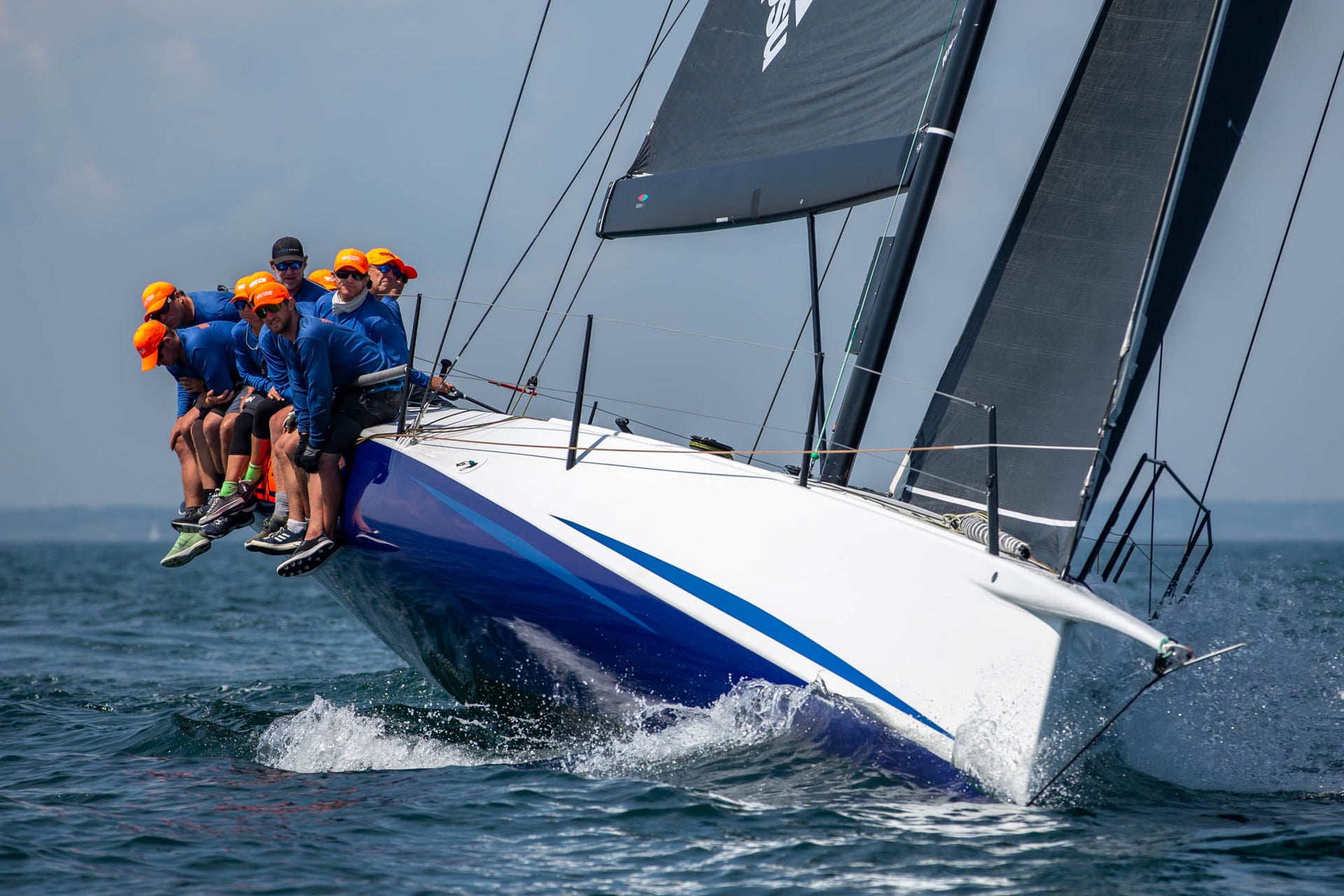
TRIUMPH ON THE EDGE
TRIUMPH ON THE EDGE
John Bacon’s Recipe for Success at the New York Yacht Club Race Week
📸 Stuart Wemple
There are lots of ways to attack a regatta, but if you want to win, here are a few things you might wish to avoid: 1) a brand-new owner who’d never laid eyes on the boat until mere days before the racing; 2) an international crew consisting mainly of somewhat laid-back Australians and rather intense Americans (with a strapping Dutch dude thrown in), most of whom had never sailed together before; 3) a largely untested boat with a strong pedigree and (perhaps?) plenty of untapped potential, but also saddled with several important, unanswered questions; and, finally 4) an inaugural event for the yacht and team in a ridiculously competitive, high-profile handicap series with at least two competitors that boasted a solid track record which suggested they might totally clean your clock.
This approach could be summarized in myriad terms, one of which is certainly “recipe for disaster.”
But these were also the ingredients that came together aboard the 44-footer, The Edge, during this summer’s edition of the New York Yacht Club’s Race Week in Newport. In an astounding collaboration between North Sails; Aussie owner John Bacon and his talented Down Under mates (with North’s Sydney-based sailmaker, Alby Pratt, playing a prominent role); and a posse of local Newport gunslingers led by North’s Ken Read (that also included North’s European one-design ace, Joost Houweling), The Edge made a statement in the initial event under Bacon’s stewardship by winning ORC Division C in emphatic, going-away fashion.
And in doing so, The Edge’s crew also laid a framework for success that other teams, in similar circumstances, might be wise to consider and emulate.
We’ll begin, naturally, at the beginning. Several months ago, Pratt received a call from Bacon’s right-hand sailing partner, David “Tower” Sampson, who said that his good mate was looking to switch gears from the one-design racing he’d concentrated on for the last decade to get back into handicap racing with something in the mid-40-foot range. Specifically, they were looking at The Edge, for sale in Newport, which had several things going for it. First, the Harry Dunning-design was from the board of the same naval architect responsible for Bacon’s last big boat, an MC 38, and were both built by McConaghy Boats, just a few miles down the road from his home in New South Wales. And it was equipped with a full set of little-used North Sails.
“So I called Kenny in Newport,” Pratt said, “and told him I had a client who was interested in buying and campaigning it, and asked if it was any good.”
“I’d sailed the boat with the previous owner, who’d commissioned it as the ultimate Grand Prix boat in that size range, with Interlodge as sort of the benchmark,” said Read. “We did a couple of events that culminated in a win at Block Island Race Week, and he was thrilled, but it was sort of a one-and-done thing for him. I have to give Mike Marshall, who designed the sails, a lot of credit. They were perfect. Anyway, I knew the boat was solid and had a good pedigree.”
With Read’s positive endorsement, and feedback from his friend Dunning, Bacon decided to pull the trigger on the Dunning 44. “I thought, ‘Let’s go sail against some really good boats and that will give us a mark about where The Edge is,’” he said. “If we come last, we’ve got a dog and we’ll sell it. But if we do all right, we’ll know we’ve got something, a nice platform that we can invest in.”
📸 Stuart Wemple
A week before the NYYC event, the 11-person team assembled in Newport. The Aussie contingent, led by Sampson and Pratt, also comprised Darren “Twirler” Jones on mainsheet, another trusted hand. The Newport squad, with Read as tactician, included his partner on the doublehanded circuit, navigator Suzy Leech, and bowman Sam Fitzgerald—a pro sailor, engineer and member of the American Magic team—who’d been largely responsible for putting The Edge together in the Australians’ absence. Bacon (who wants it to be known he’s a longstanding member of Missouri’s Weatherby Lake Yacht Club!), flew in from Europe, fresh from a fourth in the 5.5 Metre Class World Championships and overall champ in the Corinthian division; with him was North’s Houweling, who oversees Bacon’s European sailing programs.
With that, they got to work. “We had five solid days before the regatta to get to know everyone and get our maneuvers down,” said Pratt. “That was invaluable. Once we started the regatta, we were actually racing, not trying to sort out the boat, and who did what, and where to sit on the rail. We had all that dialed in.” John also commissioned a new North Helix Light jib and a new A4 spinnaker. The new jib proved to be the go-to workhorse sail for the majority of the racing.
For the first day of racing, the NYYC race committee sent the fleet outside into Rhode Island Sound. “It was really light, with leftover chop, the conditions don’t get much harder really,” said Bacon. “At first, we were never up there with the hot guys, Interlodge and Stark Raving Mad. I think I was probably sailing a bit hot and then Kenny got me driving a bit deeper. And all of a sudden we started coming at them.”
“John’s a really good driver, but he doesn’t love the light stuff,” said Read. “And if the boat has an Achille’s heel, it’s the light stuff. But we ended up with a 2, 3, 1 that first day, just a couple points out of first. On the first day of racing as a team? I’ll take that.”
On Day 2, the racing commenced up Narragansett Bay, more or less on the Read family’s home waters close to nearby Barrington, Rhode Island, his childhood sailing venue. “I wasn’t too upset at that,” he laughed. “The one unique thing about the week was that there was a super moon, and I’m not sure everyone understood how big a deal the current was going to be. It was pretty comfortable for me, like having your blankie when you’re a kid.”
The results tell the story. The Edge scored bullets in the next three races. For all intents and purposes, it was game, set, match. And victory in ORC C.
“I can’t say enough about how the crew came together,” said Bacon. “It was copybook. It takes some boats months and months to get a crew that coherent, these guys did it in a few days. There was a lot of respect among everyone. It was an incredible experience, I learned so much that week. How could you spend a week with Ken Read and not learn something? And Newport and the New York Yacht Club are very special to Australian sailors. To do well there, it will always be a special thing for me, for sure.”
“Having John coming straight from the 5.5 Worlds was a huge advantage,” said Read. “One of the pitfalls of being an owner/driver is you probably have a job that takes up 98 percent of your time. So when all of a sudden you’ve kind of eased out of that day-to-day work grind and transitioned into the day-to-day rhythm of steering a sailboat fast, well, that was a huge advantage for us. And as a tactician, I’ll take that advantage every day of the week.
“I don’t use the word ‘perfect’ very much, but The Edge was the perfect mix between the owner’s sailing friends and some industry pros that clicked as a team and made it fun for the owner,” he continued. “So if you have a combination of people that the owner likes onboard, with people who can get the boat around the race course, and a project manager like David Sampson who always thinks on behalf of the owner’s wishes, the program’s going to be successful. Because you can win every race, but if the owner’s not having fun, he’s not coming back.”
Joost Houweling concurred on the matter of the importance of having a person like Sampson in charge of what’s happening not on the water, but off it. “When the owner comes on board, he’s absolutely in charge, but he’s comfortable because everything else in the program is taken care of,” he said. “What’s the handicap? Where do we eat and sleep? What has to happen with the sails? Who’s the crew? Where are their tickets? If all that’s arranged, as it was on The Edge, John could just concentrate on sailing. It’s very important to have a guy like that.”
So, to recap the elements required to put together a winning program in short order on the fly: A good, potentially great boat with an excellent sail inventory. A committed and skillful owner/operator. Several days of practice beforehand, concentrating on starts and turns. A dedicated point person in charge or organization, details and logistics. A steadfast crew that learns from their mistakes and does not repeat them. Some local knowledge. And, of course, a bit of luck never hurts. And that is how you get The Edge.
📸 Stuart Wemple
READ MORE
READ MORE
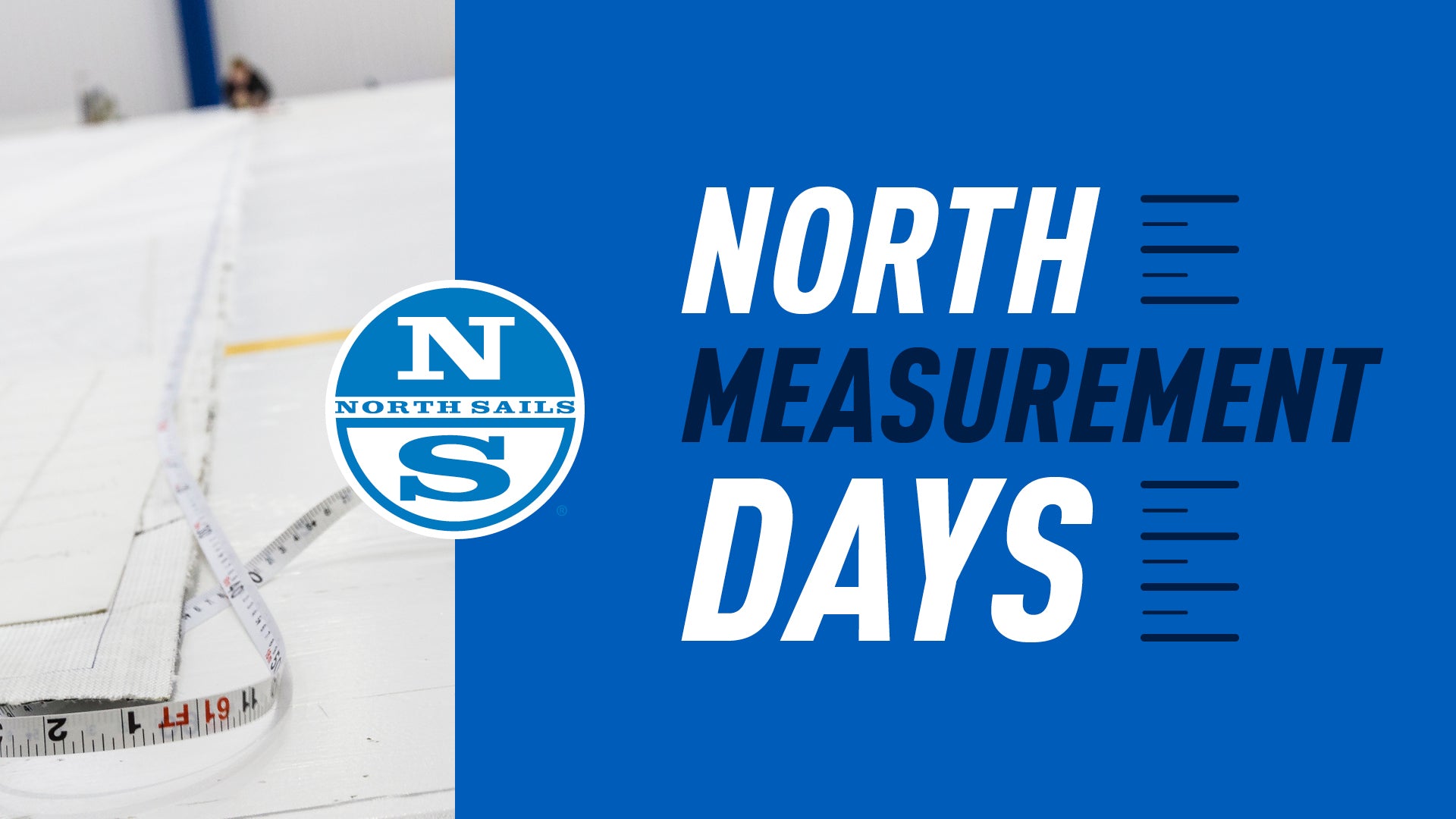
SORC X NORTH SAILS
SORC x NORTH SAILS
Optimize for ORC Racing
As part of our continued partnership with Southern Ocean Racing Conference as the Official Performance Partner for the 2022-2023 edition, North Sails is offering measurement days across our South East lofts. These measurement days will provide participants with an opportunity to discuss their inventory with North Sails experts and how best to optimize their rating. Participants can also have their sails measured and drop them off for any necessary pre-race service.
Mark your calendars and join our North Sails experts at the following locations:
Annapolis, MD | August 26th, 1-4pm
Charleston, SC | September 8-9, 2-5pm
St. Pete, FL | September 16, 1-5pm
Ft. Lauderdale, FL | September 30th, 1-5pm
Miami, FL | October 21, 9-8pm | October 22, 9-7pm
Our North Sails experts look forward to connecting with you and learning about your sailcare needs at the upcoming measurement days.
The Southern Ocean Racing Conference series consists of four distance races that draw a fleet from across the country and includes a range of yachts from super maxis to corinthian cruisers. The series prides itself on accessibility for a wide variety of sailors and offers storied races from South Florida to destinations like Key West, Nassau, Palm Beach, and Cape Canaveral.
READ MORE
READ MORE
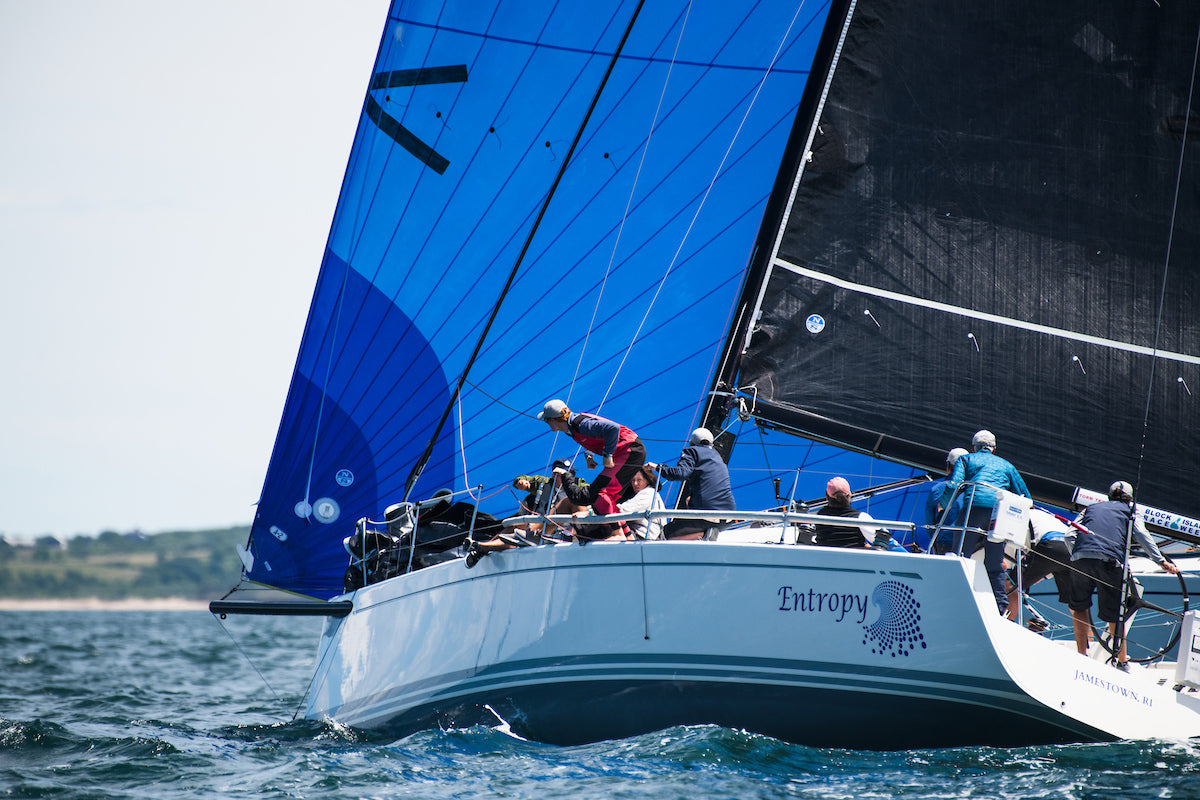
ENTROPY WEARS THE CROWN
ENTROPY WEARS THE CROWN
Patience Pays Off For Local Club Swan 42 Crew
📸 Cate Brown
Over the past decade, the husband and wife team of Patti Young and Paul Hamilton have gradually moved their young Entropy team up near the top of results at most of the big New England regattas. In mid-July, they scored their first victory at the prestigious Queen’s Cup on their Club Swan 42. And part of the credit for that win has to go to the ongoing support they’ve received from North Sails over the years, Patti says, “North has been very good to us.” In addition to advice about sails, boat modifications, and team building, Max Tringale joined their team even before he became a coveted sail designer, showing up for everything from the local evening summer series to the Bermuda Race. “His mother said to me early on that I’m like his second mom!” Patti laughs. “Max does everything; he’s definitely helped us improve the boat.” When they first started the race program, most of Entropy’s crew were still in their twenties. Now they’re almost all married, helmsman Paul explains, and some are starting families—but still using valuable vacation time to race. “Everybody's kind of stuck with us,” Patti says. “There’s never any yelling—it’s a good program. And these kids are amazing.” Both owners agree that the core group’s dedication and loyalty is their real key to success— though it’s not an all-pro crew, or even the same group from one regatta to the next. “We always bring a few new sailors on board for every race,” Patti says, adding that many are college-age with very little big-boat experience. As navigator, she also helps organize the crew. Over the winter, work parties are followed by pizza and suggestions on improvements for the next season. Though there was talk about replacing the Swan 42’s retractable sprit last year, it wasn’t until right before the Bermuda Race that they finally upgraded it to a fixed sprit designed to handle the loads of Helix headsails. Paul says it’s a good thing they made the change, “because it was a real blow.” After a ninth overall in Bermuda’s Gibbs Hill Division, Entropy returned to Narragansett Bay in time to line up for New York Yacht Club’s Race Week. Consecutive days of racing turned out to be the perfect warmup for the Queen's Cup, which took place the day after Race Week ended. The Queen’s Cup was first awarded in 1953, and it’s won by completing the course in the shortest elapsed time. The list of previous winners reads like a who’s who of each decade’s hot race boats, and includes several America’s Cup yachts as well as Bolero (1954), Running Tide (1970), Tenacious (1981), and Belle Mente (2020). All helms must be category 1 amateurs, and the course must contain reaching legs.
📸 Stuart Wemple
But the race’s biggest twist is its two-minute starting window. “Everyone always wants to start right at the gun, like a hare to hounds,” says Paul. But with fresh memories of the crowded starts at Race Week—and her experience gleaned from previous Queen’s Cups—Patti decreed that they would wait at least a minute to cross the line. “We started with about 45 seconds left in the window,” she says, adding, “I just didn't want to be near anybody.” Though they initially had a little bad air from Fox, a Botin 52 that would eventually finish second, the bigger boat soon left them a clean lane. “After that, the team sailed the boat really well.” The only other Swan 42 racing was Paul Zabetakis’ Impetuous. Patti spotted them up ahead on the first leg, though she’d been too focused on timing Entropy’s start to be sure exactly when the other boat had crossed the line. When they finished ahead of Impetuous, she knew they must’ve done well overall. “That was the only boat we could measure ourselves against.” “I knew we’d sailed a really, really good race,” Paul adds, “but I still didn't think we could beat the TP52s.” Soon after they crossed the finish line, they checked the results—and Patti saw Entropy’s name at the very top. “I screamed! I just couldn’t believe it. I knew we’d sailed really well, but…” “We still thought Fox would get us,” Paul says. “They’re pretty hard to beat.” But it was official; on their eighth attempt, Entropy sailed the Queen’s Cup course in the fastest elapsed time, beating out 23 other boats—almost all of which were bigger than their 42 footer. Asked for the biggest changes to sail inventories in the past decade, Paul says that Helix has been a big step forward. “The structured luff sails are working really well. And nobody was even talking about that ten years ago.” Patti adds that they now frequently sail with a double- and even triple-headsail rig, which has meant adding new halyards—and that new bowsprit. They’ve also put a symmetrical spinnaker pole onboard, to help wing out their largest headsail for the non-spinnaker division of the upcoming NYYC Cruise.
📸 Stuart Wemple
📸 Stuart Wemple
READ MORE
READ MORE
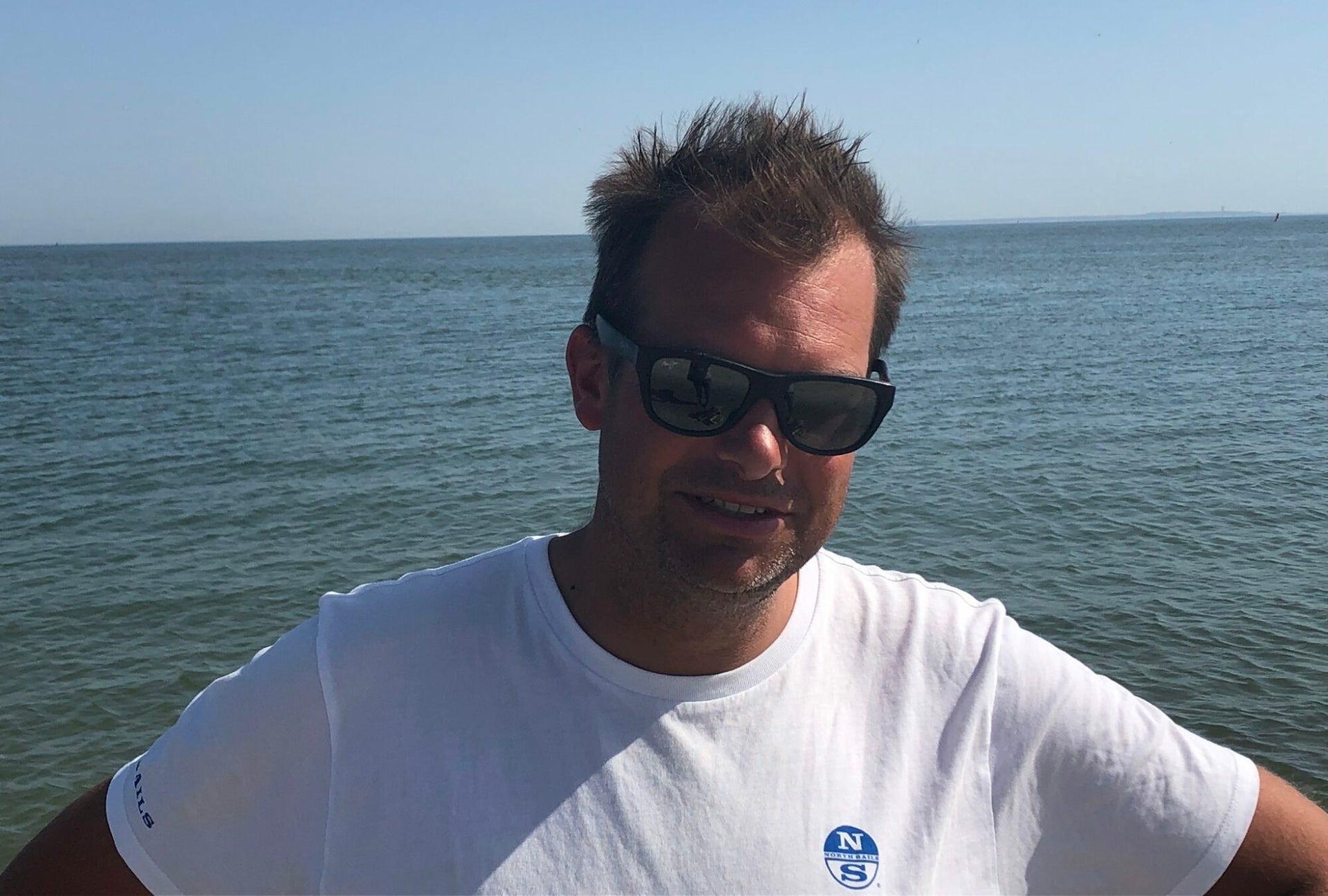
EVEN VOORSTELLEN: WOUTER KÖLLMANN
EVEN VOORSTELLEN: WOUTER KÖLLMANN
North Sails Expert
Wouter Köllmann (41) is van jongs af aan actief in de watersport. De rol van Sail Expert bij North Sails is hem dan ook op het lijf geschreven. Inmiddels is hij het vaste gezicht in de loft in Almere en deelt hij zijn passie voor het zeilen graag met klanten, vrienden en familie.
Waarom wilde je zo graag bij North Sails werken?
Ik ben zo goed als geboren op een boot. Hoewel ik relatief laat met wedstrijdzeilen ben begonnen – op m’n 13e pas – loopt zeilen als een rode draad door mijn leven. Het is mijn passie. Daarom wilde ik altijd al de zeilerij in. Na het bekende traject van Optimist, Laser en verschillende kajuitboten te hebben afgelegd, ben ik beroepsmatig gaan zeilen. Toen is het balletje gaan rollen. Sinds 2014 werk ik bij North Sails. Vanaf 2017 is de interne organisatiestructuur met onder andere de komst van Nic Bol gewijzigd en is de bereikbaarheid van North Sails uitgebreid met vestigingen in Almere, Rotterdam en Antwerpen. De essentie is echter niet veranderd. Wereldwijd zijn wij de benchmark. We blijven ontwikkelen en ook achter de schermen beschikken we over een professionele organisatie.
Is het werk echt zo leuk als je vroeger dacht?
Zeker! In principe is onze eerste taak om zeilen te verkopen, maar het gaat zoveel verder. We adviseren eigenaren en jachtwerven, optimaliseren zeilplannen, meten in, bespreken ontwerpen met de saildesigners en leveren de zeilen af. De ene dag voor een Optimist, een dag later voor een superjacht en alles daartussen. We hebben dan ook een uitzonderlijke baan. We zijn bevoorrecht dat we met mooie boten en het beste materiaal mogen varen tijdens unieke evenementen. En ondertussen helpen we mensen een stap verder met plezier maken.
Wat zijn de mooiste momenten op het werk?
Het afleveren van een nieuwe set zeilen. Eigenaren zien je graag komen en zijn blij met hun nieuwe aankoop. Onze visie is; iedere boot kan beter of comfortabeler, net waar de wensen liggen. Onze drive is dan ook om ervoor te zorgen dat er betere prestaties worden behaald. Natuurlijk zijn nieuwe zeilen geen garantie, voor een groot deel ligt het aan het team en de handling. En als North Sails zijn we er niet alleen voor de ‘diehard’ wedstrijdzeilers. Juist niet! Als een cruiser bijvoorbeeld teveel helling maakt, kijken we hoe we dat met de zeilen kunnen compenseren en daarmee meer comfort kunnen realiseren. Ook voor boten die af en toe aan een avondwedstrijd meedoen, kunnen we veel betekenen. Als je altijd 15e bent en met een goed zeilplan 8e of 9e kan worden, is dat net zo leuk!
Op welke overwinning ben je het meeste trots?
Heel stom, maar ik weet niet meer alle overwinningen. Dat klinkt gek, maar het is echt zo. Een leuk onderdeel van het werk is het verzorgen van bootmanagement. Zorgen dat de crew, de boot, de zeilen en het trainingsprogramma op orde zijn. Momenteel vaar ik op veel verschillende typen schepen, waaronder veel J-Boats zoals J/99, J/111, J/80 en J/109. Daarmee hebben we ook diverse nationale en internationale successen hebben behaald. Zo ook met de J/70, waarmee we onder andere tweemaal Nederlands Kampioen geworden, waarvan één keer samen met collega Jacco Huijgen. Dat was heel mooi. Maar heel eerlijk: tegenwoordig geniet ik ook enorm van het zeilen met mijn gezin. Lekker cruisen op onze toerboot!
Je hebt twee dochters. Gaan die ook zeilen?
Dat weet ik niet hoor! Mijn partner is ook een wedstrijdzeilster, maar of onze dochters dat pad ook inslaan is nog maar de vraag. De jongste van 1,5 jaar krijgt het nog niet zo mee en de oudste van vijf vaart op haar manier mee. Trekt weleens aan een lijntje en stuurt mee, maar vindt vooral het samenzijn aan boord heel leuk. We gaan het zien. Wel zie ik een hele nieuwe generatie zeilers klaarstaan. Gelukkig zijn er initiatieven als Team Heiner Talents en ROST van Gerd-Jan Poortman, welke we ook proberen te ondersteunen met North Sails. Zelf heb ik ook kansen gekregen, dus ben zeker een voorstander om de zeilsport te behouden voor de toekomst.
Wat is het beste advies wat je ooit hebt gekregen?
Doe wat je leuk vindt, anders ga je het niet volhouden. Als je iets kiest, doe je dat namelijk vaak je hele leven… Dat was het advies van mijn ouders. Desondanks stonden ze niet meteen te springen van blijdschap toen ik na mijn studie Werktuigbouwkunde en Commerciële Economie met hen overlegde en besloot om fulltime te gaan zeilen, maar ze hebben mij altijd gesteund. Gelukkig heb ik hun advies opgevolgd. Het heeft goed uitgepakt.
READ MORE
READ MORE
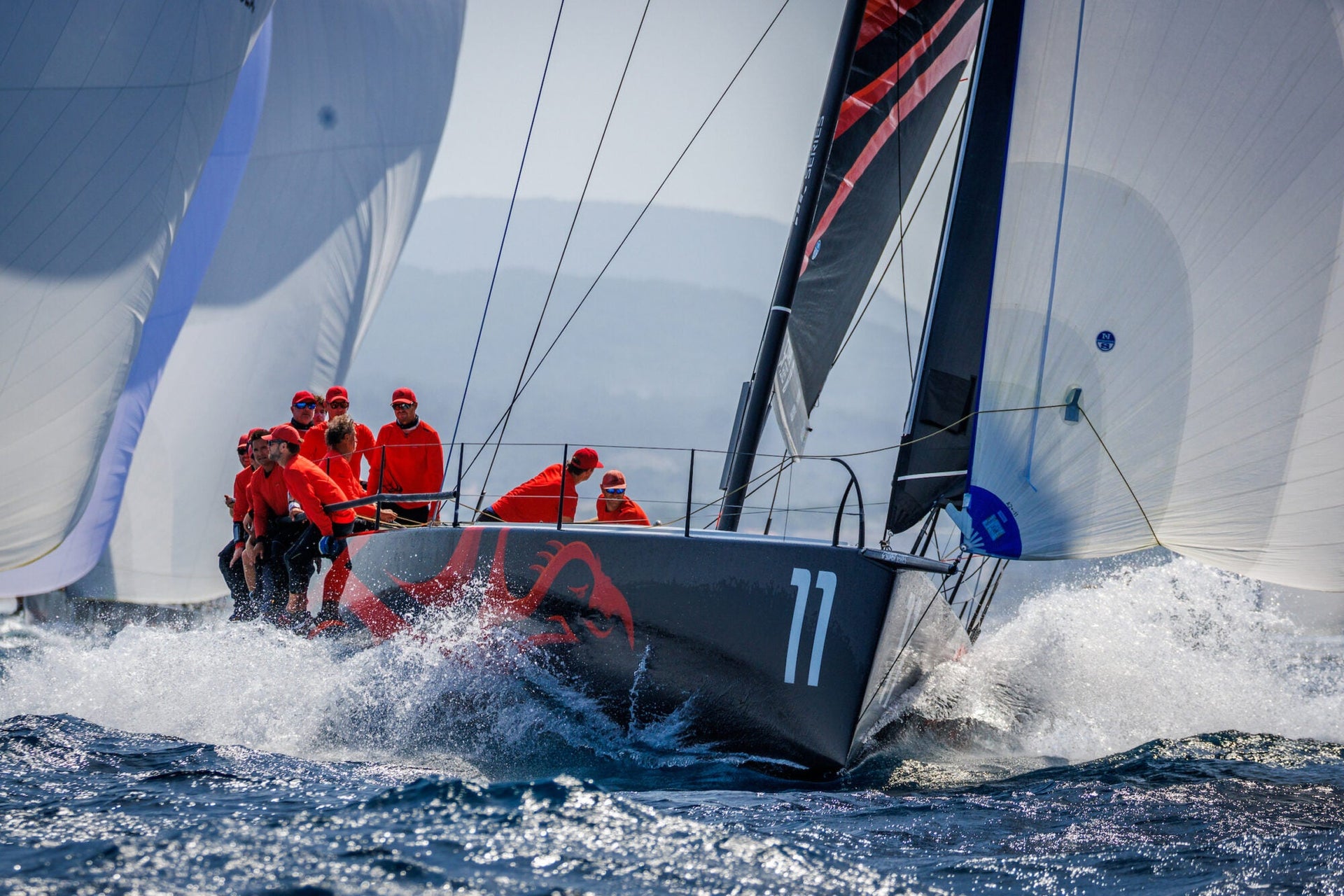
#NSVICTORYLIST - 52 SUPER SERIES PODIUM SWEEP
#NSVICTORYLIST – 52 SUPER SERIES PODIUM SWEEP
North Sails Onboard for Key Victories in Puerto Portals
📸 nicomartinezphoto
On July 21, nine super-charged TP52s, representing six countries descended upon the Bay of Palma for the third event of the SUPER SERIES season. 2022 marked the event’s seventh visit to Puerto Portals, Spain. And, amidst a heatwave, the wind forecast was anything but certain in a venue already known for its varying conditions.
North Sails powered the top three boats at the 52 SUPER SERIES Sailing Week in Puerto Portals. The Plattner family’s Phoenix claimed a long overdue regatta win, with 2021 season champion Sled placing second and Provezza making big moves on the final day of racing to round out the podium.
Phoenix’s Tactician Tom Slingsby commented on the team’s win.
“This feels amazing not just winning, but winning comfortably with this team. I have been saying for a long time that we are right on the edge and we have had a couple of podiums, thirds and fourths and just missed the regatta win. It feels great with such an amazing team we have here.”
Their win in Puerto Portals moves Phoenix to the top of the season scoreboard, a position they’ll fight hard to protect throughout the remaining two events.
As the sailmaker of choice to the majority of the fleet and a longtime sponsor of the SUPER SERIES, North Sails is committed to ensuring the teams we work with have the tools they need to win. Branded as the world’s leading monohull circuit, the SUPER SERIES is a test of teamwork, season-long perseverance, and for North Sails, continued product innovation.
All North-supplied teams competing in the SUPER SERIES use 3Di. First introduced in 2010, these molded composite sails are an indispensable building block of championship projects.
The latest refinement North designers have deployed for the TP52 inventory is the Helix Structured Luff. Structured luff sails are not limited to North Sails, but the pairing of Helix with 3Di uniquely maximizes the benefit of load sharing.
Available for both offwind and upwind sails, Helix is a game changer that enables a new gear. Sail shapes are more dynamic and that means more power. Regatta winner Phoenix sailed with a complete Helix upwind inventory during the event in Puerto Portals, and second place Sled used a Helix jib.
View this post on Instagram
A post shared by 52 SUPER SERIES (@52superseries)
North sail designer Burns Fallow is the designer of record for Phoenix. As the lead sail designer for America’s Cup Defender Emirates Team New Zealand, Fallow has been at ground-zero of Helix’s rapid development. One of the world’s leading aero-experts, Fallows, explains his work with Phoenix and their use of Helix sails.
“I did my first Helix designs for the Phoenix team at the end of 2021. And while they did not card that sail, the team used it for practice and got a feel for Helix’s increased range. I collected great feedback from their trimmers, particularly Morgan Trubovich, which helped with future design iterations. The team quickly realized the potential benefits of the Helix path and fully committed to the concept for the 2022 season.”
Follows continues, “Throughout the offseason, I worked on building simulations of Phoenix’s sails in Membrain, a program within the North Design Suite. With Membrain, I refined the range of tack loads and depths we were targeting based on the shapes the team was familiar with in their current inventory. North Sails delivered a full inventory to the team in April. The real-world results calibrated very, very close to what I had been seeing on my computer screen with the Membrain models a few months earlier.”
The 52 Super Series will race again in Scarlino late September. The circuit then heads to Barcelona in October for the final event of the 2022 season and of the nine boats competing in the 2022 season, seven have chosen North as their sailmaker. This is a testament to North Sails’ industry-leading technology, tools and also to the North Sails team. In total, six sail designers support the Super Series program year-round.
Learn more about the 52 Super Series and follow along with the 2021 season on https://www.52superseries.com/
📸 nicomartinezphoto
READ MORE
READ MORE

EXPERT PROFILE: MEET DANIELE CASSINARI
EXPERT PROFILE: MEET DANIELE CASSINARI, A Proven Leader Who’s Our Southern European Sales Manager and 2022 ClubSwan 50 World Champion.
READ MORE
READ MORE
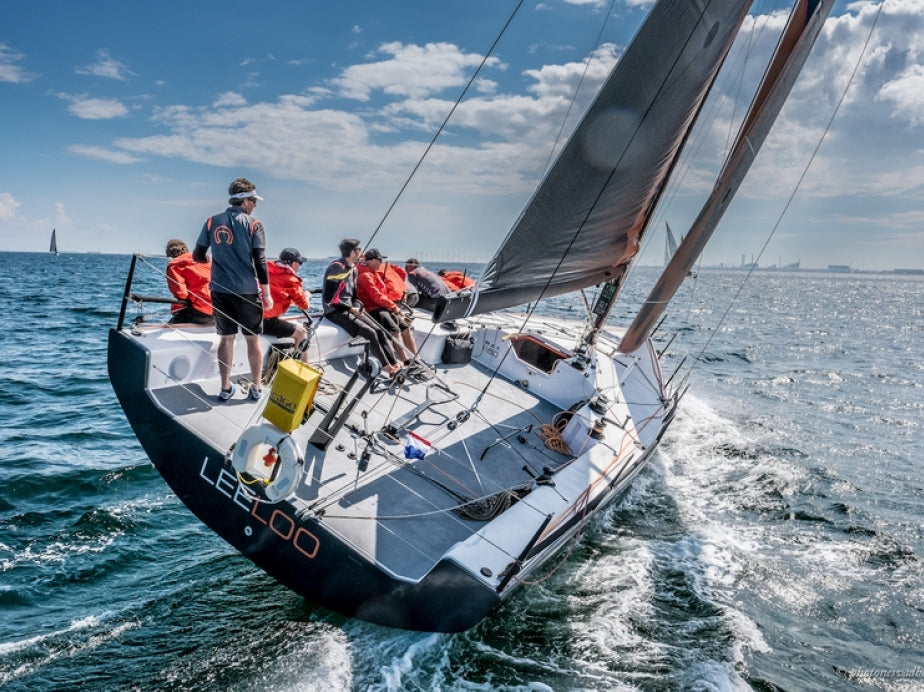
EVEN VOORSTELLEN: TOM VAN DER VECHT
EVEN VOORSTELLEN: TOM VAN DER VECHT
North Sails Expert
📸 M32 World / Kevin Rio
Tom van der Vecht (36) is als Sail Expert verantwoordelijk voor de verkoop van zeilen. Samen met Wouter Köllmann runt hij de North Sails loft in Almere. Tom groeide op in Enkhuizen, omringd door inspirerende zeilers. Hoewel het racen hem niet meteen wist te bekoren, is hij nu een van de drijvende krachten achter Team LeeLoo, waarmee ze de lat steeds hoger leggen.
Wat is jouw eerste zeilervaring?
Mijn CWO 1, 2 en 3 heb ik behaald met mijn houten Optimist. Ook de clubwedstrijden in Enkhuizen gingen goed. Echter parkeerde ik het bootje bij de eerste Combi wedstrijd op de rotsen en riep heel hard dat ik dit nooit meer ging doen. Toch ben ik blijven zeilen, onder andere in de Splash, Laser en Hobie 18. Maar het wedstrijdzeilen heb ik pas later weer echt opgepakt met de boot van mijn ouders, een FF65.
Hoe ben je bij North Sails terecht gekomen?
Als student was ik zoekende. In eerste instantie dacht ik dat ik gymleraar wilde worden, maar na een jaar ALO ben ik hbo Leisure Management gaan doen. Ondertussen was ik gevraagd voor het talententeam van Team Heiner. Dat heb ik twee jaar gedaan, waarna ik voor Roy Heiner ben gaan werken. Onderhoud, schipperen en opleiden waren mijn kerntaken, op schepen zoals een Volvo 60 en J/109. Op een gegeven moment ben ik als zelfstandige wedstrijdteams gaan begeleiden, maar dat is heel intensief. Je bent veel van huis, dus toen er kinderen kwamen ben ik als verkoper/adviseur voor een vooraanstaande zeilmakerij gaan werken. Afgelopen oktober werd ik benaderd door North Sails en hebben ze mij gevraagd hun team te komen versterken.
Waarom heb je voor North Sails gekozen?
Iedereen kan in principe een zeil maken, maar in het ontwerp (de shape), afwerking en service, onderscheidt North Sails zich echt. Ik houd van ontwikkeling en innovatie. North Sails is het merk dat altijd vooruitloopt in de ontwikkeling en hierin anders durft te zijn dan de rest. Een voorbeeld voor mij is de stap van 3DL naar 3Di. We waren marktleider, maar kozen toch voor de uitdaging van een compleet nieuw product. Daarin zijn nu zoveel varianten zeildoek dat het niet alleen geschikt is voor wedstrijdzeilen, maar ook voor toerboten en superjachten.
Wat is het leukste aan jouw baan als Sail Expert?
In eerste instantie is het mijn taak om zeilen te verkopen, maar de meeste tijd besteed ik aan service, adviseren en meevaren met klanten. Het is leuk om samen met de klant tot een optimaal product te komen, wat precies past bij de wensen en eisen van de klant. Het komt voor dat dit compleet anders is dan wat ze vooraf verwachten. Uiteindelijk wil je dat een klant blij wordt zodra de zeilen worden gehesen. Als ze dan later zeggen ‘Dit is precies wat ik nodig had. Nu loop ik op deze rakken 8 knopen, waar dat voorheen maar 5,5 knoop was. Het IJsselmeer is daardoor kleiner geworden’, dan geeft dat veel voldoening.
Waar ben je het meeste trots op?
Als vader van drie ben ik het meeste trots op mijn gezin. Zeiltechnisch vind ik het knap wat we met Team LeeLoo hebben bereikt in acht jaar. We zijn (bij wijze van spreken) begonnen met; hoe hijs je een zeil. Inmiddels strijden we tegen America Cup toppers, Olympische zeilers en wereldkampioenen. En we winnen ook weleens een potje. Telkens als we zijn opgeklommen in een klasse, gaan we een stapje verder. Momenteel varen we met een M32 catamaran. Het gaat mij niet alleen om het winnen, want eigenlijk is het proces het leukste. Zeilen is de ultieme teamsport, dus het gaat om mensen. In de basis zijn we als Team LeeLoo nog steeds een vriendengroep.
Wat is jouw advies aan ambitieuze zeilers?
Doe wat je leuk vindt, dan word je er goed in en kom je ergens. Maar je wordt niet vanzelf ergens goed in, soms moet je er ook dingen voor laten. Ik had geen uitgestippeld carrièreplan, maar het zeilen is altijd belangrijk voor me geweest. Ik had zelfs een bijnaam; Tom ‘2 uur thuis’. Stappen was leuk, maar als ik de volgende dag moest zeilen, haakte ik toch op tijd af. Uiteindelijk ben ik blij dat ik het zo heb aangepakt, want ik ben toch maar mooi hier terecht gekomen!
READ MORE
READ MORE

DRIE NEDERLANDSE ORC TOPPERS
DRIE NEDERLANDSE ORC TOPPERS, ALLEMAAL NORTH SAILS ZEILERS
De Nummers 1 Aan Het Woord Over de North Sea Regatta
Team Van Uden - foto: Twirre Bogaard
“Fantastisch om na de coronapandemie eindelijk weer zo’n groot evenement in Nederland te varen, met een grote diversiteit aan klasses en 800 man op het water,” blikt Nic Bol, Sales Manager North Sails Benelux, terug op de North Sea Regatta, welke van 4 tot en met 6 juni 2022 werd gevaren vanuit Scheveningen. De uitslag is er ook eentje om trots op te zijn; alle winnaars in de ORC klasses zijn North Sails klanten. Maar komt dat puur door de zeilen en de nieuwste technieken zoals 3Di, of is er meer nodig om te winnen? Deze vraag legden we voor aan de drie winnaars in de ORC 1, ORC 2 en ORC 3.
Winnen begint bij goed onderhoud
Voor de ORC 1 en ORC 2 was het Nederlands Kampioenschap een optelsom van de Vuurschepen Race, de North Sea Race en de inshore wedstrijden tijdens de North Sea Regatta (NSR). In de ORC 2 gingen alle overwinningen naar één team: de Extra Djinn van Michel Dorsman, een X-362 sport. “We werden wel iets te vaak naar het podium geroepen,” lacht de schipper. “Aan de andere kant is het wel een groot compliment voor het team, aangezien we al jaren hard werken om zo hoog mogelijk te eindigen. Meestal zitten we wel in de top 3, maar we zitten er ook weleens naast. Nu zat alles mee.”
Tijdens de coronapandemie viel het niet mee om het team bij elkaar te houden, volgens Dorsman. “Toch is het team bijna helemaal intact gebleven, alleen missen we een tacticus. Daarom stapte Nic Bol op tijdens de North Sea Regatta. Ik ben al jaren North Sails klant. Inmiddels is onze hele set uitgevoerd in 3Di en naar alle tevredenheid.” Hoewel er soms wel gezocht moet worden naar de optimale setting. In zo’n geval staan de Sails Experts van North Sails klaar met advies, weet Dorsman. “Vorig jaar was ik aan het stoeien met het nieuwe grootzeil. We hadden veel roerdruk en kwamen niet goed in balans. Nic is toen aan boord geweest. Samen hebben we het nodige aangepast, waaronder de mastsetting, de neerhouderspanning en meer achterstag erin. Het is fijn dat Nic de puntjes op de ‘i’ weet te zetten.”
En dat deed hij ook aan boord tijdens de NSR, vertelt Dorsman. “Natuurlijk is het belangrijk om de goede kant op te varen. Zeker met de stroming en de ondieptes voor de Noordzeekust is dat een kunst. Maar Nic is ook een aanjager richting het team. Hij weet iedereen te motiveren om net dat stapje extra te zetten, nog beter te ‘hiken’.” Hoewel de handling van het team sowieso top is. “Op maandag werd er niet gevaren vanwege te harde wind, maar als we wel hadden geracet, was dat voor ons geen probleem geweest. We zijn goed op elkaar ingespeeld en weten ook dat de boot het aankan. Dat zit ‘m vooral in goed onderhoud van het materiaal. En als er onverhoopt toch iets kapotgaat, zorgen we er met het team voor dat we snel weer verder kunnen. Dat hebben we vorig jaar bij de Breskens Sailing Weekend nog laten zien toen de voorstag brak.”
Talenten leren van zeilontwerpers
Goed omspringen met het materiaal is ook het Van Uden team, onder leiding van Gerd-Jan Poortman, niet vreemd. De drievoudig deelnemer aan de Ocean Race is coach en schipper aan boord van de KER 46, waarmee 13 veelbelovende young professionals hun eerste stappen in het grote boten circuit zetten. Poortman: “Dit initiatief is geïnitieerd door KR&ZV De Maas om succesvolle dinghy zeilers een springplank te bieden. Zij zijn immers de ambassadeurs van de toekomst. We worden enorm geholpen door de industrie. Zo is North Sails een van onze partners en daar zijn we erg blij mee. Vooral met het 3Di principe dat zij leveren. Dat is exceptioneel goed. Het is zo duurzaam dat je met één set de wereld rond kan. Voor ons als team een uitkomst, want we hebben een gelimiteerd budget.”
Ondanks dat het pas de zesde keer was dat de jongeren deelnamen aan een ‘grote boten evenement’, ging het Van Uden team met de North Sea Regatta overwinning in de ORC 1 aan de haal. “Waanzinnig knap,” aldus hun coach. “We hebben iedere wedstrijd goed gepresteerd, zowel inshore als offshore laten zien dat we de disciplines beheersen en het opgenomen tegen zeer ervaren teams. Trainen en teamwork is echt key, maar ook kennis opdoen. North Sails is een bewezen voorloper op het gebied van ontwikkeling en design. We hebben veel contact met de ontwerper over het design van de zeilen. Er wordt echt de tijd genomen om alles uit te leggen aan het team. Deze ervaringen kan de jeugd meenemen. Dat ze dat ook doen, bewijst deze overwinning.”
Vasthouden aan het plan, later evalueren
Ondanks dat er op de maandag niet werd gevaren, waren de vijf gevaren races wel voldoende voor een geldig kampioenschap in de ORC 1 en ORC 2. In de ORC 3 was dat niet het geval vanwege te weinig deelnemers; drie in plaats van de benodigde tien boten. Hoewel winnaar Kees Keetels dat betreurt, is hij nog steeds regerend Nederlands Kampioen in de ORC 3, aangezien hij tijdens de laatste editie de titel in de wacht sleepte.
Kees Keetels vaart op zijn A-31, de CSi Rakker, met een vast team van vrienden en familie. “We maken er een feestje van, maar proberen toch mee te doen met de top.” Hoewel dat heel ontspannen klinkt, zit er de nodige effort in het team. “Niemand uit ons team zeilt van jongs af aan. We zijn allemaal theoretische mensen en bespreken graag met de zeilmaker de range van de zeilen. Op die manier halen we kennis van buiten naar binnen. Bij de Van Uden Reco race konden we de nummer één niet bijhouden. Dat hebben we toen besproken met Jacco Huijgen van North Sails en hebben we geleerd van zijn commentaar.”
Alle kennis noteert Keetels in ‘hun bijbel’. “Vooraf kijken we; wat hebben we genoteerd bij deze condities? En achteraf bespreken we hoe we alles nog verder kunnen verbeteren en leggen we dat vast. Daardoor weet iedereen precies wat ie moet doen tijdens de wedstrijd. Goede ideeën zijn altijd welkom, maar niet tijdens de race. Dat kunnen we volgende keer uittesten. Op die manier zijn we langzaam omhoog gekrabbeld, maar deze NSR was wel uitzonderlijk, aangezien we alle wedstrijden hebben gewonnen. Dat was ons nog nooit gelukt!”
Team Extra Djinn - foto: Twirre Bogaard
READ MORE
READ MORE
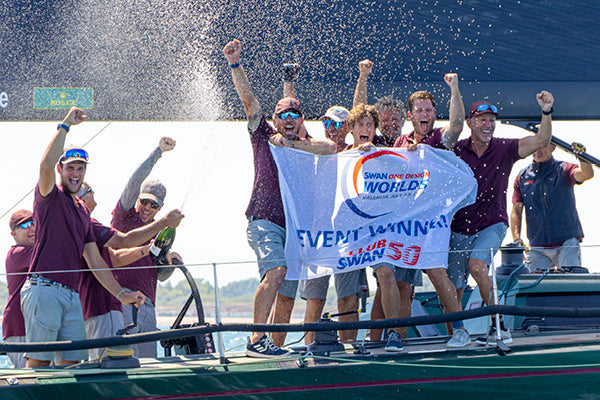
THE NORTH SAILS FORMULA FOR WINNING A WORLD CHAMPIONSHIP
Three new North Sails World Champions, just one place short of a sweep for the nine podium positions and all achieved at one regatta, the Swan One Design Worlds in Valencia.
READ MORE
READ MORE
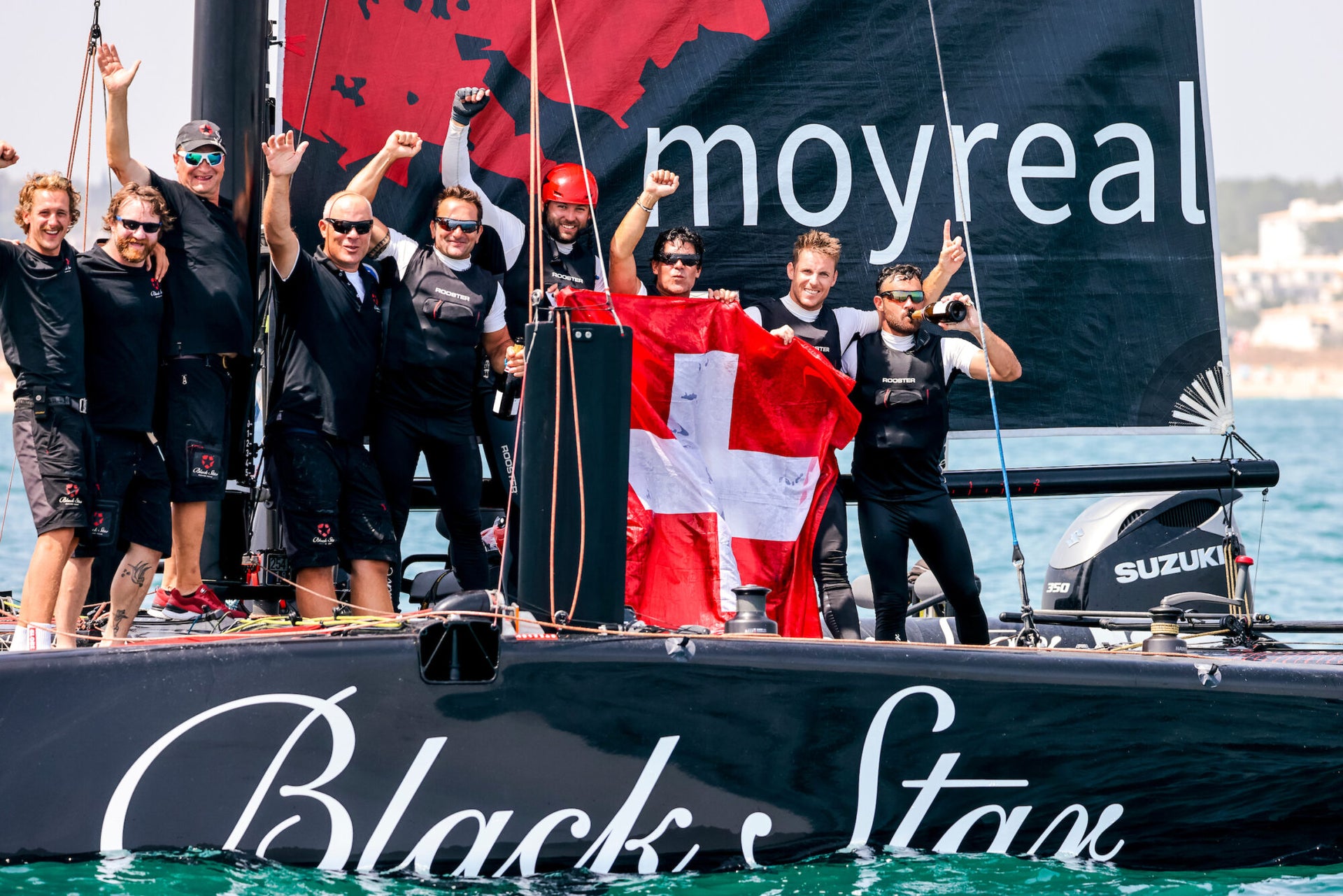
BLACK STAR SAILING TEAM BECOMES THE FOURTH GC32 WORLD CHAMPION
BLACK STAR WINS GC32 WORLD CHAMPIONSHIP IN EXCITING FINALE
Christian Zuerrer Improves Upon 2021 Performance to Top the Podium
📸 Sailing Energy
The GC32 World Championship in Lagos, Portugal, July 13-17, saw ten teams on the line to battle it out for the title. Three new teams joined the GC32 Racing Tour for its top event of the year: two newSailGP teams, K-Challenge Team France and Team Canada, as well as a new Polish campaign: Piotr Harasimowicz’s HRM Racing Team that would boost the owner-driver competition. Additionally, due to America’s Cup commitments, stand-out GC32 skipper, Alinghi Red Bull Racing’s Arnaud Psarofaghis, was unavailable to race the Worlds, handing it over to 24-year-old Maxime Bachelin. This leveled the playing field – would the contenders to the Swiss throne be Team Rockwool Racing or top owner-driver Erik Maris and Zoulou, who had podiumed in the pre-Worlds three weeks earlier?
Ultimately the field consisted of ten teams from seven nations competing at the GC32 Worlds, including Simon Delzoppo’s .film AUS Racing from Australia and USA’s Jason Carroll’s Argo, with Paul Goodison calling tactics.
Despite predictions, on the opening day there was a surprise stand-out team: the GC32 newbies on K-Challenge Team France, skippered by Nacra 17 Olympian Quentin Delapierre. The team scored three bullets in five races, despite the mix of reaching and upwind starts, with conditions that started light but built to 20 knots. The increased winds enabled the nimble flying catamarans to reach speeds up to 30 knots.
📸 Sailing Energy
In the five races held the following day, the French SailGP team was again the lowest scoring team, and at the halfway point held a solid 10 point lead.
However at this point a new star was already on the ascent and it was Black. Christian Zuerrer’s Black Star Sailing Team is unique for being a privately-owned team with Zuerrer trimming main, leaving Kiwi match racer Chris Steele to helm. The team joined the GC32 Racing Tour in 2019 and stepped up to reach the podium in 2021. Day two of the GC32 World Championship saw this Swiss team win two races, however they struggled to find consistency, but this would not be the case for the final two days.
The second half of the Worlds was held mostly in sub-10 knot conditions yet still provided top level competition. At this point the GC32 World Championship became a two horse race between the French and Swiss and even Alinghi Red Bull Racing was struggling to keep up. Over the next seven races, the two previously mentioned stand-out teams won every race save one which was taken by Team Tilt, skippered by Sebastien Schneiter. It wasn’t until the penultimate race that Black Star Sailing Team took the lead overall, sealing the deal by winning the final race as a technical issue caused the French leaders to plummet to ninth. Black Star Sailing Team became the fourth GC32 World Champions as Erik Maris’ Zoulou won the Owner-Driver trophy.
“We are very proud of the association between the GC32 Racing Tour and North Sails, as its official supplier,” said Paul Westlake. “We are pleased to see this top level, high energy racing circuit for foiling catamarans continuing to thrive.”
The GC32 Racing Tour will conclude with its final 2022 event in October.
📸 Sailing Energy
READ MORE
READ MORE
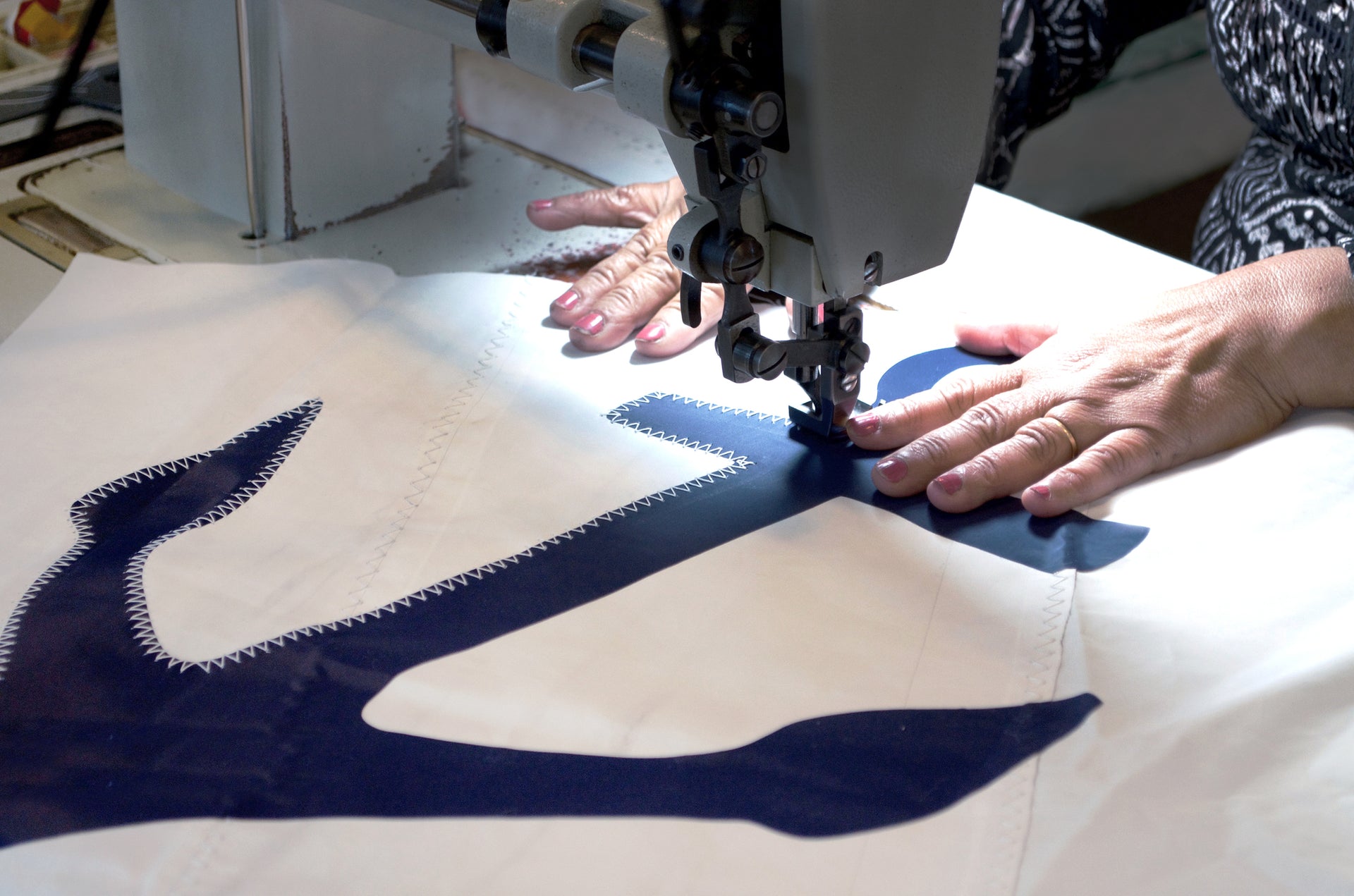
NORTH SAILS & SEA BAGS LAUNCH SUSTAINABILITY PARTNERSHIP
North Sails and Sea Bags teamed up on a sustainability initiative to divert retired sails from the landfill and pave the way for the sailing community to collectively reduce waste.
READ MORE
READ MORE
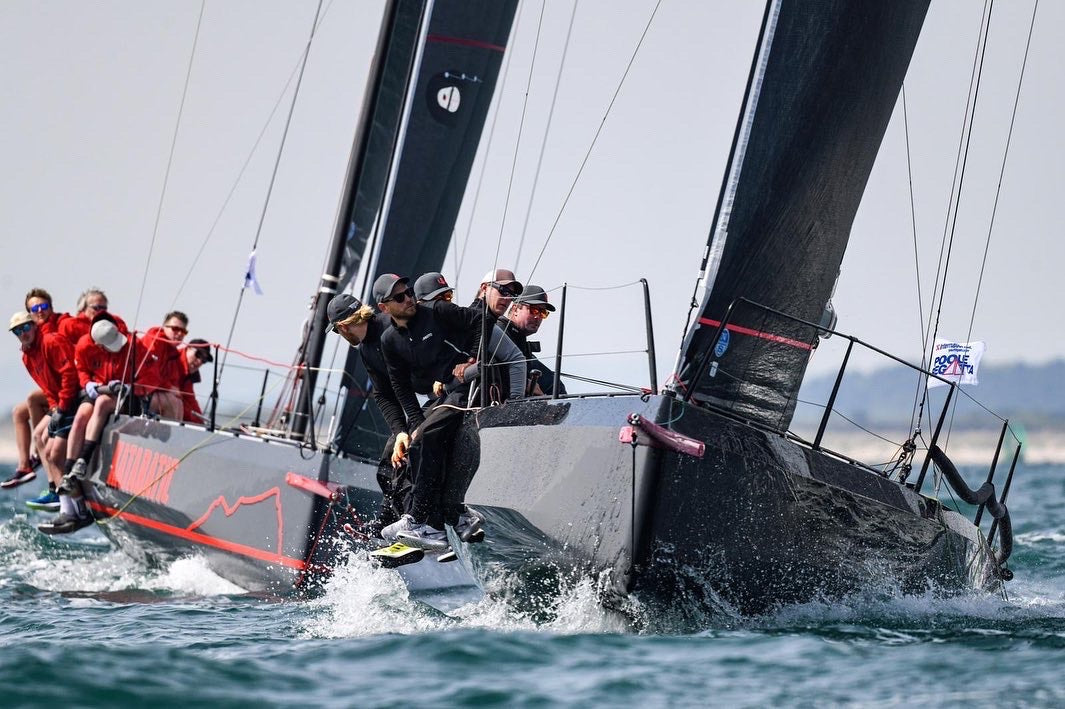
NORTH SAILS TEAM AT THE 196TH COWES WEEK
One Week to go to Cowes Week 2022
Photo Credit: James Tomlinson / Cape 31 UK
Cowes Week, aptly named after its host town in the Isle of White, is one of the world's longest running and most successful sporting events. The regatta has been held in early August every year since 1826, except during the two World Wars and is a key highlight of the British sailing summer. It’s the range from classic and cruising yachts to the high performance designs of the moment that gives Cowes Week its uniqueness. The spectacle the racing provides along the foreshore of the town and the vibrant festival atmosphere attracts not only sailors from around the world but thousands of visitors to Cowes during the event.
With over 300 boats entered in this year's Cowes Week, the event is on track to be the biggest in recent years; the XOD class has had the largest early entry with 35 teams. All 21 One Design classes are also starting to stack up including 18 Cape 31’s, 29 J70’s, as well as Performance Cruiser and Club Cruiser classes and seven IRC classes. The class to watch is the New Cape 31 class with over 20 boats on the start line.
We’re proud to be supporting some of our local North Sails team members across the fleets including; Ben Saxton on Cape 31 Tokoloshe, the current UK 31 Race Circuit leader, Ronan Grealish and the Harrison Family sailing their new Cape 31 to match their TP52 Jolt and finally, Mike Henning competing for the Overall Cowes Week Cup on board HH42, INO XXX.
North Sails newest team member Ian Walker will be christening his first week at North by joining North Sails expert Ruaridh Wright and long-standing North customer Ian Atkins on Dark n’ Stormy a GP42. The team will be following up on their Overall win at the Round the Island Race that took place at the end of June.
One to also watch is Yes! (JPK1080), long standing North Sails customer Adam Gosling who has been racing at Cowes Week for over three decades. In various yachts, all called Yes!, Adam is one of the most successful skippers in the 192 year history of the regatta, winning his class on 15 occasions and Black Group overall on four occasions. He missed out on the class win by one point to fellow North Customer David Frank on J112e Leon last year... Will he get back on his winning streak this year?
Our North Sails team will also be providing North Sails Certified Service during the regatta at the North Sails Cowes Loft in Cowes Yacht Haven. North Sails service expert James Hobson will be on site to assist with all your sail care needs during the regatta. The legacy of this long-standing regatta is based in world-class racing, but it’s also a wonderfully social week where friends old and new come together to support the sailors, discuss innovation and have fun in a great mix of social activities.
Keep up to date with the North Sails Victory List to see how your favorite North Sails expert or team is fairing throughout the week.
READ MORE
READ MORE
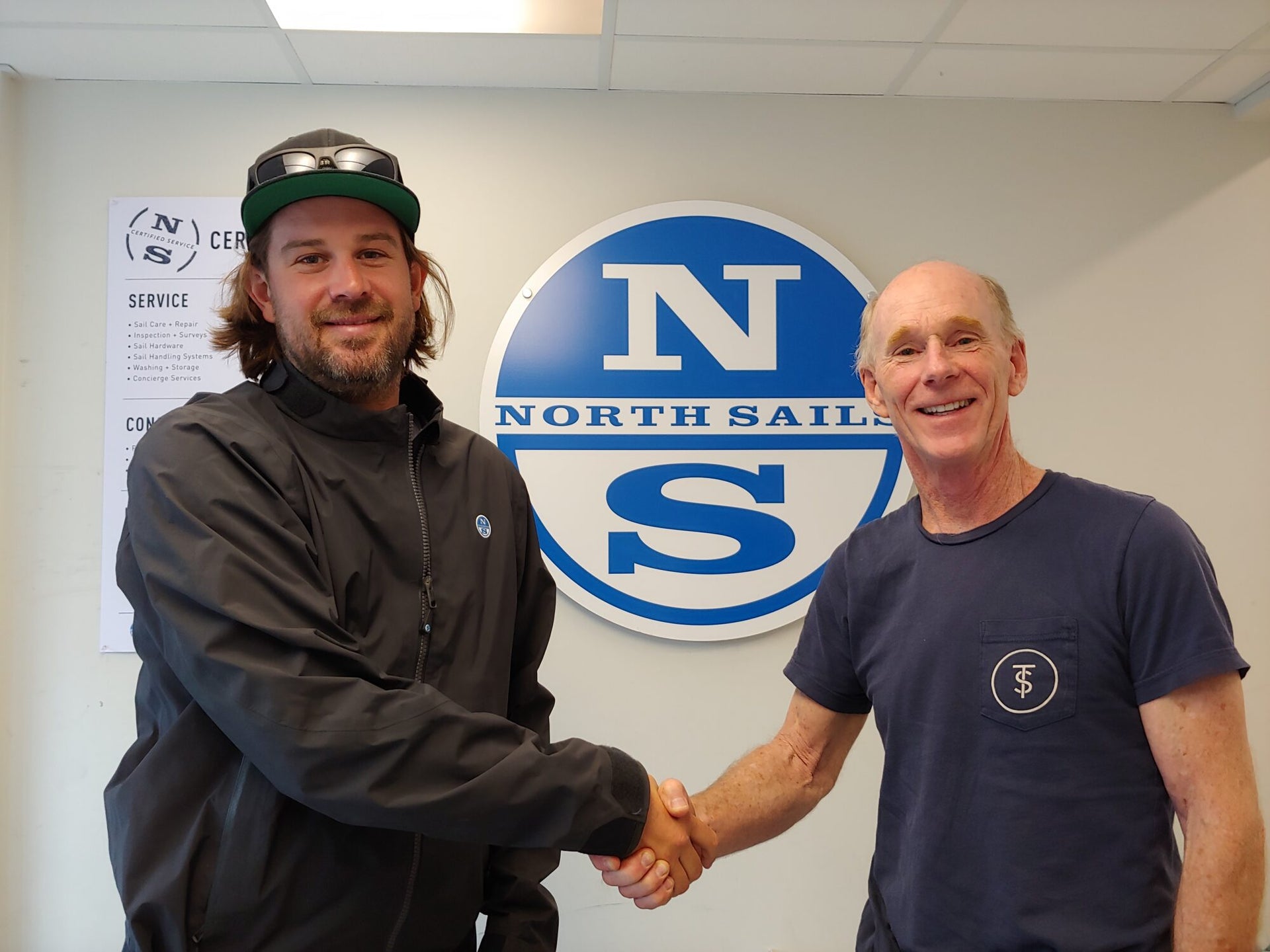
EVENT SPOTLIGHT: VYC REGATTA
EVENT SPOTLIGHT: VYC REGATTA
North Sails Smooths The Water For Annual Regatta
The 2022 Vernon Yacht Club Regatta was a great success with 26 boats and well over 100 sailors participating from 4 clubs, including Penticton, Summerland, Kelowna, and Vernon. Some great winds picked up the racer’s spirits on Friday afternoon during the pre-regatta Rum Race from Whiskey Island to the Vernon Yacht Club. Budd Callis and crew on Controlled Skid (Penticton) took the prize. Regular regatta racing on Saturday and Sunday had more subdued winds and lots of liquid sunshine but spirits were high. Lyle Enns on Mystique (Vernon), with his brand new North Sails headsail took 1st place in the Santana fleet. Danny Foster on Shadowfax (Kelowna) took 1st in A fleet, and Harvey Ryll on Wildfire (Summerland) took 1st in C fleet. This year’s regatta committee encouraged more relaxed racers to join in a white sail fleet and Gerard Obbema on Quintessence (Summerland) took 1st in the fleet of 8. Congratulations to Harvey Ryll on Wildfire who won the overall award. No regatta is complete without the competitors feeling the thrill of a big win. Sometimes that win comes with a trophy for top notch racing, but for many it’s that anticipation that their winning ticket will let them head home with a goody that will come in handy for their next sailing adventure. During the awards ceremony most participants don’t walk to the podium to receive a 1st place finish, but they sure love taking part in the afternoon ceremony when the North Sails and Nautical Sailing Services swag is presented to lucky door prize winners. This year Drew Mitchell and the North Sails crew in Vancouver came up big by providing the Vernon Yacht Club Regatta with hats, belts, shirts, croakies and water bottles that will help keep these competitors coming back for future events. This years Vernon Regatta was not the windiest or the driest, but all the competitors had high praise for the camaraderie and also for the value they received for their entry fee. The extra value provided by the generosity of North Sails, Nautical Sailing Services and other fine community supporters helped make the VYC Regatta a big success.
READ MORE
READ MORE
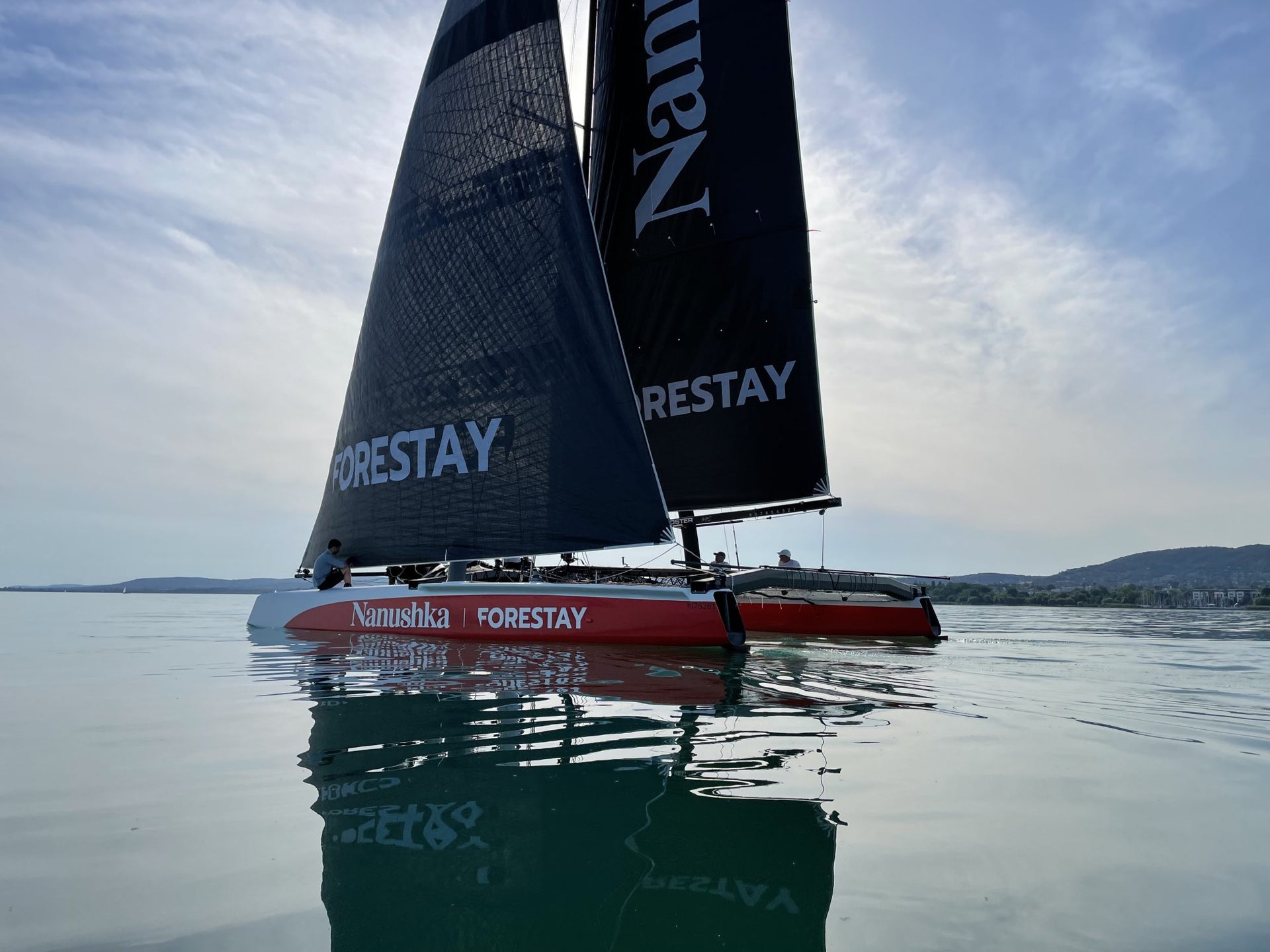
NANUSHKA FORESTAY SAILING TEAM
Nanushka Forestay Sailing Team 2022-es versenyszezonra a testek frissítése, újrafestésével párhuzamban tervezte lecserélni a teljes vitorlakészletét. Vitorlák beszerzésében a csapat komoly tapasztalata és a kompromisszum mentes hozzáállás volt a döntő. NORTH SAILS 3Di kompozit vitorlákra esett a választásuk. Csapat: Horváth Áron, Botos Bálint, Várady-Szabó János, Petheő Tamás, Lukáts Csaba, Jankovics Gábor.
📸NANUSHKA FORESTAY SAILING TEAM
READ MORE
READ MORE
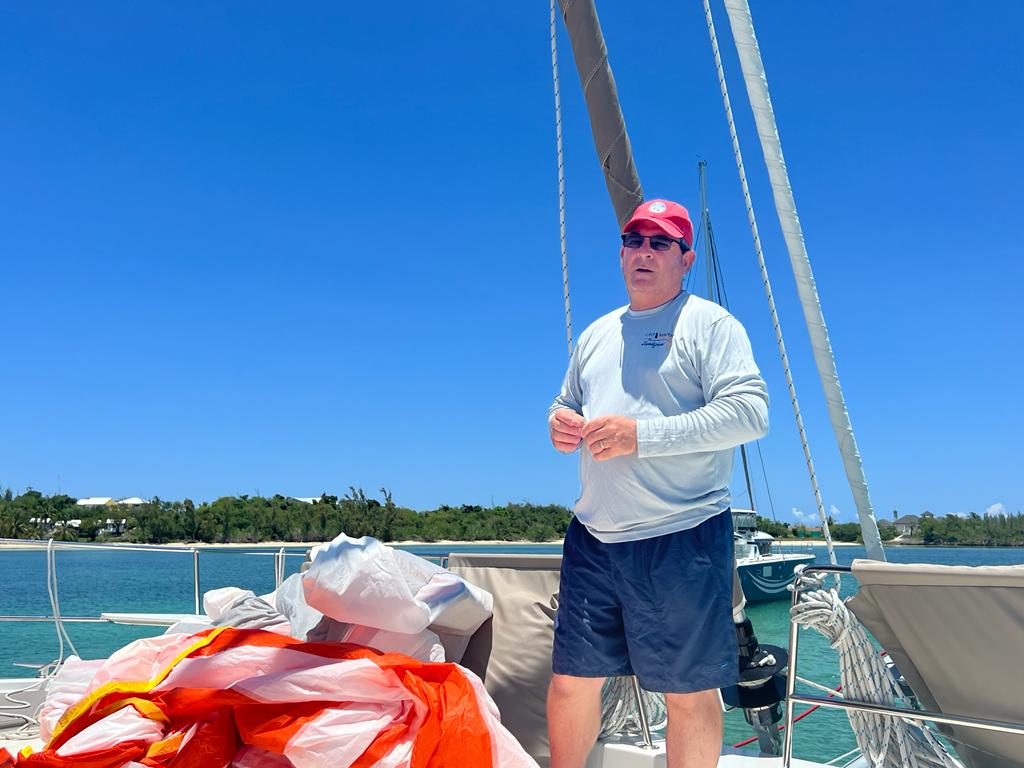
EVENT SPOTLIGHT: CATGURU RENDEZVOUS
EVENT SPOTLIGHT: CATGURU RENDEZVOUS
Weekend of Fun and Learning with North Sails Expert Bob Meagher
After a two-year COVID hiatus, Stephen and Estelle Cockcroft of Catamaran Guru reinvigorated their Abacos catamaran Rendezvous and attracted 27 catamarans to rally to and through the northeastern Bahamas last month. Naturally, North Sails jumped in with North Sails multihull expert Bob Meagher arriving on a Monday evening when the party was just winding down. Tuesday morning featured a short distance race with a 10:00 start off of White Sound, with the fleet of 25 cats flying a variety of sails to catch the southwest breeze. Boats flew sails in the widest range of configurations, with winged genoas and mains, gull-winged genoas and screechers, asymmetrical spinnakers sheeted to either side off either bow, with mainsails doused, reefed, or full depending on how each crew thought they’d serve best. Meagher chased them all, offering trim tips to each competitor, guiding them through experimenting with different setups, commenting "rallies like this are about learning: by doing it and seeing what works, by watching others, and from outside advice." A dying breeze gave the race committee time to restock with ice before shortening the course to enable an on-time happy hour at Grabbers on Guana Cay. Continued light breezes forced a leisurely motor sail the next day to Green Turtle Cay, home of the Bluff House, as the evening's host. But first, there was more learning to be had! Half the fleet gathered aboard Zuri, the Cockcroft's own Bali 5.4, where Meagher led a hands-on class in setting, sailing, and dousing asymmetrical spinnakers. Almost two dozen people participated. “Our goal with this annual rendezvous is two-fold. We lead our group on our own cruising catamaran to the islands to help them gain confidence and to show our boat owners a good time. But more importantly, we invite our industry colleagues like Bob, to help educate the boat owners on how to operate certain components of their boats and therefore better enjoy their boats. Bob did not disappoint and we are very grateful to North Sails and Bob for generously donating his time and expertise.“ The fleet capped off the week with the awards party ashore at Bluff House. Rick Walker's Voyage 430 Endangered Species claimed first prize in the previous day’s races (using a rare thing on a cat - a spinnaker pole!), and other prizes were awarded for more… creative competitions when the sun went down. All-in-all, the Catamaran Guru Rendezvous highlighted the best about sailing: fun with friends, and learning to improve. North Sails was happy to help with both.
READ MORE
READ MORE

NORTH SAILS AND SORC CONTINUE PARTNERSHIP
NORTH SAILS & SORC CONTINUE PARTNERSHIP
North Sails Chosen As Official Performance Partner of 2022-2023 Edition
North Sails is pleased to announce its continued partnership with Southern Ocean Racing Conference for the 2022-2023 edition. The series consists of four distance races that draw a fleet from across the country and includes a range of yachts from super maxis to corinthian cruisers. The series prides itself on accessibility for a wide variety of sailors and offers storied races from South Florida to destinations like Key West, Nassau, Palm Beach, and Cape Canaveral.
North Sails will continue to work with participants to help them prepare and plan for the series of four races. As the Official Performance Partner, North Sails experts will be offering measurement days across the South East lofts and an educational webinar on ORC Ratings. The measurement days will provide participants an opportunity to discuss their inventory with North Sails experts and how to optimize their rating, have their sails measured and drop them off for any necessary pre-race service. Stay tuned for dates and timing.
“SORC is a fabled brand that continues to challenge sailors of all skill levels today. This initiative helps teams plan for first class winter sailing and get the most out of their sails,” shares North Sails expert Bob Meagher.
As the industry leader, North Sails is committed to helping clients achieve success whether it’s their first race or thirtieth. We look forward to supporting SORC participants in their journey throughout the 2022- 2023 SORC series.
READ MORE
READ MORE
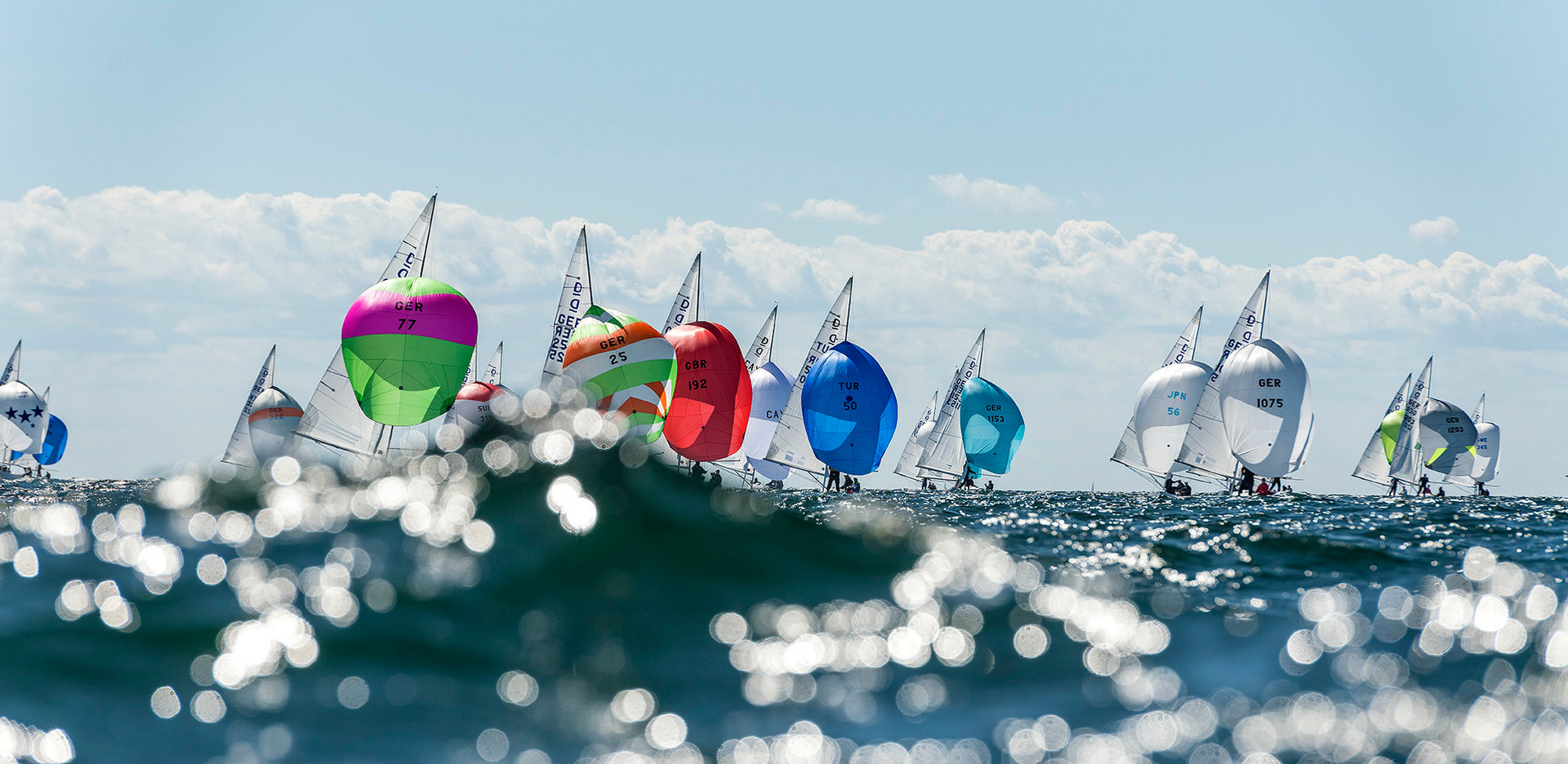
THE QUEEN'S DRAGON
BLUEBOTTLE – THE QUEEN’S DRAGON
Racing Royalty: 74-Year Old Classic Races 2022 Dragon World Championships
📸 Tom Körber
“Take the measurement certificate, for example, it says the owner, and it’s… well, Her Majesty the Queen. So, when you go to the regatta office to register and they’re looking at it… they’re taking photographs and they can’t believe it.” The speaker was Graham Bailey, and we were talking about Bluebottle, the 74-year old classic that he had just helped Ruairidh (Rory) Scott – a leading designer with North One Design – sail to a fifth place at the 2022 Dragon Worlds in Germany.
Bluebottle was a wedding gift from the Island Sailing Club to the-then Princess Elizabeth and Prince Phillip in 1948. She was raced by the Royal couple, and others – winning bronze at the 1956 Olympics in Melbourne in the hands of Graham Mann – before being retired from racing in 1961.
Bluebottle spent the next forty years at the Royal Naval College in Dartmouth. “I’m told that no cadet dare use her for fear of pranging her,” said Bailey. “So, she was sort of a precious, unusable item… until she was taken in by the National Maritime Museum in Cornwall.”
It was Bob Downie, the far-sighted CEO of The Royal Yacht Britannia Trust that rescued her and brought her back to the racetrack. Downie was already responsible for the remarkable second life of the Royal Yacht Britannia, now a superb tourist attraction in Edinburgh, and home to two other royal yachts, the ocean racer Bloodhound, and the Flying Fifteen, Coweslip.
Downie was given custodianship of Bluebottle, and this is where Bailey – a long-time Dragon devotee – came into the picture. “He was seeking guidance on who best to restore her,” said Bailey. It was David Heritage Racing Yachts of Cowes that got the job. The question was, how complete a restoration should be undertaken?
“They kept on referring to the Duke,” explained Bailey, “and he kept on saying, ‘Well, yes, if we’re going to restore her, we might as well restore her properly, not just to be on display again in another museum… Let’s put her into sailing condition.’” And then sailing condition became racing condition, and slowly the plan was hatched to get Bluebottle back on the water where she belonged. At the front of the world’s Dragon fleets.
📸 Tom Körber
📸 Tom Körber
Sadly, the passing of the Duke of Edinburgh in April 2021 meant that he never got to see his beautifully restored Dragon, but the loss of the Duke didn’t change the plan. Bailey and his wife Julia were asked by the Palace to race her – to take the Duke of Edinburgh’s boat to the Edinburgh Cup in Edinburgh. “She was last raced in 1961, it was a full 60 years until she crossed a start line ,” explained Bailey, after they came third at the event last summer.
It was such a success that the team decided to go to the Worlds. “Rory kindly agreed to come with us… he’s about the hottest property in Dragon racing at the moment,” said Bailey. “He’s just won the Europeans and has had stunning successes whatever he’s done.”
“We’d never sailed together as a team or at all, or on that boat… and no one had a clue how we would go,” explained Scott. “We opened with a 22nd or something like that, and then from that point on, all our results were top ten.”
“I can’t understate Rory’s contribution to getting her rolling,” said Bailey. “The first couple of races, we weren’t really able to hold a lane… but we fiddled about for a couple of days, and then all of a sudden, we started hitting some sweet spots.”
“We put all our standard sails on it,” said Scott. “We have a light, a medium, and a heavy genoa, our latest R5 Spinnaker, and they already had a mainsail, which was the A7. We offer two designs, a deeper one (A7) and a flatter one (A14). And this was the deeper one, which suited that boat very well because the mast was pretty soft.
“We managed to get in a position where we were one of five boats going into the last race that was capable of winning. And as it was, it didn’t go our way,” added Scott. They got a black flag in the final race. “At least we were pushing to do our best,” he concluded. “It was a pretty cool experience, to be asked and to be involved.” Finishing fifth, Bluebottle’s result – at the grand old age of 74 – was the icing on the cake, with North Sails powering the top three overall.
There is little doubt that Bluebottle is a very special Dragon. “We were packing the boat up and an elderly gentleman turns up on his bike. He’s cycled from the next village because he’d been reading in the newspapers about Bluebottle and he wanted to see her himself,” recalled Bailey. “She’s got her own charisma.”
📸 Tom Körber
READ MORE
READ MORE
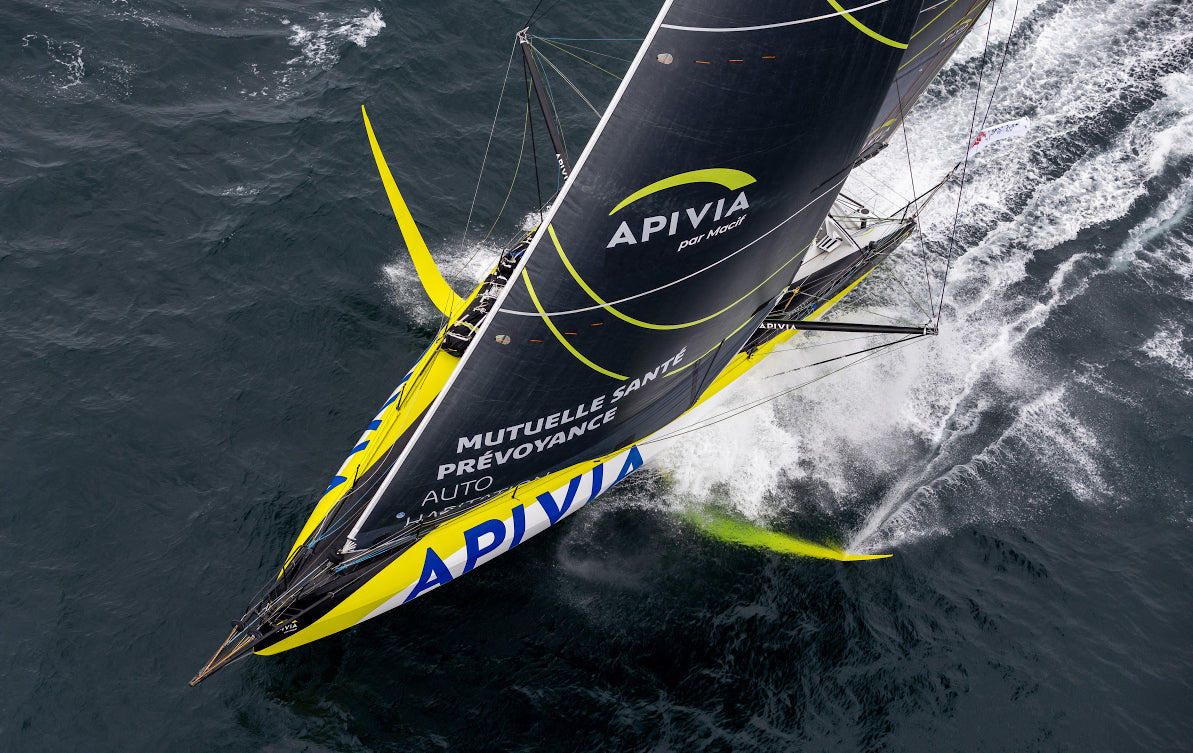
#NSVICTORYLIST: 2022 VENDÉE-ARCTIQUE
#NSVICTORYLIST: VENDÉE ARCTIQUE
Familiar Faces Crowd the Podium After 1200 NM Cold Weather Course
Dalin, Beyou, Ruyant. By now, these names are likely familiar to you, and if not, don’t fret; North Sails will help get you up to speed. The top three boats completed the 1200 nm Vendée Arctique course a short four days after they first departed on June 12th. Dalin’s Apivia was first to finish, a trend that’s becoming a habit for the solo skipper. If you remember, Dalin was also the first boat to complete the grueling 2020-21 Vendee Globe and then followed it up with a first-place finish in the 2021 Rolex Fastnet Race. Charal’s Jérémie Beyou and LinkedOut’s Thomas Ruyant closely followed Dalin, with the top three Vendée Arctique finishers arriving into Les Sable d’ Olonne within seven hours of each other.
The Vendée Arctique is the first of five qualifying races for the 2024 Vendée Globe. The planned course is a demanding loop course that takes competitors on an unprecedented sailing adventure into an arctic environment. The skippers set off single-handed and non-stop towards the Arctic Circle, expected to sail around Iceland and navigate through the weather systems in the rough seas of the far north before returning to the race’s home port in France.
But the weather conditions proved more challenging than expected for the 2022 edition. Race officials determined a strong low-pressure system in the North Atlantic near Iceland was churning to be more dangerous than first forecasted. As a result, the race was shortened and the finish moved to the Iceland Gate – to the east of Iceland.
View this post on Instagram
A post shared by Vendée Arctique (@vendeearctique)
Of the 25 skippers participating in the 2022 race, 16 are Vendée Globe veterans, and they’ve chosen North Sails to help them deliver the results they and their sponsors expect. The North Sails team knows that sailors have a choice among sailmakers. Our market share within the IMOCA class is a result of the best people paired with the best product and a competitive spirit that never quits.
“Innovation and going beyond is the North Sails DNA,” remarked Gautier Segrent, Head of North Sails France. “Our presence in the IMOCA class is because of years of intensive development that translates into three main elements; our investment in the creation of innovative products such as 3Di and Helix Structured Luff; our strong involvement and North Design Suite software available to the design teams from the very first drafts; and finally, our hands-on support for custom projects to best meet the expectations of the teams.”
A longtime collaborator with the individual teams, North Sails stepped up their support and signed on as an official supplier for the 2022 Vendée Arctique. North Sails France Managing Director Philippe Touet commented: “The North Sails involvement as an official supplier of the Vendée Arctique is closely linked to our relationship with the racers of the Vendée Arctique and the Vendée Globe; the two major offshore races organized by the Vendée SAEM. These events are both the playground and a testing ground for North Sails. So partnering with the Vendée SAEM in the second edition of this race was an obvious choice.”
The next edition of the Vendée Globe commences in November 2024. These next two years will see sailors putting their boats through the paces and testing their equipment to its limits. Their onboard experiences will provide critical feedback for the North Sails design team to continually tweak and optimize the IMOCA sail inventories. They often say you win races before you even reach the start line, and with the first event completed, the race is on.
READ MORE
READ MORE
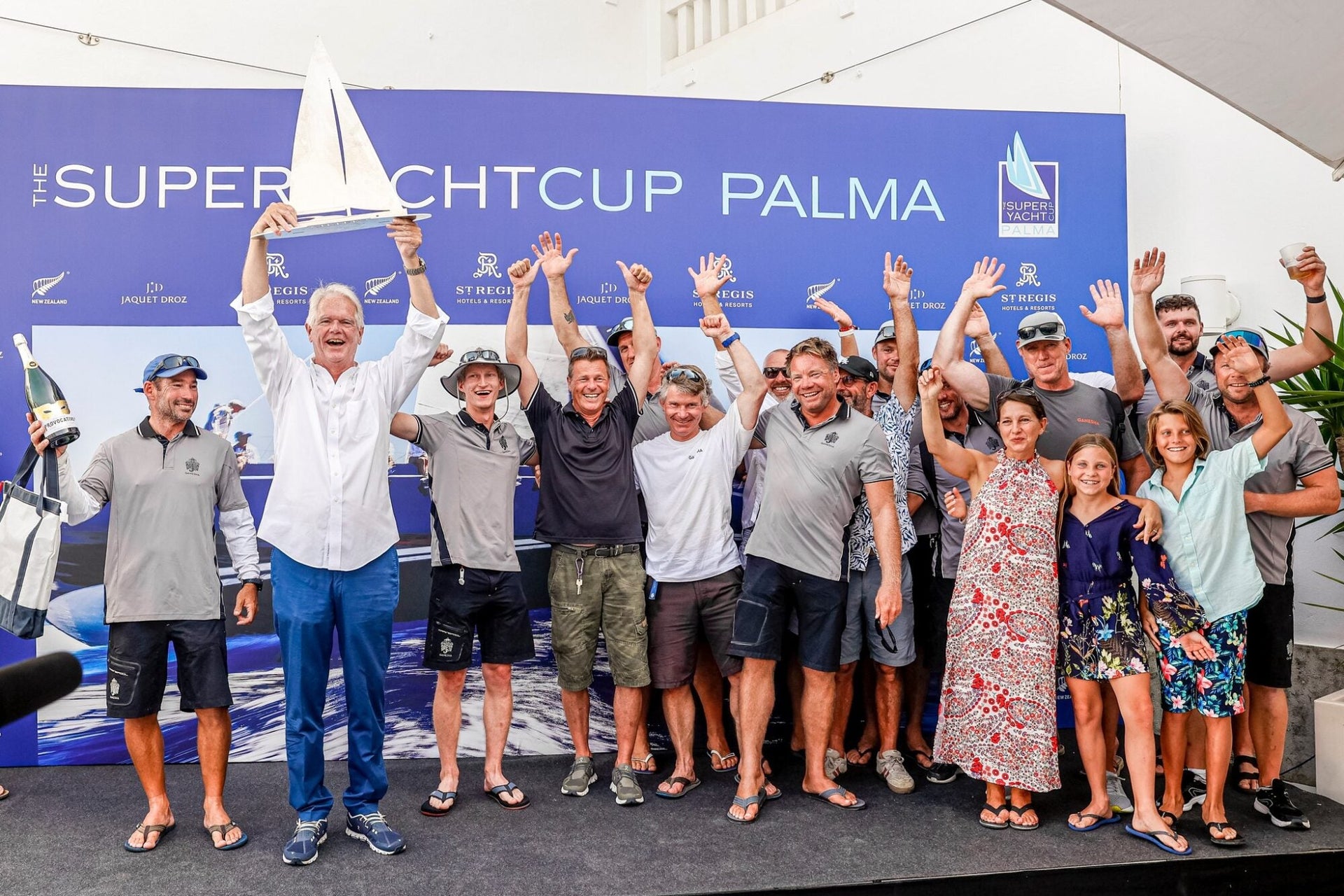
#NSVICTORYLIST: SUPERYACHT CUP PALMA 2022
#NSVICTORYLIST: SUPERYACHT CUP PALMA
North-Powered Superyachts Sweep Podium & Ganesha Claims Winner Overall
With all but one of the participating superyachts outfitted with North Sails, we knew the Superyacht Cup Palma would bring a handful of new entries to the #NSVictoryList, but in what combination?
The event came down to the last race of the regatta, and in the end, Ganesha claimed Overall victory in addition to her Class B win. J Class Svea won the J Class division while Kiboko Tres took the top spot amongst the A Class.
“It was a bit of a surprise win, and we certainly weren’t expecting it, either the class or the overall,” commented Ganesha skipper Alex Pamment. “It was very, very close. Yesterday we came second by one second, but today the weather gods were with us, and we were able to get a result. The tacticians had it tough, but we were able to make the right calls.”
The Superyacht Cup Palma is one of the most anticipated regattas on the superyacht summer calendar. This year’s event saw eleven yachts competing across three classes with nine North Sails experts onboard throughout the fleet.
View this post on Instagram
A post shared by The Superyacht Cup Palma (@thesuperyachtcuppalma)
Superyacht Sales Leader Jens Christensen and Palma-based Mark Salder sailed on Ganesha. North Sails Palma Service Manager Tom Webb stepped off the loft floor to join the Savannah crew, who claimed second in Class B.
The J Class Svea bolstered their race crew with recent North addition Bouwe Bekking, Grand Prix Sales Leader Paul Westlake, and Superyacht Leader Quinny Houry. The Superyacht Cup is Svea’s first regatta under a new ownership group, and the rumor on the dock is that they trained hard in the days leading up to the event.
“We are thrilled, delighted to have won our class – we are over the moon,” said Svea co-owner Niklas Zennström. “We came to this event having put in a training week before to get to know it, as many of us have never sailed a J Class before. To win the class is very special, much more than we expected as this was going to be a learning regatta.”
📸 Sailing Energy
Also scattered across the J Class division, Heine Sorensen, sailmaker to Topaz, was on board to see his work in action and was joined by North colleague Eckard Kaller. Meanwhile, Tom Dodson from North Sails New Zealand assumed his established race crew position with Velsheda.
North Sails is a longtime sponsor of the Superyacht Cup Palma. Whether onboard with clients or dockside with the Palma-based service team, this is an all-hands-on-deck event. Additionally, our sister-companies Southern Spars and North Actionsports, joined us to support the regatta. North Sails teamed up with Southern to host the post-racing social event on Thursday, and each of the three podium positions was gifted one of the recently launched North Standup Paddleboards.
A huge thank you to the event organizers who power through long days to ensure this event runs smoothly. See you in 2023.
📸 Sailing Energy
READ MORE
READ MORE
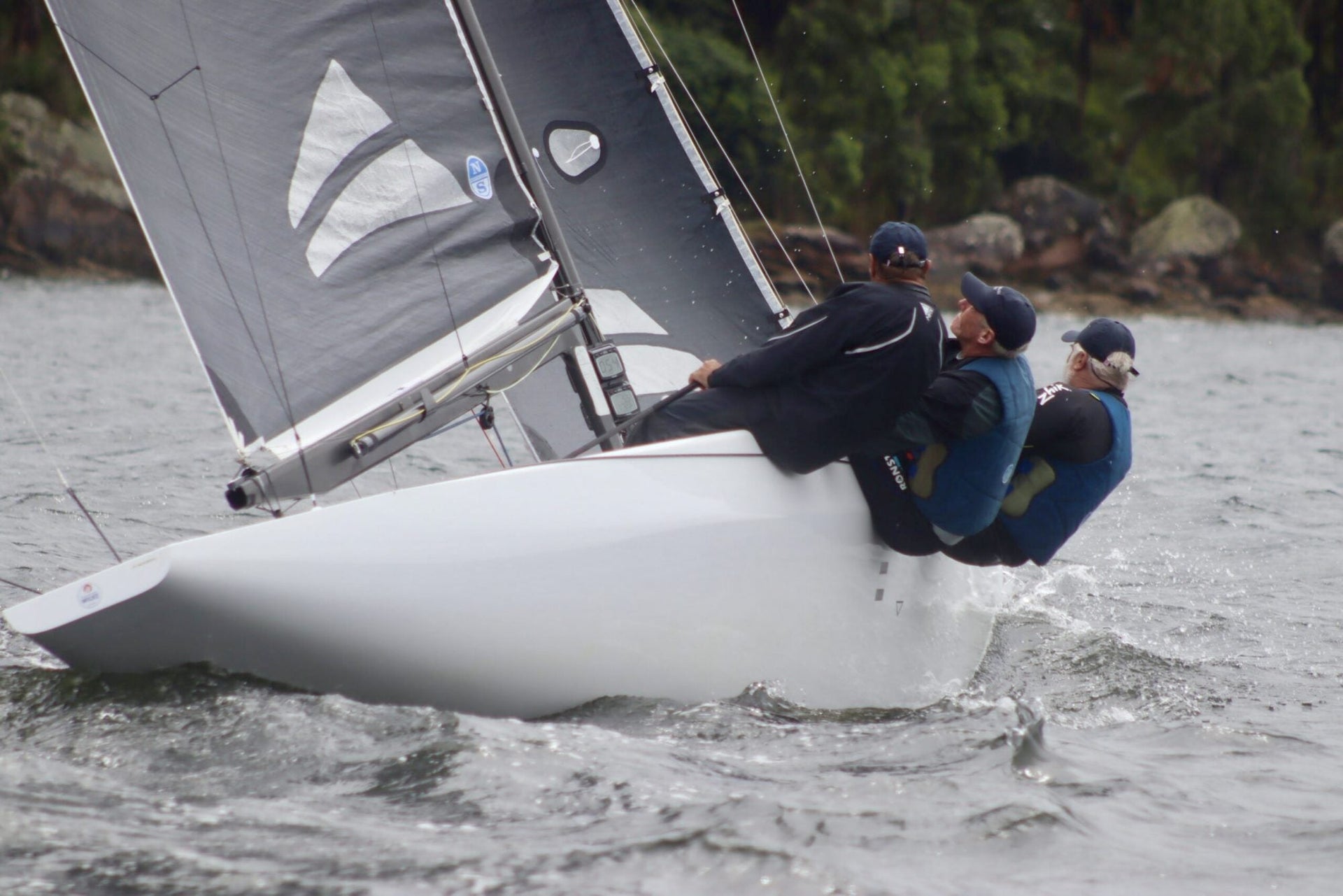
AUSTRALIA’S JOHN BACON - FROM 5.5M SAILOR TO IRC RACER
AUSTRALIA’S JOHN BACON – FROM 5.5M SAILOR TO IRC RACER
Taking on the World With North Sails
World Champion yachtsman John Bacon has arranged many successful racing programs together, and his next few months of sailing is no exception. With a range of sailing projects on the go, John’s also contesting two exciting regattas in two vastly different racing yachts on two continents in the next month: the 5.5m World Championships in Hanko, Norway, and the Rolex New York Yacht Club Race Week in Rhode Island, USA on his new Dunning 44.
Stepping Up in Sydney
Growing up on the water, John had always sailed with his family and friends. However it wasn’t until a change of scene to Sydney’s Pittwater that gave the yachtsman a push into the racing side of the sport, and after crewing on various yachts, he realized it was about time to pull together his own team.
“I enjoyed crewing, but I really liked steering – and I thought the only way I’d do any steering is to buy a boat. So, I started with a little boat and began to upgrade and work my way up through a series of different boats and ended up at the Royal Prince Alfred Yacht Club (RPA). I was happy doing keel boat handicap racing and had a pretty nice Sydney 39 and it was a pretty good IRC boat where we did really well in that. That’s where I started to get involved with North Sails, with getting better sails and crew with that boat. I’ve used North Sails from the get go in all my campaigns, and now, it’s never a question of using anything else.”
Jumping into One Design racing with a McConaghy 38, John knew the next step was to assemble a competitive program to race against the best.
“I got to know David Sampson and Cameron Miles, and although we knew each other already, we got to form a really tight-knit team together at RPA, and just loved it! We’ve had a great relationship with Norths through the MC38 program and it was never a question of using anything else. We sailed that boat for 10 years everywhere! We did every regatta, and I think we won one nationals and came second a few times.”
The Challenge of 5.5m Sailing
The 5.5m development class all race on the same start line, however the fleet is scored in three divisions according to their age, as Classics, Evolutions, and Moderns. The Evolution is where John saw his next pursuit as the world championships were coming to his home waters in Australia.
“As my time started to free up I was doing less work, I got interested in the 5.5m. I really loved the concept of 5.5ms and was really drawn into it. The boats are all different, it’s all in a box rule. They’ve got different designers, different sail plans, as one boat may be good on a Swiss Lake, whereas another one is really good at the Baltic. They’ve all got this character of their own.”
“We bought an old Evolution boat in Europe, in the 1973 to 1993 division, and we thought we’d go sail it and do the German Open Regatta, but the poor boat was a wreck, so I got a mate of mine over in Europe to completely restore it for the worlds in 2019 in Helsinki as a bit of a practice. Terry Wetton, James Mayjor and I formed this really nice team, and we ended up winning both regattas, it was just amazing.”
“After the 2019 worlds, we brought the boat back to Australia, and RPA was hosting the worlds in January 2020, so instead of trying to win it at our home club we had to defend our title. And we did!
From Evolution to Modern
John’s decided to level up and compete in the main Modern division for the upcoming 2022 5.5 metre World Championship in Hanko, but the change in division is all the same racing for him and his team.
“Everyone’s on the same start line. You’ve got boats that could be up to 70 years old on the line with new modern styles. So within the fleet, it’s actually a really interesting strategic point of view among the divisions, as the speed differential between the divisions is not that much. With 5.5ms it’s actually about the equipment.”
When discussing the North Sails inventory, John’s vision for the development of his team includes tweaking and recutting the North Sails designs to suit the racing conditions he expects.
“We’ve done some fantastic work with Darren Jones, our coach, working with Alby Pratt and the designers on coming up with some really nice sails. We’ve gone away a little from the One Design sails, and we’ve got a full wardrobe of 3Di sails. But we’ve looked at some light air paneled sails as well as an option, which is a work in progress that we’re going to look at in Hanko.”
When asked about how quickly the class progresses, John’s passion for the project shines through. “There are a couple of new sails turning up for us, and the good thing about 5.5m is that it’s a development class. You get to push the development of the class further each time you make a change, and I really like that. It’s good and when you turn up with something a bit different and it works for you, it’s fantastic!”
Where John has spent the most time developing are with his spinnakers, optimizing the inventory for the class minimum and maximum wind speeds for racing, between 4 and 25 knots, allowing him to extend the crossover of the larger spinnaker and remove the smaller spinnaker completely from the boat.
“North Sails has been amazing and we’ve got a great relationship. It’s fundamental to what we’re doing with the program, so we’ve got some nice new sails meeting us when we get over there and we’re looking forward to getting out there on the water.”
New Project for Race Week in Newport
Racing his Dunning 44 at 2022 Rolex New York Yacht Club Race Week fits perfectly into the packed schedule John has planned for this year, but he hasn’t yet seen the boat he plans to race with his international crew of mates looking to have fun.
“We had an opportunity to buy a Dunning 44 in Newport, Rhode Island, called The Edge. And I love it there. We haven’t travelled for the last couple of years, and the Rolex New York Yacht Club Race Week regatta is on in July this year, originally we didn’t think we could fit it in, but it fits perfectly as it’s the week after.”
“It’s going to be a bit of a scramble, and somewhere we talked Ken Read into doing tactics for us, and Suzy Leech is navigating too. So I’m going to be surrounded by all these absolute legends. And then we look at the entry list, and it’s the who’s who of big boat racing.”
“I am where I am in sailing because of the relationships I’ve got with people, and I really respect that and am really grateful for it. And I am a North Sails customer, but you get more than the sails, you get everything. The development, the help with that development, the backup, the support, and you know if we blow a spinnaker up in Norway, I guarantee you we can get it fixed.”
“So we’re working with the North Sails loft in Newport for the Dunning 44. The boat’s brand new, it’s only done two regattas. The sails that are coming with the boat are okay, but we want to keep moving, so we’ve ordered another North Sails spinnaker and a medium jib, and we’re doing a recut of the main to a more specific design that Ken Read has been part of. The boat’s got lots of potential but it’s going to be another massive challenge to sail against some of the competition we’re up against, but we’ll see!”
Offshore Sailing on the Horizon
John also played an integral part in the launch of the first Farr X2, owning the first of the newly designed short handed yachts to Australia to help get the project underway. “The Farr X2 is going well. We recently sailed it from Sydney Harbour up to RPAYC in Pittwater. For me, I really love the projects, and I got involved with Bret Perry and the guys, and I thought this was a project that needed to start happening.”
However, John isn’t planning on sailing the Farr X2 himself in the short term, as he’s given it to two young female sailors to launch their double handed offshore racing campaign.
“I’d done a two handed campaign with David Sampson before, and then Alice Tarnawski came to me and said she wanted to do some two-handed female sailing, and the timing for the Farr X2 to be built worked out well. It was something that was a really cool project to do, and Alice and Clare Costanzo have teamed up and are one hundred percent into it!”
“I’ve got a lot on myself so I’ve kind of said to the girls it’s their project, and they’re going to race it in the Sydney to Gold Coast race, so we’re doing everything we can to get them to Hobart. In the meantime I’m looking forward to doing a bit of offshore sailing in it for sure, but the main program is to get Alice and Clare to Southport and then get them on the start line to Hobart on Boxing Day.”
READ MORE
READ MORE
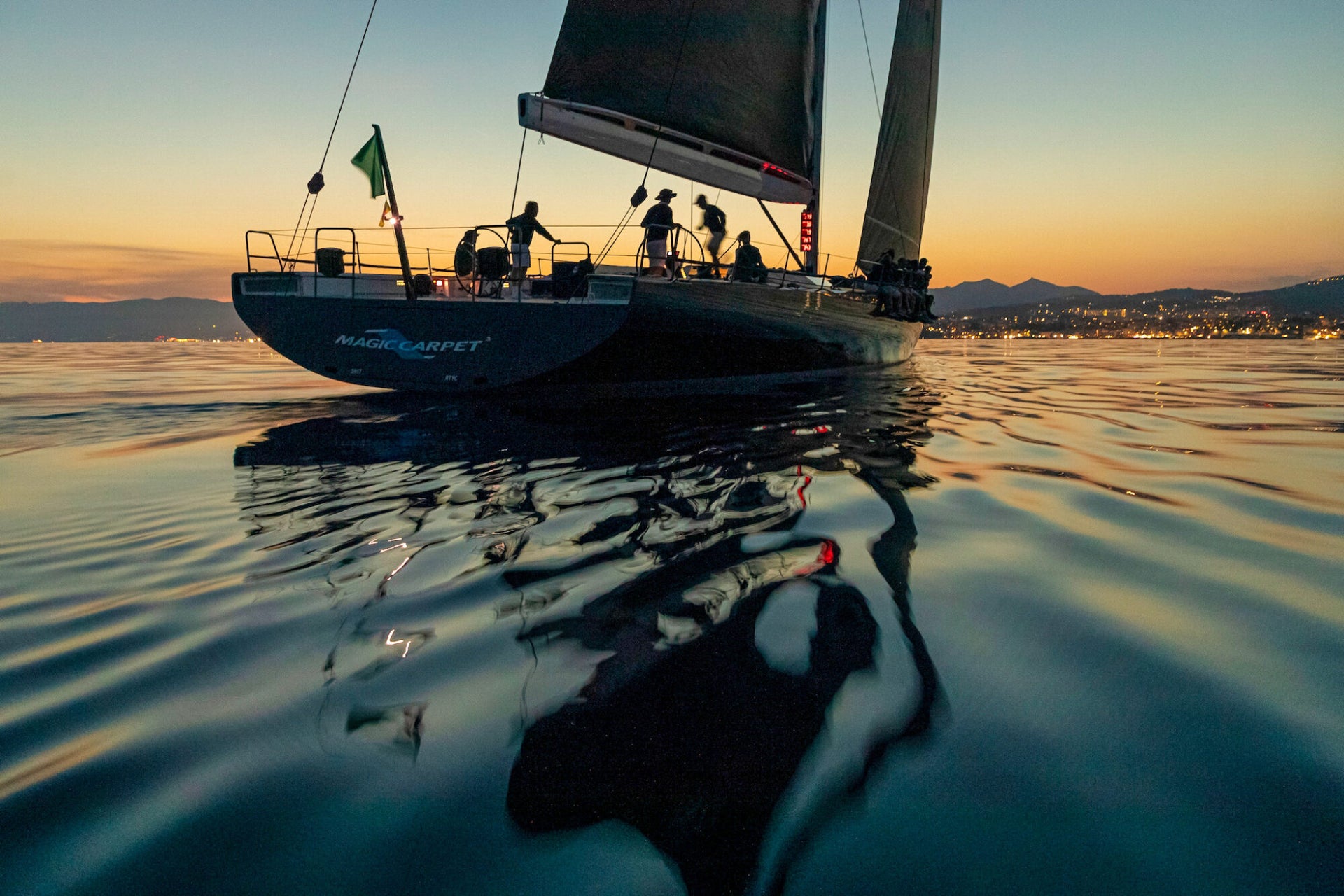
#NSVICTORYLIST: 2022 ROLEX GIRAGLIA
#NSVICTORYLIST: 2022 ROLEX GIRAGLIA
North Sails Clients Dominate at the 69th Edition of this Classic Event
📸 ROLEX / Carlo Borlenghi
Founded in 1953, to help unite the French and Italian sailing communities post World War 2, the Giraglia has retained a distinct Franco-Italian spirit, while attracting an international fleet with typically over 200 yachts from more than 25 countries.
The headline act at the Rolex Giraglia is the 241-nautical mile (446km) offshore race from Saint-Tropez to Genoa, Italy, via the Giraglia rock located approximately 1 nm (2km) off the northern tip of Corsica. In keeping with a number of great races, the Giraglia rock is used as a symbolic turning mark.
Sanremo to Saint-Tropez Race:
The first North Sails victory was in the first racing scheduled, where the 56 yachts competed in the Sanremo – Saint-Tropez distance race, with a midnight start. After 15 hours of slow sailing, the Felci 71 Itacentodue, owned by Adriano Calvini, crossed the finish line in Saint-Tropez to claim line honors. All the boats in the top spots of the first act of the Giraglia carried a full North Sails sail inventory.
Saint-Tropez Inshore Races:
Following the first event, the Gulf of Saint-Tropez once again lived up to its reputation as a fantastic regatta venue, with excellent weather conditions allowing the event’s 3-day inshore racing to take place without a hitch. While the maxi yachts competed on windward-leeward courses off the beaches of Pampelonne, the rest of the boats battled on coastal routes. Wind conditions were consistent throughout the regatta, with an initial easterly breeze of 6 knots increasing over the course of the event, and fairly flat seas.
#NSVictoryList:
Final results from the Maxi race course in Pampelonne after 4 races are:
IRC0: Jethou, owned by Peter Ogden, dominated in the IRC0 class. (1,1,1,1);
IRC2: Capricorno, owned by Alessandro Del Bono (1,1,1,1);
ORC0: Leaps & Bounds 2, owned by Jean Philippe Blanpain (1,1,1,1).
For the ORC and IRC groups, the results after 3 inshore races are as follows:
IRC 1: Daguet 3 – Ker 46 owned by Frederic Puzin (12,2,2);
ORC 1: From Now On – Swan 45 owned by Fernando Chain (4,1,1)
📸 ROLEX / Carlo Borlenghi
Saint-Tropez to Genoa Offshore Race:
June 15th was the start of the iconic offshore race, the headline act at the Rolex Giraglia. The forecast, which called for light winds, prompted the race committee to shorten the regular 241-nautical mile (446km) course by 35-nm. A decision which afforded the majority of the fleet a greater opportunity to finish the race ahead of the Saturday morning cut-off time. 105 of the competing boats were able to complete the race in the allotted time. In the spirit that has always defined the Rolex Giraglia, these predominantly Corinthian crews demonstrated their ability to confront the challenge with patience and skill.
Setting blistering speeds is often the prerogative of the maxi yachts competing at this event. The frontrunners included three former line honors winners, ARCA SGR (triumphant in 2021 and with North Sail designer Michele Malandra among the crew), Magic Carpet Cubed (2013 and 2016) and Tango (2018). Their hopes of overturning the race record set in 2012 (just under 15 hours) were immediately thwarted by the forecast. Ultimately, the 69th edition produced the slowest line honors time since 2009. Although a thrilling tactical battle did ensue between some of the world’s most experienced and skilled navigators.
The tempo of the race provided the opportunity for more considered tactical discussions across teams and an emphasis on maximizing every wind gust. The light breeze was not the only hurdle faced in this year’s edition, the last stretch to the finish line in Genoa is notoriously difficult to negotiate. Sir Lindsay Owen-Jones and his Magic Carpet Cubed team (with North Sails expert Gigio Russo and recent hire Ian Walker onboard) have experienced its highs and lows. Just a few nautical miles from the finish line and having trailed ARCA SGR from the race’s emblematic turning point, the Giraglia rock, the Magic Carpet Cubed crew mustered their considerable race pedigree, positioning themselves at the better wind angle to propel themselves into first place. The Wallycento completed the course in an elapsed time of 34 hours, seven minutes and 17 seconds.
ARCA SGR navigator Malandra commented, “After rounding the Giraglia islet 9 seconds behind MC3 and having led most of the regatta, the Giraglia proved that it is never predictable. We have always sailed very well, even with a boat designed for other wind conditions, but after the refit by Shaun Carkeek, she proved to be reborn. Thanks to our new North sail inventory and the 5-meter taller mast, we have considerably increased the sail area of the boat. However, we missed the two landings (in Giraglia and Genoa) of which the second is fundamental! But we are satisfied to have sailed fast and to honor the winners.”
📸 ROLEX / Carlo Borlenghi
READ MORE
READ MORE

DARK ’N’ STORMY’S ALL ROUND
DARK ’N’ STORMY’S ALL ROUND
From Dinghy Sailing to Roaring Around The Solent on a GP42
Photo © Paul Wyeth
Fresh from his triple triumph at this year's Round the Island Race taking Monohull Line Honours, winning IRC Zero and the race overall we caught up with Ian Atkins, owner of GP42 Dark ’N’ Stormy, long standing North Sails customer and sailing enthusiast. From learning to sail in a Mirror dinghy from Hamble River Sailing Club in the 60’s to roaring around the Solent on GP42 Dark ’N’ Stormy (ex Jean Genie) in 2022; Ian has had quite the sailing career. Born and brought up in Hamble, England, Ian sparked his love for sailing as a kid on the Hamble River with dinghies. His love for sailing morphed into his career when he joined the North Sails team in the early 80’s. After a few years at North and making some great connections, Ian joined and subsequently ran yacht sales company Ancasta. He spent the next 10-15 years in the sales business whilst also sailing professionally both inshore and offshore on various race boats. Ian was also heavily involved with Beneteau race boats as they came onto the scene. Off the water, in 2000 Ian was one of the founders of online marketplace, boats.com. On the water he was campaigning a series of small one design boats. With stints in a 1720, J80 and J70 Ian built up a series of good results with his own teams. Several J80 and J70 Nationals wins and a fourth at the J70 World Championships in 2015 were the highlights for the team. After 2 years out of the game, while selling his business, Ian came back wondering what his next steps were. Fast forward to 2019, Ian put his sights towards the new IC37 One-Design. Along with Nick Griffifths and Ancasta, they purchased the first IC37 with the goal of it being promoted as a One Design class. Whilst racing around in the IC37 having a great time, they kept being overtaken by Fast 40s, which sparked the idea of the Fast 40. Ian reflected, “if I’m going to go big boat sailing I need one of those” so he bought Peter Morton’s Jean Genie in October 2021. He renamed her Dark ’N’ Stormy after his team’s favorite post race tipple. Whilst Ian explained that 2022 is about “getting to know the boat, and learning how to sail it,” the team has already been getting some top results. From literally taking home the chocolates at the Royal Ocean Racing Club Easter Challenge (the prizes being chocolate easter eggs) to being runner up to Niklas Zennström’s Ran at the 2022 IRC National Championships, it’s fair to say that the team has gotten to know the boat pretty well. With the recent Round the Island victory to top it off the only way is up for Ian and his crew.
Dark 'N' Stormy crew after their Round the Island Race Victory. North Sails team members Ruaridh Wright (right), Ian Walker (second from left), Jono Macbeth (third from the left). Photo © Paul Wyeth
Ian has accredited the developments behind this success to boat Captain Nick Bonner, Ian Walker and Ruaridh Wright at North Sails, “I’m delighted to have got Ian Walker to come sailing with us and even more delighted that he committed to the whole season with us. Knowing that his new North Sails career will probably take him all over the planet, we're lucky to have the opportunity whilst it was available. Ruaridh Wright is our upwind trimmer and crew boss - he does a great job of making the boat go fast too. We are lucky in having the North expertise we have on board.” The next key event for the team is Cowes Week where Ian will be adding two new Helix Jibs and a spinnaker to his current full North Sails inventory. The team also hopes to be on the start line at the IRC Europeans in Holland later this year. North Sails is proud to have been a part of both Ian’s career and his sailing campaigns over the years and looks forward to following his progress in the future. To speak with Sail Expert Ruaridh Wright about maximizing your sail inventory, get in touch today.
Photo © Paul Wyeth
READ MORE
READ MORE
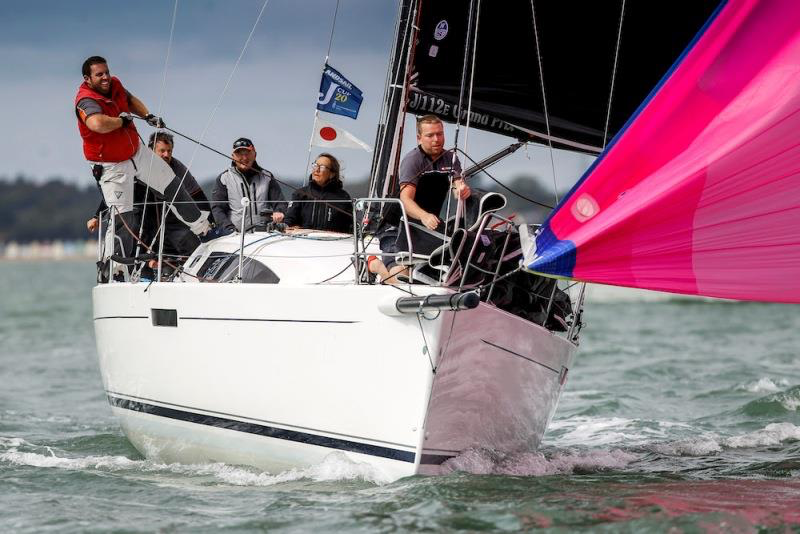
NORTH SAILS CONTINUES SUPPORT OF J CUP REGATTA
NORTH SAILS CONTINUES SUPPORT OF J CUP REGATTA
Key Yachting J Cup Regatta Outlook
Davanti Tyres, J112 - Landsail Tyres J-Cup - photo © Paul Wyeth
The 2022 J Cup Regatta is taking place from 30th June - 2nd July. Hosted by Key Yachting and the Royal Ocean Racing Club, the J-Cup is an annual regatta exclusively organized for racing yachts of the J/Boats brand, and all J/Boat models are invited to compete.
North Sails is thrilled to be supporting the event and competitors by providing on the water coaching with North Sail experts Ben Saxton; accompanied by drone footage from Shaun Roster. The North Sails loft in Cowes Yacht Haven will also be offering regatta repair service after sailing on Thursday and Friday. Connect with North Sails service expert James Hobson for all your service needs during the event.
Wayne Palmer, Owner of Key Yachting shares, “We are grateful for the ongoing support from North Sails with the J Cup Regatta and thrilled with the technical support they are providing.”
The regatta entails three days of exciting and competitive racing and incorporates the J/70, J/109 and J/111 National Championships. The program is coupled with a daily prize giving and lively shore-side entertainment to make the J-Cup a must for many of our owners and clients.
'The J-Cup is a highlight event in the J-Boat racing calendar every year. North Sails is delighted to continue supporting the regatta in 2022 and beyond, and we can't wait to see you all there'' said Ben Saxton.
The North Sails team will be scattered throughout the fleet with Jeremy Smart racing on McFly and Charlie Cumbley on Eat Sleep J Repeat. Ben Saxton, Pete Redmond and Ruaridh Wright will be in the coach boat over the weekend.
Stay tuned for updates over the weekend and keep an eye on results here and here.
Standfast, J70 - Landsail Tyres J-Cup - photo © Paul Wyeth
READ MORE
READ MORE

FÖRSNACK INFÖR BOHUSRACET OCH SHORTHAND-SM
FÖRSNACK INFÖR BOHUSRACET OCH SHORTHAND-SM
Vem tar hem det allra första SM-tecknet i shorthand-kappsegling? Det avgörs under Pantaenius Bohusracet 2022.
📸 Peter Gustafsson
På fredag förmiddag går startskottet för 2022 års upplaga av Pantaenius Bohusracet. Det som gör årets tävling till något utöver det vanliga är att den i år har officiell status som svenskt mästerskap.
Totalt är snudd på hundra båtar anmälda till Bohusracet och över fyrtio är med och kämpar om SM-medaljerna. För att få segla SM krävs verifierat SRS-mätbrev, tävlingslicens och medlemskap i Svenska Havskappseglingsförbundet, och med tanke på detta är fyrtio båtar en bra siffra. Det kan faktiskt bli årets största SM-klass för kölbåtar.
Det finns många anledningar till att Pantaenius Bohusracet blivit så populär. För en del är det totalsegern – i år dessutom toppad med en SM-plakett – som hägrar. För andra är det äventyret och utmaningen som är det viktiga; bara att ta sig runt den 170 sjömil långa banan är en bedrift. Trevlig samvaro med regattamiddag dagen före start och fisksoppa efter målgång får man på köpet. Plus varsin exklusiv T-shirt som bevis för att man fullföljt det långa, krävande racet.
Starten går i Uddevalla och därifrån seglar tävlingsbåtarna söderut mot Marstrand. De rundar Hättebergets fyr och viker sedan norrut. Efter avstickare runt märken i Fjällbacka och Strömstad seglar de upp till Tresteinene i Norge, innan de vänder tillbaka mot målet i Smögen.
Till skillnad från exempelvis Gotland Runt är det inte någon havskappsegling utan en skärgårdssegling, så säkerhetskraven är modesta. Det finns exempelvis inte några krav på mantåg, vilket öppnar upp för ett brett spektrum av båtar. Man kan delta med nästan vilken båt som helst.
North Sails representeras i år av Andreas Turesson från North-loftet i Göteborg. Han kommer segla en X332:a tillsammans med sin pappa Dan. Far och son har framskjutna placeringar sedan tidigare och har siktet högt inställt.
"Men det är ett svårt race", säger Andreas. "Det brukar alltid finnas många tillfällen där det kan gå fel."
Att man någon gång under racet blir liggande i bleke är regel snarare än undantag. Var detta inträffar, och hur man klarar sig igenom det, blir ofta avgörande för slutresultatet.
Vill du följa kappseglingen så är kappseglingens Facebook-sida en bra början.
READ MORE
READ MORE
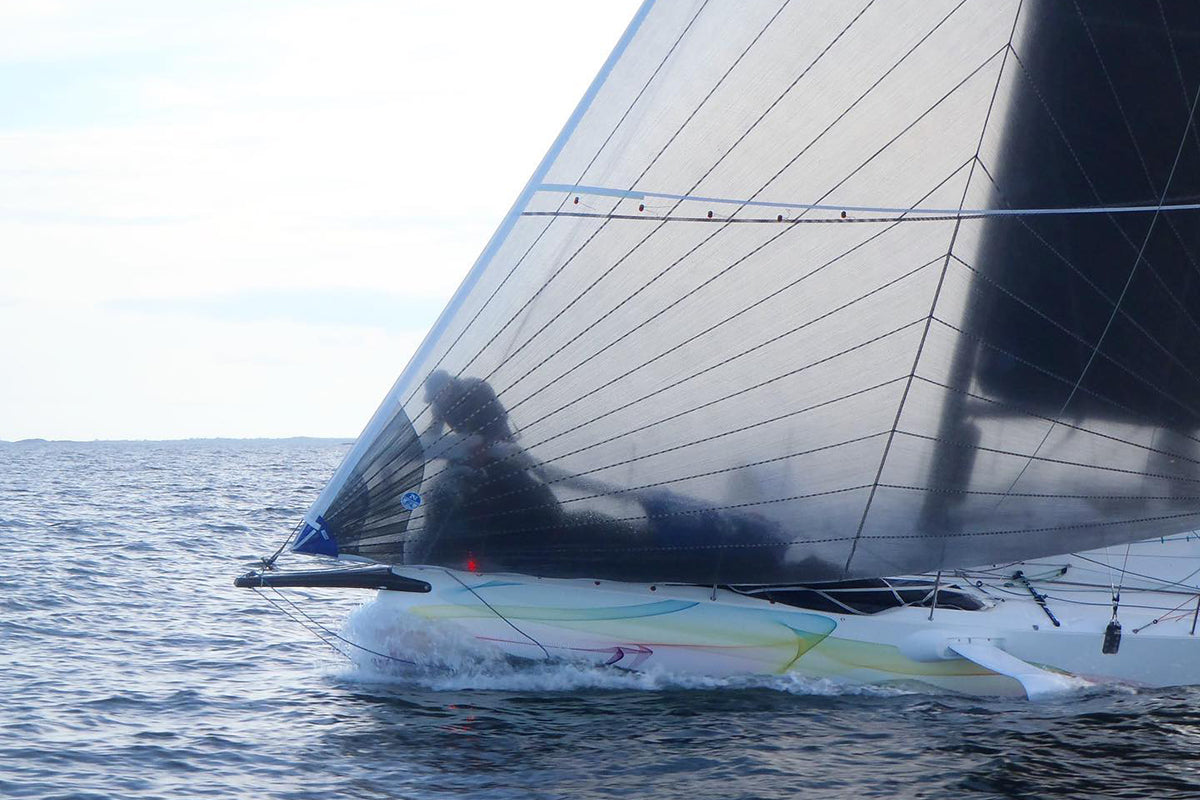
UPPSNACK INFÖR GOTLAND RUNT OCH SHORTHAND-VM
UPPSNACK INFÖR GOTLAND RUNT OCH SHORTHAND-VM
På söndag startar Gotland Runt. Att ORC Double Handed Worlds seglas parallellt på samma bana höjer temperaturen ytterligare.
📸 Anders Dahlsjö
Inte mindre än 225 båtar är anmälda till årets Gotland Runt. KSSS hade hoppats på runt 40 deltagare på shorthand-VM men det blev över 80. Det innebär att regattan totalt samlar över 300 båtar från 14 länder. Fantastiskt kul!
Om vi tittar lite närmare på VM-fältet kan vi konstatera att minsta båt är en Mini Transat på 21 fot, att den största är en Shogun 50 och att påfallande många ligger i spannet 30-36 fot. När detta skrivs är det ännu oklart hur klassindelningen ser ut, men gissningsvis blir det tre klasser.
Det känns inte meningsfullt att försöka utse några förhandsfavoriter. Men ur ett svenskt och nordiskt perspektiv finns det några besättningar som är värda att ha lite extra koll på. Anders Dahlsjö och Martin Strömberg i nya Z30+ är ett exempel. Team Pro4u, med Patrik Forsgren som skeppare, är ett annat. Patrik är en Sveriges allra mest framgångsrika havskappseglare och båten är mycket väl optimerad för ORCi.
Sunfast 3300:an Hyrrokkin med skepparen Sigmund Hertzberg från norska Tönsberg är ytterligare ett ekipage att ha under uppsikt. Båten är specifikt utvecklad för shorthand-segling, och de har förberett sig mycket väl inför VM. Att de var trea totalt på årets Raymarine2star och fyra på Kolfibedrrodret visar att de kan segla bra i Stockholms skärgård.
Och det kan visa sig vara väldigt viktigt. Starten för Gotland Runt och VM går nämligen precis utanför Gröna Lund. Tävlingen inleds alltså med inomskärssegling ut till Sandhamn. Sträckan är knixig och utmanande även för lokala seglare, och det ska bli intressant att se hur de utländska deltagarna hanterar det här. En del kommer ju från länder där det knappt finns skärgård över huvud taget.
Vi är förstås på plats både inför och under Gotland Runt – om du behöver hjälp med service eller reparationer är det bara att kontakta oss. Martin Angsell och Anders Lewander från North Sails Stockholm är för övrigt med på VM i varsin båt. Martin seglar Shogun 50 tillsammans med Anna Drougge, och Anders seglar Bénéteau Figaro 3 i par med Linnea Floser. Båda båtarna har lite nischade egenskaper, men om någon av dem får sitt favoritväder har de potential att gå långt.
Vill du ta en titt på tävlingsbåtarna så ligger de fram till starten på ett stort eventområde vid Vasahamnen. Själva seglingarna följs nog bäst digitalt. KSSS kommer exempelvis ha en Youtube-baserad Gotland Runt-Studio med uppdaterade nyheter två gånger om dagen.
READ MORE
READ MORE
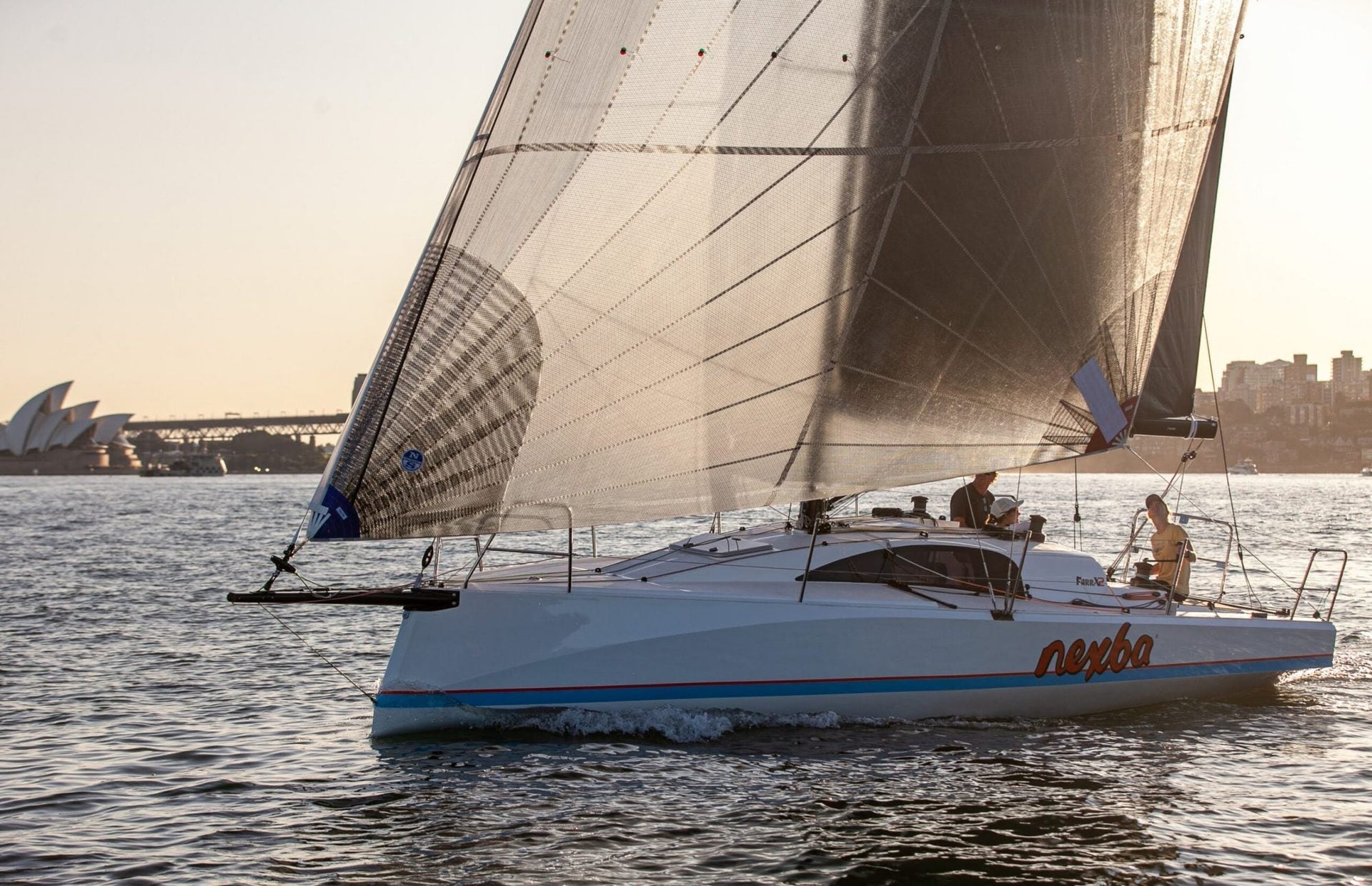
PASSION FOR PERFORMANCE TO BRIDGE THE AUSTRALIAN GAP TO EUROPE IN THE DOUBLEHANDED SCENE
PASSION FOR PERFORMANCE TO BRIDGE THE AUSTRALIAN GAP TO EUROPE IN THE DOUBLE HANDED SCENE
The Launch of the New Farr X2 with North Sails Australia
📸 VicSail
With the launch of the newest high performance short handed yacht, the Farr X2, North Sails Australia reveled in the opportunity to be part of something new, creating the sail inventory for the first Farr X2, designed specifically for the Australian double handed market.
The vision for the project stems from Farr Yachts Australasia’s, Bret Perry’s experience as Project Manager of RG Mini 650s in France, where he wanted to give the Australian short handed sailing scene an opportunity for high performance sailing, with modern design and techniques.
“What I wanted to do was to bring back to Australia with short-handed sailing and the boom it’s going through. Each boat is designed for a reason and purpose, and the Farr X2 is purely about no holds barred high performance yachting, designed with full power in mind for absolute performance. It’s very easy to sail a shorthanded boat crewed, but it’s very hard to sail a crewed boat shorthanded” said Perry.
Norths Sails Australia jumped at the opportunity to be involved from the outset, with short handed offshore racing at the forefront of the design.
Not only did we want to make the boat sail fast in all conditions, but it must be easy to sail shorthanded so, discussing the different principles and priorities was a key part of the design process for the team.
“There were lots of meetings between North Sails and us, to talk about what we wanted to achieve. The number one thing is that you’re sailing short handed so you have to be able to do the manoeuvres, and you have to think about safety, and then on top of all of it, you have to think about performance. That’s the biggest thing that I wanted in the sail package from North Sails.”
The sail inventory has maximum sail area in mind for the 30 footer, however there’s a delicate balance between achieving higher performance and having a competitive rating within IRC and ORCi certification.
“I wanted to be in furling sails early, and in saying that, to be at full speed very early. So, to be at max boat speed upwind in six or seven knots of wind.”
The upwind sails include an all-purpose hanked jib that will work up through the light to moderate wind range of 17 knots. The all-purpose jib is helpful for shorthanded sailing to allow for longer crossovers between sails and reduce the frequency of sail changes.
“The mainsail is fully battened, with a really large number one reef, as well as a 50% reef to cover the IRC rule, to eradicate the use of trisails.” continued Perry. “And, the first reef is probably more equivalent to a one and half, to three quarter reef so it’s really big.”
📸 VicSail
North can offer the inventory from their NPL laminate or their market leading 3Di product.
“In my experience in the mini 650s, we never put the first reef in, and instead put the second reef in and kept the big jib up so we still had the power to do what we wanted to do, but was de-powering enough to sail safely. We’re still going through testing but that’s the philosophy.”
Perry ran through the light to moderate sail package setup. “Let’s say you’ve got the big jib and have the first reef in the main, and I would estimate that would be comfortable in 17-18 knots, you’ll be quite comfortable but still powered up in that configuration. As you start getting above that breeze, you move into a J5 furling sail, which is on an inner tack point on the boat. Once you’re getting upwards of 25 knots, there’s the opportunity to furl the sail up when you feel overpowered, and sail in a furling mode – which is just so much safer than being up the front of the boat shorthanded and you’re controlling the ability to furl.”
When designing the downwind sail package, a key factor was getting the boat planing early, from 11 to 12 knots of wind. The choice then became a furling code zero built from Norths NPL laminate, with the additions of a masthead A2 spinnaker, and a furling A5 for heavy wind conditions built from conventional nylon.
“In light airs, you’d run the code zero and with an increase in wind, you’d use the all-purpose jib with the masthead A2, in up to about 17 knots of wind. You’ll be going pretty quickly and powered up, but you’ve got the choice as to when you want to start reducing the sail area from that point” explained Perry.
With all this in mind, the North Sails inventory was designed as if it was day two or three of a shorthanded race, to reduce the time non-furling sails are flying due to the attention required to trim the sail accurately.
“Where North Sails have been fantastic, is that they get excited about the project, and the ability to create something new.” Perry explained. “And what they’ve come up with is phenomenal. There’s no question they’re on the front foot from my point of view.”
“There’s been such a big group of people involved, from North Sails to Farr Yachts, XSP the builders, and all of the suppliers, and to VicSail who are supporting the project massively, we couldn’t have done this without their assistance.”
“It was amazing to see that the work that we did in the measurement and designs, it fit perfectly, only one small adjustment out of everything we put together. So that’s a credit to everyone involved to be able to put all this together to within millimeters – and all done remotely without the boat” Perry finished.
📸 VicSail
READ MORE
READ MORE
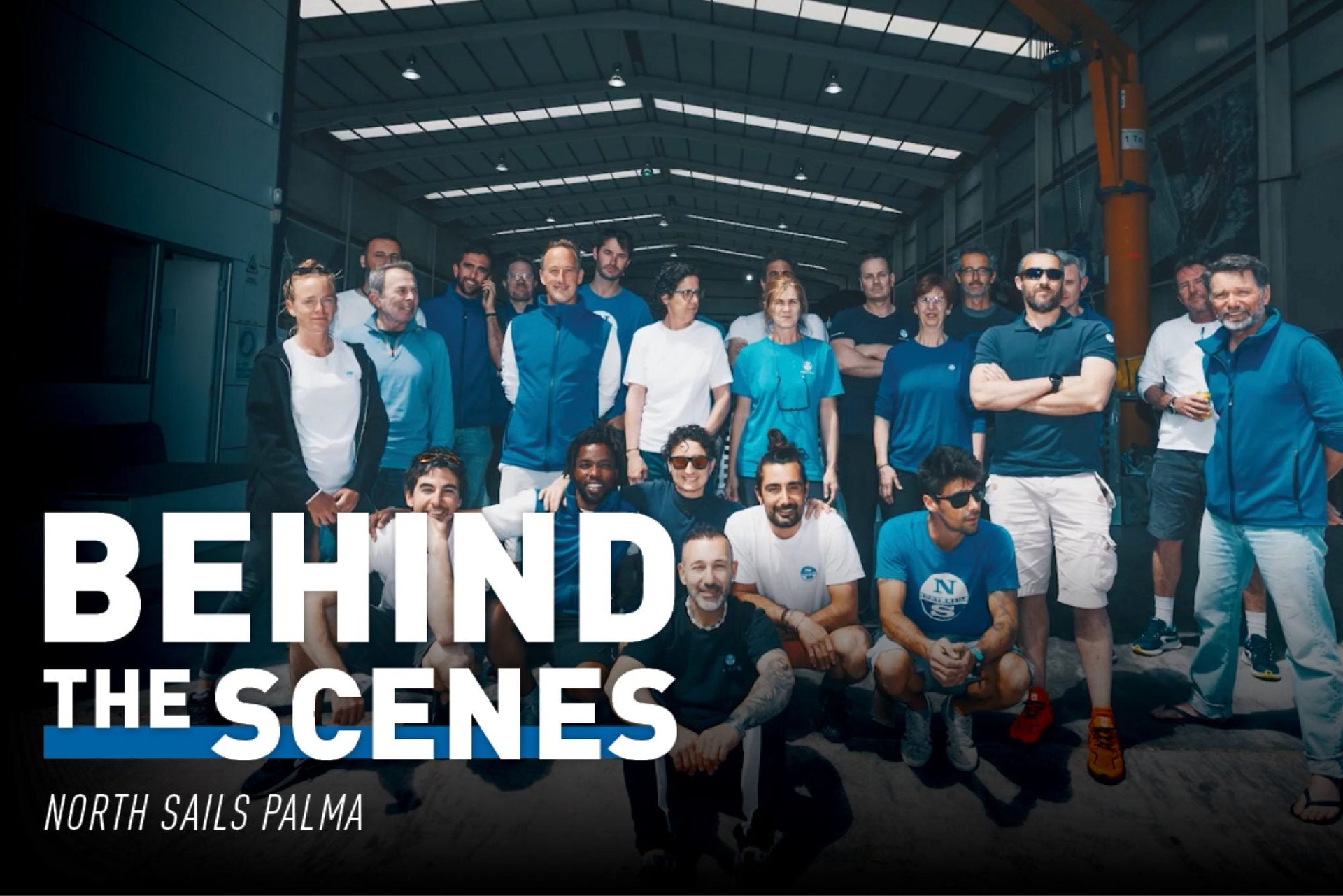
BEHIND THE SCENES: NORTH SAILS PALMA
BEHIND THE SCENES: NORTH SAILS PALMA
Step Inside One of Our Largest Service Lofts
This episode of Behind the Scenes steps into the North Sails loft in Palma and highlights our team working in one of the world’s biggest sail lofts. North Sails Palma is a vital hub within the North network and expanded to twice its previous size in the Spring of 2022.
This 4,720 sqm loft serves double duty as the on-island sailing community hub and a key destination for international sailors and boat captains. So whether you’re a superyacht arriving from a transatlantic delivery, in town for one of the many Grand Prix regattas, or cruising Europe during the summer season, there’s a good chance you’ve met the North Sails team dockside.
Over 30 experts, including sail designers, sailmakers, service professionals, and Superyacht experts sit under one roof, just a quick 10-minute drive from the harbor. The Palma team prides itself on delivering a level of customer service that is unprecedented. And while the team consists of consummate professionals, their passion for sailing and their motivation to keep raising the bar fosters a fun and dynamic atmosphere.
Join us as we spend a day in our Palma loft and get to know the North Sails team.
📸 Atila Madrona
READ MORE
READ MORE
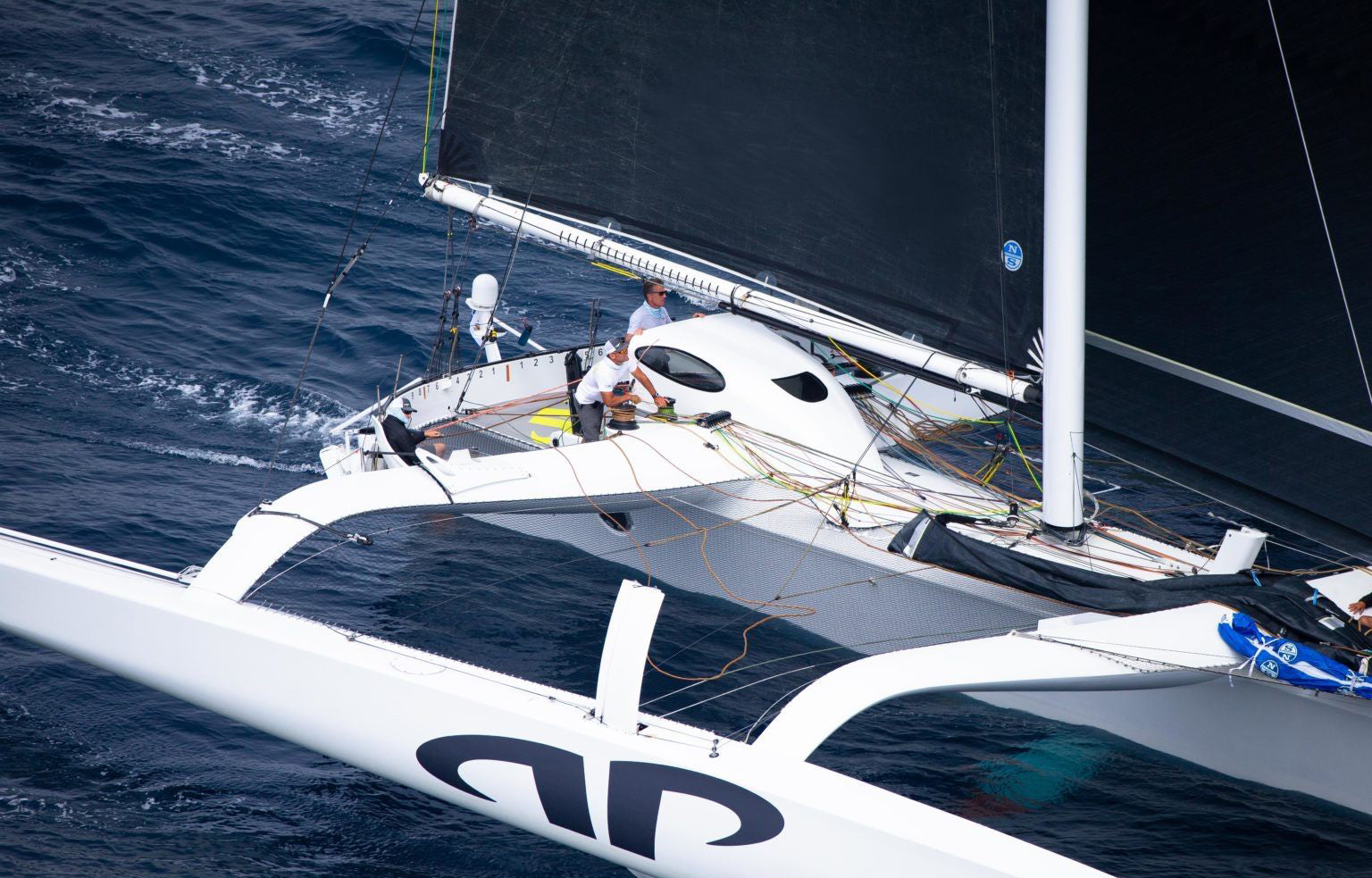
#NSVICTORYLIST: NEWPORT BERMUDA RACE 2022
NEWPORT BERMUDA 2022 RACE RECAP
North-Powered Teams Claim Major Victories and Over 50% of Podium Positions Across 19 Classes
The Newport Bermuda Race has kept North Sails buzzing (and busy!) since well before the fleet set off on June 17th. This year marked the 52nd edition of this East Coast offshore classic and the return of racing after a canceled 2020 event. And while we waited a bit longer than expected to see the competitors return to the start line, race fans and North Sails were quickly rewarded with a steady flow of results.
As the official performance partner to the race, North Sails is committed to helping our clients get the results they expect. The 2022 Newport Bermuda Race featured 186 boats competing across 19 classes. Race results are the ultimate test for sailmaking brands, and the proof is on the podium. This edition of the Bermuda Race saw North clients set a new overall course record, capture line honors, several major divisional wins, and 26 of the possible 49 class podium positions. Keep reading for a rundown of the North Sails-powered performances.
Jason Carroll’s Mod 70 Argo led the pack into Bermuda, claiming overall line honors and setting a new race record of 33 hours. Carroll and his crew are the first boat in the race’s history to finish on a Saturday, which proved both an honor and a challenge for the eight sleep-deprived sailors.
“It was some of the roughest conditions we’ve had on the boat,” Chad Corning said. “The sea state was just nasty, coming from all different directions. You never knew where the waves were coming from, and they would hit the boat at all different angles. You had to crawl around the cockpit to get anywhere. It was a very violent motion; a lot of the guys got sick.”
Argo’s record-breaking run set a new multihull record as well as the new overall course record. However, the monohull record of 34 hours, 34 minutes, and 52 seconds set by Comanche, skippered by North Sails President Ken Read, in 2016 still stands.
Powered by North 3Di and a heavy helping of Helix sails, 11th Hour Racing Team skippered by Charlie Enright was the second boat into Bermuda. Their IMOCA Mālama was the first monohull to complete the 635-mile race, and the wild ride proved an ideal opportunity for Enright to log training miles before the start of The Ocean Race in early 2023.
Like Argo, the Mālama crew was pushing hard and was short on sleep upon arrival. Enright compared the onboard conditions to spending 41 hours in a washing machine. “This has been full-on,” he said at the finish. “There has been no rest for anybody onboard. From the moment we left Newport, we have been racing at speeds between 20-30 knots in a heated sea state.”
Sailing with Enright were his 11th Hour teammates Justine Mettraux and Amory Ross, as well as Red Bull athletes Olympic snowboarder Elena Hight, and big wave surfer Ian Walsh.
View this post on Instagram
A post shared by 11th Hour Racing Team (@11thhourteam)
North Sails powered both Lighthouse Division winners: with Chris Sheehan’s Warrior Won on top in the Gibbs Lighthouse Division and Sally and Stan Honey’s Cal 40 Illusion claimed the St David’s Lighthouse prize.
The Newport Bermuda 2022 is the latest in a string of wins for Warrior Won; Sheehan and his team were named the 2021 Transpac overall winner and the overall winner of the 2022 RORC Caribbean 600. Warrior Won’s sail inventory includes North 3Di which has been onboard with the team for each of their wins in the past year.
View this post on Instagram
A post shared by Warrior Won Sailing (@warriorwonpac52)
Illusion bested the 108-boat fleet to place on top of the podium in the St David’s Lighthouse Division. And with an owner who’s also a world-class navigator, you’d expect nothing less. Honey is a multi-race veteran and was navigator onboard Comanche during their last record run.
“The conditions were perfect for our boat, and we had a pretty good navigator onboard,” said Sally of her husband. “Stan chose a really good course, and the conditions were just what the boat loves, heavy-air reaching, a lot. We got into a Gulf Stream eddy and stayed in it for about seven hours. That gave us a good boost. We managed to stay in the wind most of the way down. We had a couple of light spots, but nothing like the later boats.”
Prevail, Dudley Johnson’s Tripp 65 won the 38-boat Finisterre Division. Dudley and his crew knew they were on the right track when they were passed by Warrior Won in the Gulf Stream. Navigator Adam Klyver commented: “We felt like we were doing something right. We tried to stay in the middle of the Stream and found a five-knot current pushing us southeast. We probably had favorable current for close to 90 percent of the race.”
North Sails is a longtime partner to the Newport Bermuda Race and is honored to have been onboard in 2022. This year’s race saw a bumpy sea state, fast sailing and we know it was a battle to arrive in Bermuda. Congratulations to all participants and a job well done to North clients who saw their names on the leaderboard.
In Memory Of:
Our thoughts are with the family of Colin Golder and his Morgan of Marietta crew. Golder, a longtime client of North Sails, fell overboard en route to Bermuda and tragically passed away. He was not only a great client but an even better friend to our team who had the pleasure of sailing and working with him; he will be greatly missed. Sail on Colin.
READ MORE
READ MORE

PALMARÈS DES VOILES NORTH SAILS 2022
PALMARÈS DE NOS VOILES EN CETTE SAISON 2022
Les voiles North Sails commencent fort la saison! Un immense BRAVO à tous les concurrents des deux grandes régates traditionnelles lémaniques, la Genève-Rolle-Genève et le Bol d'Or Mirabaud.
Voici les résultats obtenus par des navigateurs équipés par North Sails:
© Yves Ryncki
Genève-Rolle-Genève:
Classement général mono, temps réel: 1er ,2ème (partiel), 3ème, 4ème (partiel)
Classement général, temps compensé: 3ème
Par catégorie:
M1: 1er, 2ème, 3ème, 4ème, 5ème
M2: 3ème
TCFX: 1er ,2ème (partiel), 3ème, 4ème (partiel)
TCF2: 2ème, 3ème
TCF3: 1er, 2ème (partiel)
TCF4: 1er ,2ème, 3ème, 4ème
Grand Surprise: 1er, 2ème, 3ème, 4ème, 5ème, 6ème, 7ème
Surprise: 2ème , 3ème
- - - - - - - - - - - - - - - - - - -
Bol d'Or Mirabaud:
Classement général, temps réel: 1er, 2ème, 3ème
Classement général, temps compensé: 3ème, 4ème, 5ème
Par catégorie:
M1: 1er, 2ème, 3ème
M2: 3ème
TCFX: 1er, 3ème (partiel), 4ème
TCF1: 1er
TCF2: 2ème ,3ème
TCF3: 2ème (partiel)
TCF4: 2ème
Surprise: 1er, 2ème, 3ème (partiel)
Grand Surprise: 1er, 2ème, 3ème, 4ème, 5ème, 6ème
© Yves Ryncki
READ MORE
READ MORE
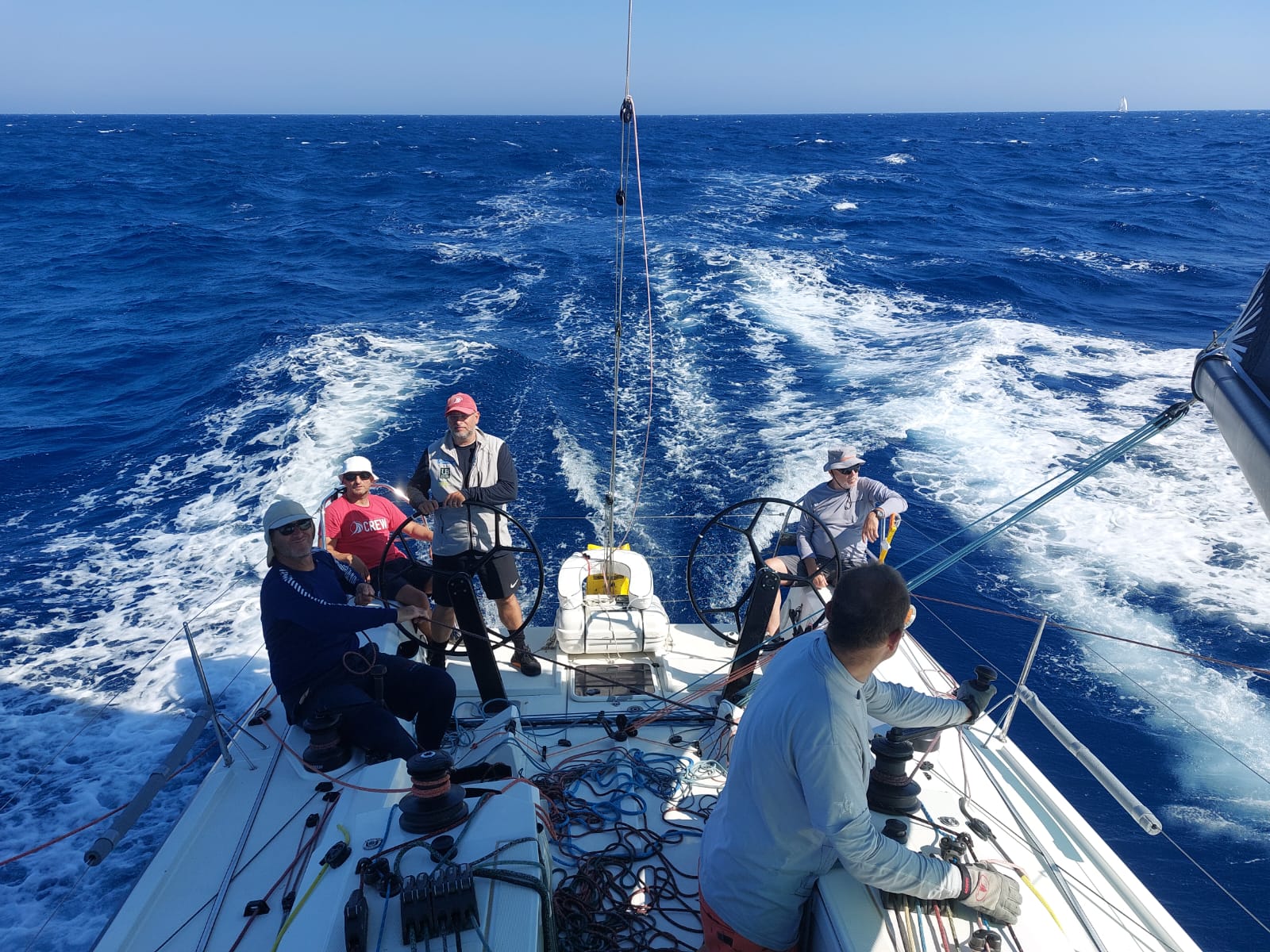
PRETTY, PRETTY, PRETTY GOOD.
PRETTY, PRETTY, PRETTY GOOD
A Recount of The 2022 International Regatta Brindisi- Corfu
The “International Regatta Brindisi- Corfu” (www.brindisi-corfu.com) was founded in 1986. During the first two years, the competition was limited to vessels from Brindisi. It was three years later that the participation of aggressive Corfiot boats began. In 2022. I was able to be a part of a multinational crew - a French boat under Greek flag, a Bulgarian owner, and a Bulgarian - Croatian crew. So we added a nice mixture to the already colourful image of the race - 78 entries from Italy, Greece, Croatia, Malta, Bulgaria, Sweden, Great Britain, Spain and USA. Our boat was lying in Corfu, so Nikola and I flew there to prepare everything for the delivery to Brindisi. The boat is a Sun Fast 3600, named after the American rock band from the 60s - “Iron Butterfly”. The first look at the boat already showed that it is fitted to be fast - custom Southern Spars carbon rig, full North Sails 3Di inventory, B&G instruments and lots of other racing gadgets. All in all, it makes you smile.
Corfu, see you in a couple of days..
Anyhow, the boat is ready, we meet the owner Nasco and his friend Dobry and we are ready to sail to Brindisi. A nice south easterly makes the first 30-40 miles pass by quickly, but than the unstable atmosphere with a low passing by shows us a good time. The first squall hits us around 8 PM, just before sundown.
The first squall
The second one comes around 1 AM with lots of wind and a lot more rain. It’s all part of the game, the only problem is that between the squalls there’s no wind and we are slowly motoring towards Brindisi. Early in the morning, around 6 AM we enter the rather big Italian port of Brindisi. A lot of industrial buildings make it hard to appreciate the traditional Mediterranean architecture.
The nice, Mediterranean part of Brindisi
In the next days we are preparing the boat for the race, gathering and installing all the safety equipment, checking the sails and finally - making some tourist routes around the city. The other part of the crew - Marko and Sapa are coming on Saturday evening, bringing a brand new 3Di mainsail for the race. Unfortunately, as the forecast predicted, there is a lot of wind on Sunday (30+ knots of north westerlies), and after a short wait around the starting line, the Race Committee postpones the start until Monday morning at 6AM.
Marko & Nasco shortly after the start
There are 78 boats racing in this year’s edition with a variety of different designs and lengths, all racing under the ORC rule. So, a fair chance for everybody. We are pretty psyched about the start so we start full power in 25 knots of north westerlies, under full main and A5. Soon after the start we change to A2 as the waves become longer and the surfs faster.
Iron Butterfly (aka Buffy) at her best
The wind varies from 20 to 25 knots, getting stronger near the Italian coast. After consulting our routing options, we decide to stay closer to the Italian coast before crossing the Otranto strait. Again, I was surprised at how little ships we met crossing the Otranto. There were definitely better days for the shipping industry. Back to sailing - the route to Corfu is 104 miles long, meaning there is plenty of time for the conditions to change. And so it is, some 40 miles before Corfu the wind starts to drop slowly, knot by knot. 15 miles before the finish there are only 10 knots of wind left, 10 miles from the finish only 5 knots and we knew we were headed into some really light winds just before the finish.
Nerves of steel
But we keep our morale high, Marko is making some good strategic choices and we are gaining on the boats ahead, mile by mile, minute by minute. A mile from the finish line we come to a complete stop, and the AIS is showing others boats closing in at higher speeds. But they will stop too, no worries.
The dynamic duo - Marko & Nikola
The slow motion finish finally comes to an end around 11 PM and we are all excited and proud to have entered 5th in real time. Now we have to wait for the compensated times, but with such a good race behind us we can only expect the best. But the but is always there, and just minutes from our finish Marko gets a message from the RC that we have to be present at the official crew weighing tomorrow at 9.30 AM. We know that our weight is close to the max allowed limit because we changed a lighter (read: female) crew member for a heavier (read: male) in the last moment, so we decide there’s no more food or water until tomorrow. Not an easy decision, after 17 hours of racing we can’t eat a nice steak? Merde. But it is all for a greater cause, so we don’t mind. After a good night’s sleep, we wake up for an early walk and prepare for the weighing. And, as usual, the scale is showing more than expected. We are 5 kilos over, and we have an extra hour to get rid of them. There is no other way - foul sailing gear on, and all of us are out for a nice jog in the Greek sun.
Why not?
It’s 30 degrees out and we are sweating like crazy. The regular folks are pretty confused seeing 6 guys running around the marina in sailing suits. The real connoisseurs of the ORC races are just smiling, they know what is really going on. On the second weighing, we are 2 kilos below limit meaning we managed to dry out 1.5 kilos each in just one hour. Not bad, not bad at all.
When we draw the line, we managed to enjoy a really nice race in perfect weather conditions with a super happy crew, in a great boat with an excellent result - 1st in ORC C, 1st in real time for the Groups B, C and D (the ones that started 10 minutes after the ORC A and Multihulls), and 1st in compensated times for the same Groups. And not to mention 3rd in ORC overall - www.brindisi-corfu.com/en/classifiche/ .
One of many trophies for the Iron Butterfly crew
You must admit it: it sounds pretty, pretty, pretty good.
READ MORE
READ MORE

SNART VIND I SEGLEN FÖR PRINCESS SVANEVIT
SNART VIND I SEGLEN FÖR PRINCESS SVANEVIT
Renoveringen går mot sitt slut - och vi har fått uppdraget att förse henne med segel
📸 Sjöhistoriska museet
Princess Svanevit är en klassisk 12mR-yacht från 1930. Det är en magnifik båt, dessutom med en spännande historia.
Hon beställdes av förläggaren Erik Åkerlund inför KSSS:s hundraårsjubileum 1930, ritades av Gustaf Estlander – "Trollkarlen från Nyland" – och byggdes av Carl Plym på det legendariska Neglingevarvet.
Åkerlund kappseglade båten med framgång i både Sverige och England, men sålde henne redan efter några år. I mitten av 50-talet seglade tredje ägaren ner Princess Svanevit till Spanien, där hon försvann spårlöst. Femtio år senare bestämde sig träbåtsbyggarna Bobby Cyrus och Andreas Millde för att försöka leta upp henne. Med hjälp av bland annat Google Earth lyckades de hitta henne uppställd på en kaj i södra England, och de ägnade sedan sju år åt att övertala ägaren – en excentrisk miljardär som gjort sig en förmögenhet på fastigheter – att få köpa henne. Precis innan kontraktet skulle undertecknas avled ägaren och det tog dem ytterligare något år att komma överens med dödsboet.
Men i augusti 2017 var allt äntligen i hamn och Princess Svanevit skeppades till Sverige. Hon fördes till Stockholms Båtsnickeri i Saltsjöbaden, inte långt från den plats där hon en gång byggdes. Sedan dess har hon under Andreas Milldes ledning genomgått en oerhört genomgripande renovering, som nu börjar gå mot sitt slut.
Om allt går som planerat seglar hon i slutet av augusti!
Vackra segel till en vacker båt
North Sails har varit involverade i 12mR-klassen sedan Lowell North rattade US 27 Enterprise i America’s Cup 1977. Intresset för såväl klassiska som moderna tolvor har ökat kraftigt på senare år, inte minst i Nordeuropa där klassen nu samlar runt 25 båtar, och North Sails-gruppen har lagt ner stora resurser på utveckling av design och konstruktion av segel.
För moderna tolvor finns inga begränsningar när det gäller segelmaterial, men för klassiska tolvor står valet mellan vävd duk eller laminerad polyester. 3Di-segel byggda i polyester ryms inom regeln, och om det är max prestanda man är ute efter är detta det självklara valet. Mycket riktigt sitter det 3Di 330 RAW-segel på de flesta klassiska tolvor som används för kappsegling.
De segel vi nu tar fram till Princess Svanevit är dock av mer klassiskt snitt. Tanken är att hon ska återställas till det skick och utseende hon hade som ny, och det gäller så långt möjligt även rigg och segel. "De estetiska värdena har stått i första rummet", säger North Sails Anders Lewander, "men de har fått vägas mot de praktiska fördelar som modern teknik ger oss. Det har ju ändå skett en del utveckling på materialsidan sedan 1930."
Tankarna bakom seglen har utvecklats i nära dialog med Christian Harding och Janne Björnberg, som är knutna till projektet som koordinator respektive sakkunnig. Christian är välkänd mångsysslare inom segling och Janne har varit segelmakare sedan 70-talet och driver idag Next Sails. Båda har massor av erfarenhet, inte minst av classic-båtar.
Krysseglen sys på traditionellt vis i högkvalitativ dacronduk, men panelerna är smalare än vanligt. Fock och genua får en gammaldags vådlayout som kallas för "mitre cut", med en söm som går diagonalt mellan skothorn och förlik. Även förstärkningarna får ett utseende som minner om svunna tider.
För att klara de höga laster som en så tung och styv båt genererar kommer några av seglen sys med two-ply-teknik, det vill säga dubbla lager duk längs akterliket. Two-ply är väl något man i dag främst förknippar med 80-talet, men i det här fallet har vi försökt hitta en estetik som ansluter till ett betydligt äldre ideal.
Mer av "uppvisningssegel" är racingsegel, skulle man kunna säga, men syftet är även att göra en noggrann utvärdering av laster och den helt nya moderna trämastens karaktär.
Just uppvisningssegling är också det som väntar framöver. Visionen är att Princess Svanevit ska bli "Hela Sveriges båt" och efter sjösättning och sedvanliga tester kommer hon visas upp i hamnar och på kappseglingar runt hela Sverige.
Princess Svanevit ägs av ett aktiebolag, som i sin tur kontrolleras av den ideella föreningen Svenska Träbåtar. För dem har renoveringen ett bredare syfte än att bara ge en vacker gammal båt nytt liv. Förhoppningen är att Princess Svanevit ska öka intresset för klassiska träbåtar och bidra till att de bevaras i Sverige. Bland de långsiktiga målen finns bland annat att få upp båtbyggnadskonsten på Unescos världsarvslista och driva igenom rotadrag för renovering av klassiska båtar!
Lästips
På projektets hemsida och Facebook-sida finns massor av information. Och i premiärnumret av helt nya tidskriften Båtklassiker ägnas ett trettiotal sidor åt Princess Svanevit, Erik Åkerlund och klassiska tolvor.
📸 Sjöhistoriska museet
READ MORE
READ MORE

DAHLSJÖ / STRÖMBERG RENSAR PRISBORDEN MED NYA Z30+
DAHLSJÖ / STRÖMBERG RENSAR PRISBORDEN MED NYA Z30+
Anders Dahlsjö och Martin Strömberg gör en satsning mot ORC Double Handed Worlds
📸 Malcolm Hanes
Och det har börjat bra, med bland annat totalseger i Raymarine2star.
Våren 2021 publicerade vi en artikel med rubriken Snart är nya Z30+ färdig! Det visade sig vara lite väl optimistiskt, och det borde vi kanske ha insett redan då. Att nya, tekniskt avancerade båtar går över tiden är ju en regel utan kända undantag.
I april i år sjösattes den första båten, SWE 301 Zeit. Den ägs av initiativtagaren Johan Larsvall men kappseglas fram till och med VM av Anders Dahlsjö och Martin Strömberg. Anders har två America’s Cup och ett Volvo Ocean Race i ryggen. Martin är professionell kappseglare, med bland annat fyra Volvo Ocean Race på sitt CV – och han är en av mycket få svenskar som vunnit totalt.
Anders och Martin seglade båten första gången i början av april och ägnade några helger åt att bekanta sig med den. På Lidingö Runt ställde de upp tillsammans med Johan Larsvall och slutade tvåa av sjutton båtar i SRS 1. Och på Raymarine2star slog de alltså till med totalvinst. Helgen därefter vann de för övrigt även även shorthand-klassen i KSSS Havskappseglingsregatta.
Det lovar gott inför VM, som ju avgörs på delvis samma vatten.
Ett ovanligt koncept
Vi ska inte fördjupa oss i tekniska detaljer eller gå in på hur z30+ utvecklades (det kan du läsa om här). Men kortfattat kan man säga att Johan Larsvall tagit in ett gäng experter med Jimmy Hellberg i spetsen för att göra en total makeover på gamla Z30:an. Modifikationerna är så genomgående att det i praktiken rör sig om en helt ny konstruktion.
Snudd på unikt i den här storleksklassen är att Z30+ byggs från topp till tå i kolfiber, vilket gör båten lätt och samtidigt extremt styv. I övrigt är den medvetet enkel, särskilt jämfört med andra båtar utvecklade för shorthand-kappsegling. Z30+ har inte dubbla roder, inga chines, ingen vattenballast och definitivt inga foils.
"Z30+ är en spännande båt", säger Anders Dahlsjö. "Enkel men extremt förfinad, med all kolfiber. Den går som en raket och det märks att den har mycket i bulben. Den känns nästan som en 40-fotare när man kliver ombord, för den gungar inte till som lätta båtar i den här storleken brukar göra."
Även segelgarderoben är enkel. Den togs fram redan för ett år sedan, och det som har hänt sedan dess är att ytterligare en fock har tillkommit. Den är designad för hårdare vindar och är 7 kvm mindre än allroundfocken. Två revpunkter i förliket och en i akterliket gör att den får ett väldigt brett register. Fullt hissad är det en hårdvindsfock (på 18 kvm) och med ett rev motsvarar den en J5:a (13 kvm). Dessutom kommer den användas som ett reaching-stagsegel (11 kvm,). Den halsas då i centrumlinjen 2,3 meter framför masten (ca 60 % av J-måttet).
"Man kan nästan säga att man får tre segel i ett", säger Anders Lewander på North Sails Lidingö, som tillsammans med sin bror Tore har varit ansvarig för utvecklingen av seglen.
Vägen mot VM
Enligt SRS-brevet ska Z30+ vara snäppet långsammare än Farr 30 med full besättning, men något snabbare i shorthand-figuration, vilket ju låter rimligt med tanke på det rätande momentet. Inte illa med tanke på att Z30+ är en båt med full ståhöjd och att den är tänkt att kunna användas även som semesterbåt.
På VM är det dock ORC som gäller. Det ser för övrigt ut att bli ett riktigt getingbo; i slutet av maj var nästan 90 besättningar anmälda och anmälningstiden går inte ut förrän i mitten av juni, så 100 båtar till start är ingen omöjlighet.
Säsongen har som sagt börjat bra, men Anders och Martin hoppas kunna jobba upp farten ytterligare i den nya båten. Sedan gäller det bara att toppa formen lagom till VM i början av juli.
READ MORE
READ MORE
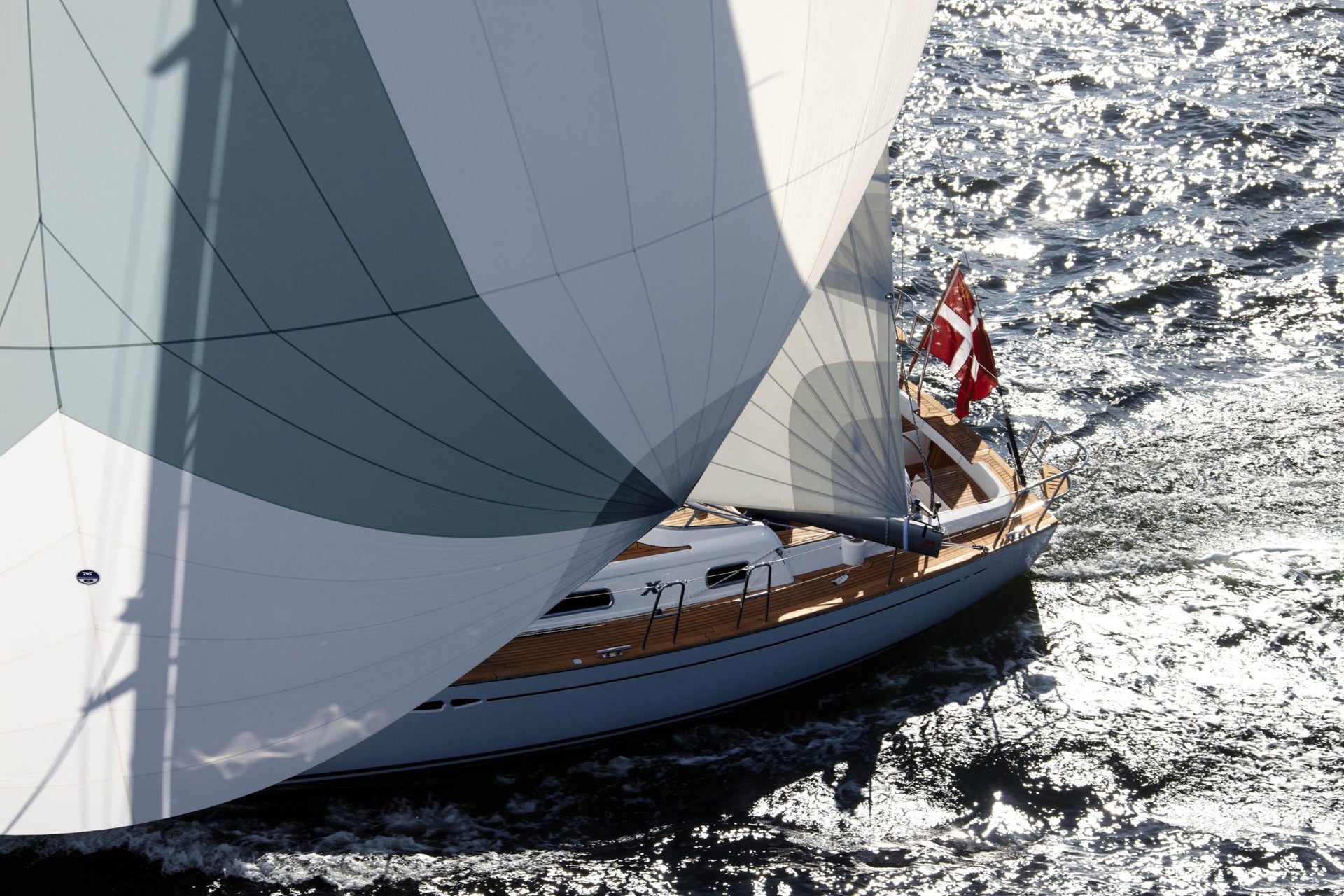
KLART DU SKA SEGLA SPINNAKER PÅ SEMESTERN
KLART DU SKA SEGLA SPINNAKER PÅ SEMESTERN
Det är faktiskt enklare än många tror
En spinnaker ger en enorm prestandaökning på läns och slör i lätta till måttliga vindar. Dessutom är det ett roligt segel som ger seglingen en ny dimension. Vi vet att många tycker att det kan känns svårt och komplicerat, men gör du bara på rätt sätt så är det inget att vara orolig för. Här tar vi en titt på hur man hanterar såväl konventionella spinnakers som asymmetriska cruisingspinnakers – även kallade gennakers. Fokus ligger på avslappnad cruisingsegling med liten besättning.
Sättning av gennaker
En gennaker riggas med ett fall, en halslina i fören och två skot, ett på vardera sidan. Skoten leds genom block längst bak på däck och går sedan framåt till varsin vinsch. Gennaker-skoten kan antingen ledas innanför eller utanför förliket. Båda varianterna fungerar och båda har sina fördelar. Du får helt enkelt testa och se vad som fungerar bäst på din båt. Tänk på att det bästa alternativet kan variera beroende på vindstyrka. För en liten besättning är en spinnakerstrumpa ett riktigt bra hjälpmedel. Seglet packas inuti strumpan som då får en korvliknande form. Eftersom seglet inte fyller på vägen upp är det enkelt att hissa. Väl i topp drar du i strumpans manöverlina, vilket drar ihop strumpan och frigör seglet. För att förhindra att seglet snurrar runt sig själv – vilket kan förorsaka timglas – bör halslinan spännas innan hissning. Ett om möjligt ännu ännu enklare alternativ är att investera i ett bra rullsystem. Numera fungerar de faktiskt bra även för länsbetonade gennakers. Då är det bara att hissa det inrullade seglet, lossa inrullningslinan och skota hem så att seglet rullas ut. När seglet ska ner upprepas manövern, fast i omvänd ordning.
Behöver du en halsstropp?
Ibland kan det vara bra att använda en så kallad halsstropp. Den kopplas till halshornet och fästs runt det inrullade förseglet. Därmed hindras halshornet från att röra sig i sidled. Om förliket på din gennaker är så långt att halshornet hamnar bara lite ovanför pulpiten behövs inte någon halsstropp. Men har du ett kort förlik ger halsstroppen ökad kontroll och stabilare segling.
Sättning av spinnaker
En konventionell spinnaker som sätts på spinnakerbom ger dig ökade trimmöjligheter och oftast högre prestanda. Men det är ett mer komplicerat segel än en gennaker. Även här är spinnakerstrumpa något vi gärna rekommenderar, särskilt om du seglar med liten besättning. Riggning och hissning sker på samma sätt oavsett om du har en strumpa eller inte. Du börjar med att fästa fallet i spinnakerns fallhorn. Därefter sätter du upp bommen, koppla den till lovartsgajen och hänger bommen i liften. Innan du hissar drar du i lovartsgajen tills det främre hornet ligger dikt an mot spinnakerbommen. Så fort spinnakern är i topp tajtar du läskotet så att spinnakern inte börjar rotera och drar upp strumpan. På lite större båtar är det vanligt att man seglar med dubbla gajar och dubbla skot. Bommen kopplas till en gaj som går ner till ett fast block ganska långt fram på däck (strax bakom vanten är lagom) och därifrån till en vinsch. Lähornet trimmas med ett skot som går till ett block längst bak i båten och som därefter leds framöver till ett spärrblock eller en vinsch. I gipparna hanteras spinnakern med enbart skoten, vilket innebär att gajen, som bommen ska fästas på, alltid är obelastad. Detta gör att det aldrig blir tungt att sätta bommen i beslaget på masten.
Nedtagning av gennaker
När du ska ta ner gennakern underlättar det om du plattar ner lite så att gennakern skuggas av storseglet. Släpp på skotet så att seglet faller ihop och dra ner strumpan över seglet. Sedan är det bara att släppa fallet och stuva undan seglet i sin säck, alternativt dra ner det genom fördäcksluckan.
Nedtagning av spinnaker
När du river spinnakern gör du på samma sätt som när du hissade den, fast i omvänd ordning: Lägg dig på öppen slör, släpp läskotet, dra ner strumpan och lägg loss lovartsgajen. Nu är det bara att sänka fallet och stuva undan strumpan med seglet. I hårdare vindar underlättas nedtagningen om du skuggar spinnakern bakom storseglet. Processen inleds, precis som i sekvensen ovan, med att du lägger dig på en öppen slör. Men istället för att bara släppa läskotet, så kan du lägga en lina i en loop runt skotet och använda detta för att straffa ner lähornet mot en punkt precis bakom masten. I och med att du tvingar ner akterliket bakom storseglet tappar spinnakern trycket och blir lättare att hantera.
📸 Amory Ross
READ MORE
READ MORE

NS KLIJENTI NAJBRŽI I U REGATNOJ I U OBITELJSKOJ SKUPINI NA OVOGODIŠNJOJ FIUMANCI
NS KLIJENTI NAJBRŽI I U REGATNOJ I U OBITELJSKOJ SKUPINI NA OVOGODIŠNJOJ FIUMANCI
Ovogodišnja regata Fiumanka ponovno je okupila vrlo impresivan broj sudionika, a među njima i nekoliko najvećih jedrilica na Jadranu. Među njima su se posebno isticali Portopiccolo i Maxi Jena i s obzirom na uvjete sasvim opravdano je bilo među njima očekivati generalnog pobjednika ove manifestacije.
Za razliku od mnogo ranijih izdanja ove Riječke manifestacije pod jedrima, ova je bila izrazito vjetrovita. Na startu je puhalo 10-12 čvorova burice koja je jačala kako se flota približavala prvoj bovi koja je bila postavljena ispred Viktora Lenca.
U toj zoni vjetra je bilo i preko 20 čvorova, tako da je taj dio regatnog polja sigurno pružao i užitak i hrpu adrenalina svima koji su u tim trenucima u laškoj orci jedrili u tom kursu.
Nakon obilaska ove bove regatna skupina jedrila je prema sredini Riječkog zaljeva gdje je bila postavljena druga bova, dok su obiteljski krstaši jedrili direktno natrag prema vrhu Molo Longa.
Do Molo Longa je nakon obilaska druge bove jedrila i regatna skupina, tako da su se u završnoj fazi regate na cilju susreli svi i stvorili vrlo atraktivnu i sliku i situaciju koja se rijetko može vidjeti na regatama.
Što se tiče najvećih, do prve bove nadmetanje Portopiccola i Maxi Jene bilo je poprilično izjednačeno iako je Portopiccolo startao dosta lošije u odnosu na perjanicu Crnogorske regatne flote.
Do preokreta dolazi baš na samoj bovi na kojoj dolazi do pucanja vanga Maxi Jene i to vrlo spretno Talijanska posada iskorištava i ostvaruje prednost koju nisu ispuštali do samog kraja.
Zanimljivo je bilo i u završnom dijelu regate jer je vrlo brzo za najvećima u Riječku luku uplovila i Bubamare, najbrža jedrilica iz obiteljske skupine.
Sve u svemu regata je bila vrlo brza po pitanu obje skupine, a ono što je organizatore posebno veselilo je to što su skoro svi koji su isplovili uspješno dojedrili do cilja.
Bogatu fotogaleriju iz Rijeke možete pronaći na ovom linku.
READ MORE
READ MORE

TRADITIONS AND CHANGE
TRADITIONS AND CHANGE
WVYC RNSA NYC Singlehand/Doublehand Regatta
What’s unique about this regatta? After all, there are now many solo sailing regattas now; the impact of that concept has evolved over the years since it was first launched in the 1970’s by Capt. John Horton of the Royal Naval Sailing Association here in Vancouver BC. Or has it? Now in it’s 48th edition, this regatta’s Ancient Mariners (75+ years ) and Old Salts (65-74 years) remind and inspire the rest of us that one of the milestones of a keelboat sailor is the test of a solo crossing of the Strait of Georgia from Vancouver to Nanaimo, and back the next day. A glance of the winners’ names engraved on the coveted Janet Stamper Memorial trophy for the fastest overall singlehand racer reminds us of those who have gone on to make further impacts in the sailing world. Nowadays a doublehand division has been added - today’s way of developing tomorrow’s solo sailor.
The West Vancouver Yacht Club as the organizing authority had 29 entries this year, a respectable number given the uncertainty that COVID has brought. Racers drifted across the start line at Point Grey bell buoy but the breeze kicked in soon after to allow spinnakers to fly to the mark off Bowen Island, then across to Nanaimo. The Nanaimo Yacht Club graciously hosted a dinner with generous door prizes given out.
The Second day of racing offered fantastic winds that allowed the racers to finish well within the 5pm time limit. The 55’ orange Delta Lifeboat with the Captain and 5 crew members presided over the event, and was a super host for the 4 person Race Committee, allowing us to focus on race management. This vessel built in 1944, had served in the Second World War at Pearl Harbour and was a definite highlight for RC to be aboard.
The nuances of categories from the age categories, to predicted elapsed crossing times, to novice first timers, continue to be a part of the tradition…and a great excuse to participate!
For full results, see here. To learn more about racing or cruising in West Vancouver, connect with a team member from North Sails Vancouver today.
READ MORE
READ MORE
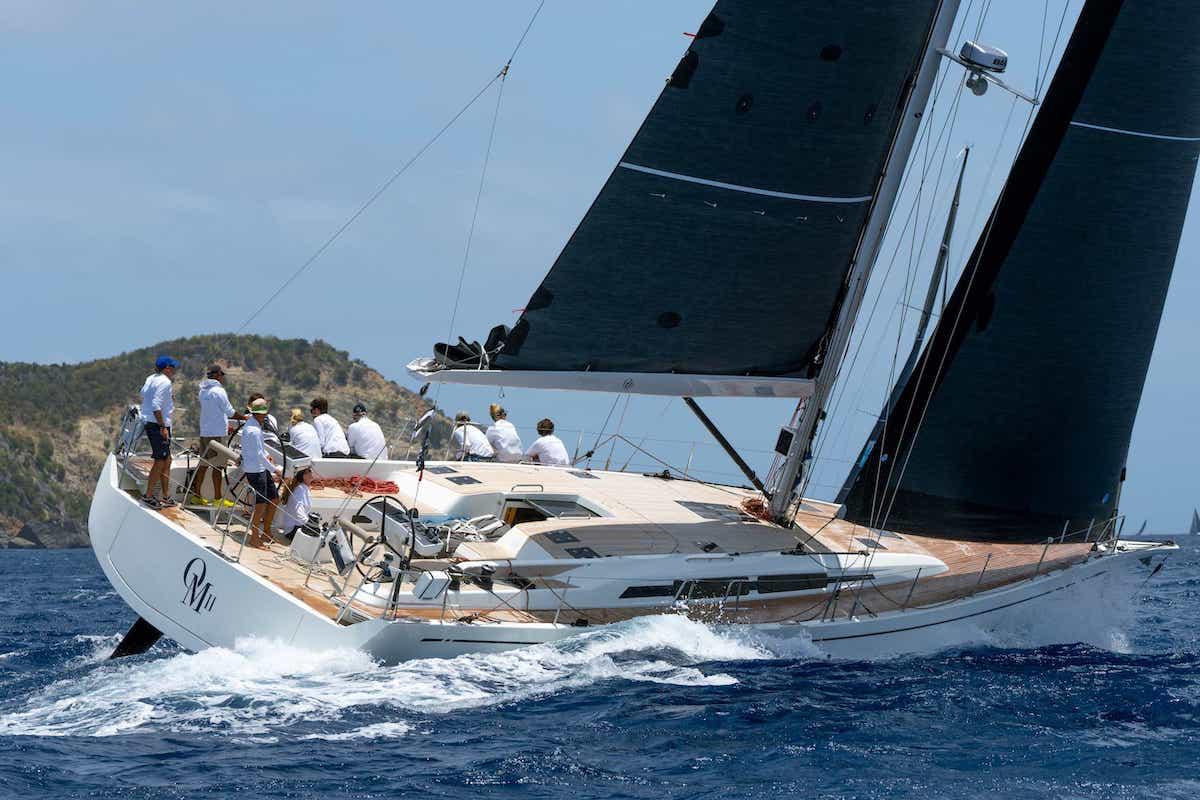
EVEN VOORSTELLEN: NIC BOL
EVEN VOORSTELLEN: NIC BOL
North Sails Expert
Nic Bol (56) geeft sinds 2017 als Sales Manager Benelux leiding aan de North Sails vestigingen in Nederland en België. Met zijn enorme zeilervaring in vele verschillende wedstrijdklassen, adviseert hij klanten om hen zo succesvol en plezierig mogelijk te laten varen. Zeilen is voor Nic een ‘way of life’.
Hoe is North Sails op jouw pad gekomen?
Mijn carrière in de zeilmakerij is gestart in 1993. Toentertijd heb ik agentschappen in Nederland opgezet voor het merk wat ik destijds vertegenwoordigde. Toen de productievestiging in 1997 van merk veranderde, ben ik met hen meegegaan en heb ik mijn eigen dealernetwerk opgebouwd in Nederland. In 2017 werden we benaderd door North Sails. Aangezien de missie en visie van North Sails op dat moment veel beter bij het team en mijzelf paste, hebben we besloten om van koers te veranderen.
Je bent zelf geen zeilmaker. Is dat een bewuste keuze?
Zeker! Mijn achtergrond ligt op het gebied van financial management. Waar ik goed in ben, is het verkopen van zeilen en het verzamelen van goede mensen om mij heen. Momenteel hebben we zowel in Rotterdam als in Antwerpen en Almere een topteam. Aan mij de taak om goed voor deze mensen te zorgen.
Wat is het leukste aan jouw baan?
Uit het meevaren met klanten haal ik de meeste voldoening. Het kost veel weekenden en het is vaak ook hard werken, maar wij hebben een zeer bevoorrechte baan. We brengen graag onze expertise over op onze klanten. Op die manier kunnen zij nog beter, sneller en plezieriger varen. Zij geven vaak veel geld uit, dus voor hen is dat heel belangrijk. Dat begrijpen wij en stellen ons als doel om mensen blij te maken.
📸 Sander van der Borch
Zeil je zelf ook nog weleens voor het plezier?
Met klanten varen is ook heel plezierig. Zo staat er een reis met een Swan 58 in het Caribisch gebied op de planning. Daarnaast verheug ik mij op het Europees Kampioenschap ORC in de Middellandse Zee, maar Laser zeilen blijft eigenlijk het leukste. Ik doe vaak mee aan de avondcompetitie op de Kralingse Plas in Rotterdam. De wind is daar meestal minimaal, maar dan is het juist de kunst om zo hard mogelijk te zeilen. In de Laser ligt het allemaal aan jezelf. Dit is echt de basis van het zeilen en dat maakt het zo leuk.
Wat is je mooiste zeilervaring?
Voordat ik de zeilmakerij in ging, was ik ‘gewoon’ professioneel zeiler. Ik heb regatta’s gevaren die als een reizend circus van Key West naar Japan trokken. In de grote klassen van toen, waaronder de one tonners, 50 voeters en J/47. We zijn twee keer Wereld Kampioen geworden in de J/22, waarvan de tweede titel het meest bijzondere was, aangezien mijn zoon ook meevoer. Ook in de X35 waren we heer en meester. Maar voor het eerst met North Sails ORC Wereld Kampioen worden in 2018, was tevens een mooi moment.
Wat is het beste (zeil)advies dat je ooit hebt gekregen?
Mijn vader zei altijd; werk om te leven, leef niet om te werken. Wij woonden in Zuid-Afrika en na een reis naar Nederland, waar mijn vader had gezeild met vrienden, kocht hij bij terugkomst in Kaapstad een toerboot van 22 voet. Het zeilen heb ik dus vanuit huis meegekregen en het was het beste ingrediënt om te kunnen voldoen aan dat advies van mijn vader. Ook al ben ik aan het werk, vaak voelt het niet zo. Toch verlies ik niet uit het oog dat andere zaken, zoals familie en vrienden ook belangrijk zijn. En dat geef ik ook mee aan mijn team.
READ MORE
READ MORE



















